What is a niche market? Understand the basics
Last updated
25 March 2024
Reviewed by
Why would you want to focus on selling to fewer people? Let’s dive into niche market advantages, examples, and why it’s a valuable business strategy.

Market analysis template
Save time, highlight crucial insights, and drive strategic decision-making

- What is a niche market?
A niche market is any group of customers that shares certain qualities. It’s typically a more focused, smaller segment.
A niche could be based on the target customers’ age, gender, location, profession, or interests.
The opposite of a niche market is a general or mass market. The mass market doesn't necessarily include everyone, but it encompasses a relatively large population segment.
For example, big box stores, fast food restaurants, and supermarkets all target the ‘mass market.’ Conversely, a niche market focuses on a smaller group of customers. These may include boutique furniture stores, vegan restaurants, and world food stores.
Niches may be large or small. For example, pet owners are a very large niche, while saltwater aquariums are a much smaller subset of the pet niche.
- What are niche market advantages?
Niche markets can offer businesses several benefits:
Allows for economical marketing
Marketing to a large audience can be expensive. Large companies that advertise on television or in mainstream magazines need to afford to target the mass market segment through this approach.
Niche marketing lets smaller businesses get more bang for their limited advertising dollars. Online advertising with pay-per-click (PPC) services such as Google Ads and Facebook Ads illustrate this.
PPC advertising uses keywords, which range from highly competitive to less competitive.
Niche marketing means businesses can often rely on lower-cost, low-competition keywords to generate traffic and engagement.
Less competitive than mass markets
One of the defining characteristics of niche markets is that they are less competitive than mass markets.
In some cases, competition may be minimal or even non-existent. Instances include introducing a new product type or starting a service in an extremely narrow niche.
On the other hand, businesses that target tiny niches must build brand awareness and educate potential customers about their products.
There’s also the issue of having a smaller pool of target customers, so companies need to generate more revenue per customer to make up for fewer customers.
Supports word-of-mouth marketing
Small and mid-sized businesses depend on social proof like referrals, reviews, and personal recommendations from friends and family members.
When you focus on a niche effectively, you can generate social proof without extensive advertising.
At the grassroots level, people respond better to the opinions of people they know and trust versus advertising and other paid marketing tactics.
Customers of niche products can be very enthusiastic, so they’re good candidates to leave reviews.
Allows for more personalized marketing
One advantage of marketing niche products is boosting brand loyalty by providing more personalized attention to customers and prospects.
You can devote more time to building customer relationships, like responding personally to emails and social media posts. Just be careful not to get into any heated arguments over your products—you don’t want to go viral for the wrong reason.
- Examples of niche markets
Here are some examples of niche markets:
Green and environmentally friendly consumers
As concern over environmental issues mounts, there’s a growing market for conscious, green, and environmentally friendly products.
Examples include:
Sustainable clothing
Eco-friendly cleaning products
Residential renewable energy, like solar panels
Buying locally
‘Green’ pet products
Pet owners represent a large niche that’s projected to get even bigger : Bloomberg predicts the global pet industry will reach $30 billion by 2030.
Because of its breadth and scale, businesses may have more success targeting smaller sub-niches within the pet sector rather than trying to build a product for mass appeal.
For example, they may target:
Specific types of pets, such as dogs, cats, fish, and horses
More specialized types of pet food, such as raw, insect-based, organic, or vegan
Unique pet accessories, such as clothing, toys, and cat/dog houses
Specialized products and services for training animals
LGBTQ+ consumers
The LGBTQ+ community is a growing sector. According to US Census data, it’s the nation's fastest-growing minority, with close to $1.4 trillion in buying power.
Products and services to target this niche include:
Fashion and accessories
Entertainment
LGBTQ+-friendly services in the hospitality industry
Travel continues to be a large niche that often overlaps with others.
After a pandemic-induced dip, travel spending has increased since 2021. The US Travel Association reports that air travel was up by 12% compared to a year ago.
Many products, services, and sub-niches can reach all kinds of travelers, such as:
Travelers interested in sustainability
LGBTQ+ travelers
Digital nomads
Luxury travelers
Budget travelers
People interested in cruises
Gaming is another sector with millions of passionate fans who spend freely on games and accessories.
According to Grand View Research , the global video gaming market was worth $217 billion in 2022, and it’s projected to grow more than 13% annually until 2030.
As with most niches, there are numerous sub-niches within gaming, like:
FPS (first-person shooter)
RPG (role-playing)
Word and puzzle
In addition to buying games, gamers also purchase real-life and in-game accessories.
RPGs like World of Warcraft and Second Life encourage players to purchase in-game items like weapons and clothing. Die-hard fans also purchase figurines, T-shirts, and limited collector editions.
Homeowners have a broad spectrum of needs and preferences.
These products and services are useful for homeowners, renters, and property managers:
Furniture and home decor
Yard and garden products
Indoor and outdoor lighting
Home security, including cameras, alarms, and security lighting
Window coverings, such as curtains, blinds, and shades
Insurance, like home insurance, renter’s insurance, and earthquake insurance
- Examples of brands selling to niche markets
The following are some examples of companies that have excelled at reaching a niche market.
Lefty's: Products for left-handed people
As the name suggests, Lefty's specializes in products for left-handed people. This is a significant yet often overlooked market, making up a little more than 10% of the population.
Lefty's sells left-handed products online and from its San Francisco store, including clothing, tools, utensils, office supplies, and more.
Aside from providing convenient products, Lefty's has a loyal following—it's one of the few businesses that caters exclusively to this market.
Ruffwear: Outdoor dog gear
Increasingly, dog owners like to take their pets with them everywhere, on hikes, bike rides, boating adventures, and other outdoor activities.
Ruffwear sells clothing, harnesses, safety lights, and other products to make it safer and more convenient for dog owners to take their pets on adventures.
With over 400,000 followers on Instagram, Ruffwear is tapping into a popular niche that isn't well served by other businesses.
The company has effectively combined two popular niches: Pets and outdoor gear. The principle of blending distinct niches in creative ways is something many businesses can apply.
Lush: Natural and handmade body care products
Lush taps into the growing market of consumers seeking natural and ethical beauty and body care products. Statista projects that the organic personal care products market will surpass $11 billion by 2025.
Lush offers handmade soaps, body care, skin, and hair products for people seeking alternatives to the typical mass-produced items in this industry. They also carry many holiday and seasonal products, which quickly go viral.
Lush has put its stamp on the very competitive beauty sector by offering unique products that larger companies cannot duplicate.
Kirrin Finch: Non-binary and LGBTQ-friendly apparel
Kirrin Finch makes clothing and accessories for the flourishing LGBTQ+ sector.
Their mission statement expresses the need to challenge traditional norms regarding menswear and womenswear. Creating a unique selection of gender-neutral apparel has allowed the company to reach a large, unserved market.
Glorious: Gear for gamers
The gaming niche is constantly growing and evolving. Glorious has leveraged this niche by offering a variety of accessories and gear to accommodate many types of gamers.
Their most popular products include gaming mousepads, lightweight gaming mice, and hot-swap keyboards that allow players to change keyboard switches.
They also offer specialized accessories and apparel, such as water bottles, hoodies, beanies, and t-shirts.
- How to reach a niche market
You’ve found a niche market, but how do you actually reach it?
Niche down from broader categories
Many niche markets are vast and competitive. Smaller companies can carve out a space by "niching down" and finding a specialty or sub-niche within a broader niche.
Online dating is a large niche with many sub-categories, such as dating for seniors, LGBTQ+, fitness-minded singles, and religious-based dating.
Identify keywords for your niche market
Keywords are an essential part of online marketing, whether you're creating paid ads or trying to rank content such as blog posts or videos in the search engines.
Keyword research is also useful for gauging the popularity of products and niches.
By searching for long-tail keywords, you can find less competitive terms, cheaper for PPC campaigns, and easier to rank for.
Research on social media
Social media provides a rich resource for finding niches and discovering what people are talking about and buying:
Large groups on Facebook can inform you about the size of a market.
Pinterest can show trending images and videos: Many pins are specific products.
See what large influencer accounts on Twitter and Instagram are discussing.
Check out hashtags across all platforms.
Study the competition
Unless you’re introducing a new product or service, you’ll have competition. Competitor research lets you see the size, popularity, and marketing strategy of other brands in your niche.
Carrying out competitor research is easy:
Explore competitors' websites.
Note their copy, visual style, and overall marketing approach.
Take note of their prices.
Read their customer reviews.
Browse their social media accounts.
Check out their videos on YouTube or TikTok.
See if they’re advertising on Google, Facebook, or elsewhere.
Explore fast-growing occupations
Studying data on jobs and fast-growing careers can also yield benefits for niche marketing.
Let’s consider the latest list of fastest-growing occupations published by the US Bureau of Labor Statistics . Topping the list is wind turbine service technicians, which illustrates the popularity of the renewable energy sector.
Gather statistical data
Collect data on all aspects of your niche market, which includes:
Size of the market, including projections for the future
Competitor data on the leading brands in your niche
The popularity of keywords and the bidding cost on PPC platforms
Study industry reports
What are the features of niche marketing?
Targets customers based on demographics , interests, spending power, or other criteria
Unlike mass marketing, niche marketing isn’t aimed at everyone
Niche marketers must focus on setting themselves apart and emphasizing their unique value proposition (UVP)
What is the difference between a target market and a niche?
A target market is about people, while a niche refers to products and services.
Your target market comprises your potential customers—the people you're marketing to.
A niche is the field or sector you’re serving.
Is Apple a niche brand?
People often ask whether certain brands cater to a mass or niche market.
Apple is an excellent example because it began as a niche hardware and later software company, targeting designers and higher-end consumers.
Arguably, as it evolved into one of the largest brands in the world, it became a mass-market company.
Is Amazon a niche brand?
Amazon has the qualities of a mass-market company and a niche marketing brand.
When it only sold books, it tapped into the new niche of online bookselling. However, Amazon now sells almost everything, making it a mass-market company.
However, it still employs niche marketing by targeting specific categories.
Apple, Amazon, and other companies show that the line dividing niche and mass marketing isn't always clear.
What are the criticisms of niche markets?
There are a few potential drawbacks to niche marketing. If the niche is small, your potential growth is limited. If it's a new market, educating your audience is the main challenge.
Get started today
Go from raw data to valuable insights with a flexible research platform
Editor’s picks
Last updated: 3 April 2024
Last updated: 26 May 2023
Last updated: 11 April 2023
Last updated: 22 July 2023
Last updated: 1 June 2023
Latest articles
Related topics, log in or sign up.
Get started for free

What is a Niche Market? And How to Find the Right One

We’ve all been there. You’re a customer searching for something specific, perhaps a bit unusual, but everywhere you turn, you’re faced with choices that appeal to more mainstream tastes.
Then, you find a store that sells exactly what you’re looking for. The relief, the gratitude you feel towards the store for finally scratching that itch.
I bet you’re expecting, even willing, to pay more for whatever you’ve been searching for, seeing as it’s been so hard to find. And, next time you need that product, it’s more than likely you’ll head back to the same store.
That’s the magic of a niche market in a nutshell. ✨
As a business, when you tap into the highly specialized needs of smaller segments within your target audience , you’ll open up a world of opportunity (and profit). And while those segments can be tricky to find, it’s really worth it.
Luckily, you’ve got Similarweb’s Digital Data to help you track down those elusive yet lucrative niche markets.
Let’s dive into the nitty gritty.
What is a niche market?
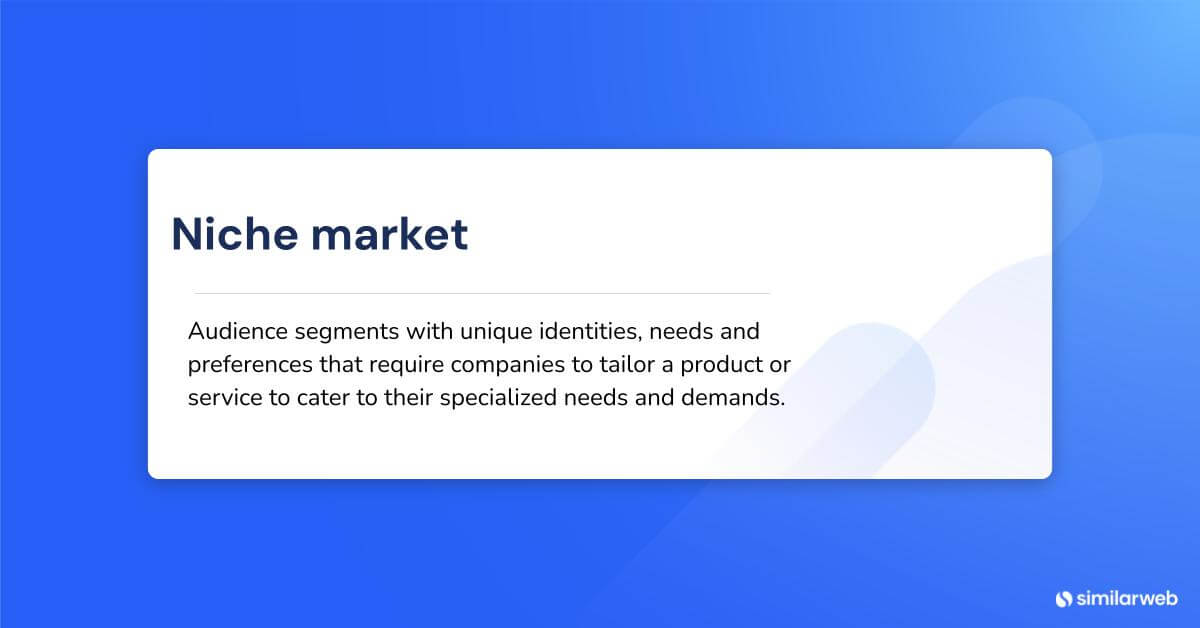
A niche market consists of specialist audience segments whose needs are not met by businesses marketing to the mainstream. They have unique preferences and identities and require companies and brands to tailor a product or service to cater to their specialized needs and demands.
Identifying a niche market often equates to identifying a gap in your market. When you discover a subset of customers who are not being fully satisfied by your offering, you can go about fulfilling those needs with an adapted product, or perhaps something new entirely. And, who knows where that can lead?
The key with niche markets is that the potential for profit lies not in how many you reach, but in how deeply you resonate with those you do, as well as how likely they are to come back for more. It’s about the power of becoming indispensable to a select few, as well as satisfying the majority.
The key benefits of a niche market
If we haven’t already made it clear why you should pay attention to the little guys, let’s talk about a few major benefits of targeting a niche market:
Less competition
Focusing on a specific segment of the market means fewer competitors vying for attention. This creates a less crowded landscape, making it easier for your brand to stand out and lead.
For instance, eyewear giant EssilorLuxottica faces minimal competition with its diverse product lines, including major brands like Ray-Ban and Oakley. With distribution in 300,000 to 400,000 stores worldwide, it dominates the global eyewear market. In order to compete in this space, other eyewear brands and distributors can still carve out market share by targeting smaller, more specific audience segments.

Customer loyalty
When a business tailors their offerings and messaging to a specific audience, they’ll also forge deeper connections with their customers.
A super-targeted approach is much more likely to resonate with them and send customer satisfaction and loyalty through the roof. People always appreciate when their unique needs are met.
Let’s look at Greenies, a pet care that sells healthy vet-recommended pet treats that pets love, including dental canine products, which saw 2.7M visits from organic search and 2.2M visits from direct traffic in 2023, up 28% year-over-year (YoY):
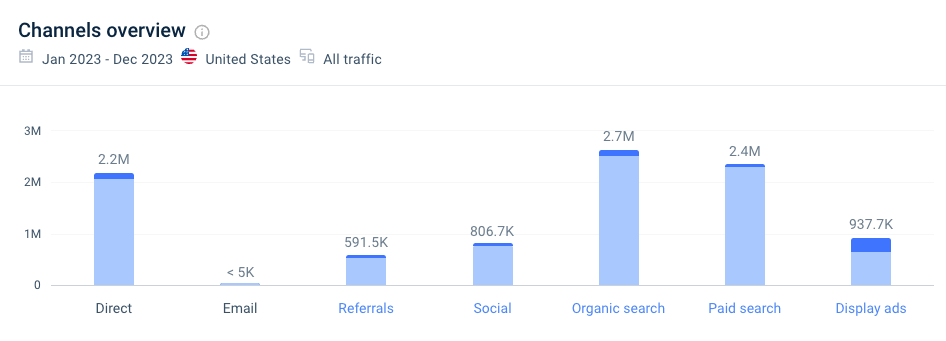
Higher profits
Due to their scarcity and uniqueness, specialized products designed for niche markets can often demand higher prices. The perceived value of these specialized offerings means that customers are willing to pay a premium for products that match their requirements.
For instance, Ulta, a leading beauty retailer, has strategically allocated sections on ulta.com for categories such as ‘Conscious Beauty,’ ‘Vegan,’ or ‘Clean’ makeup. This targeted approach facilitates consumer navigation, catering to niche preferences and fostering a willingness to invest in pricier products.
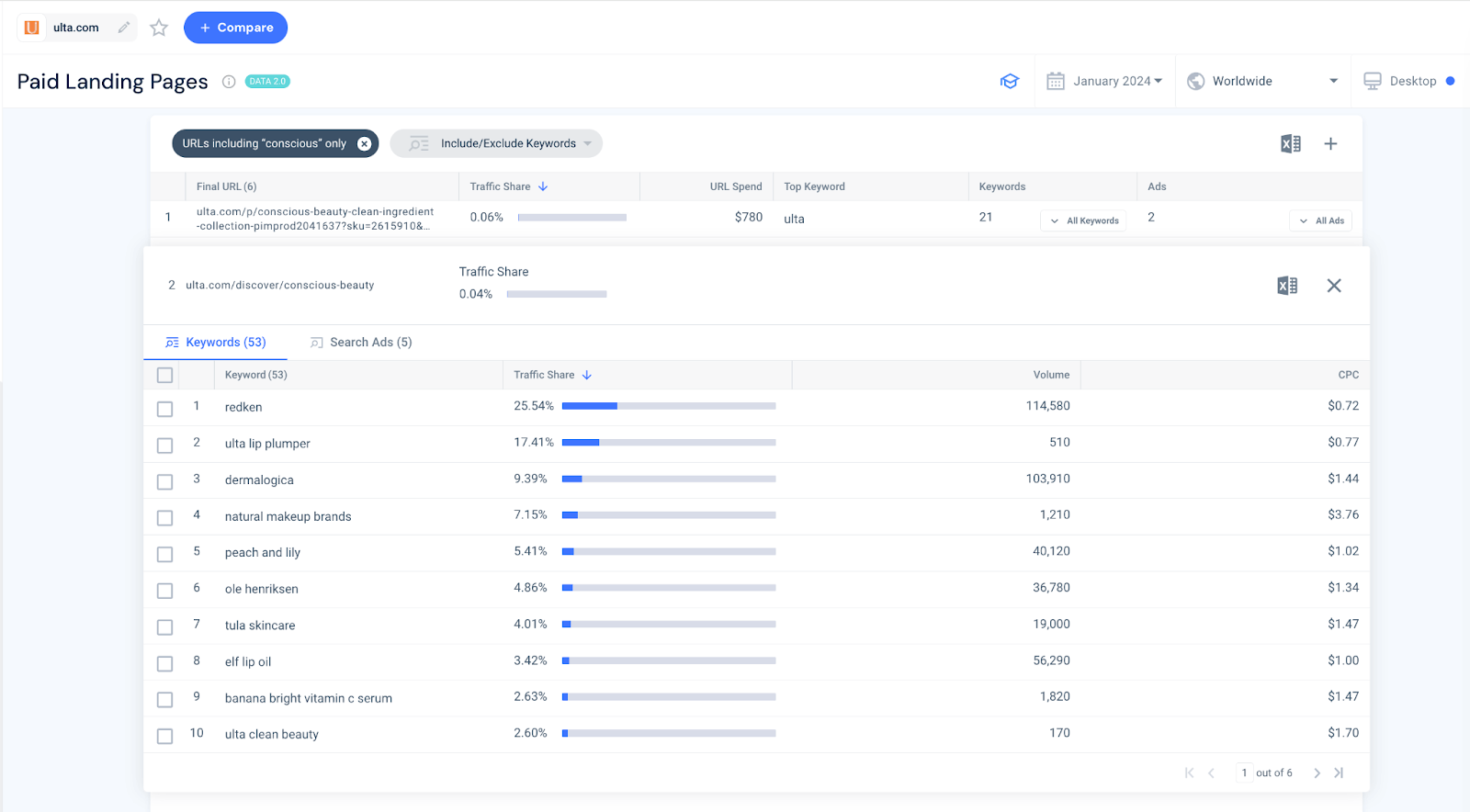
Laser-focused marketing
When targeting niche markets, their very nature means that you are forced to tailor your marketing efficiently in order to strike a chord with them. This focused approach can lead to a more effective allocation of resources and maximize the impact of marketing investments.
For instance, Prada Beauty exemplifies this with its targeted entry into the gaming space through a Candy Crush campaign, specifically aimed at younger tech-savvy audiences. This initiative yielded remarkable results, with sales soaring by up to 1,800% week-over-week . The mini-game, themed around the Prada Candy fragrance, not only engaged users but also drove traffic to prada.com by offering a free sample upon completion.
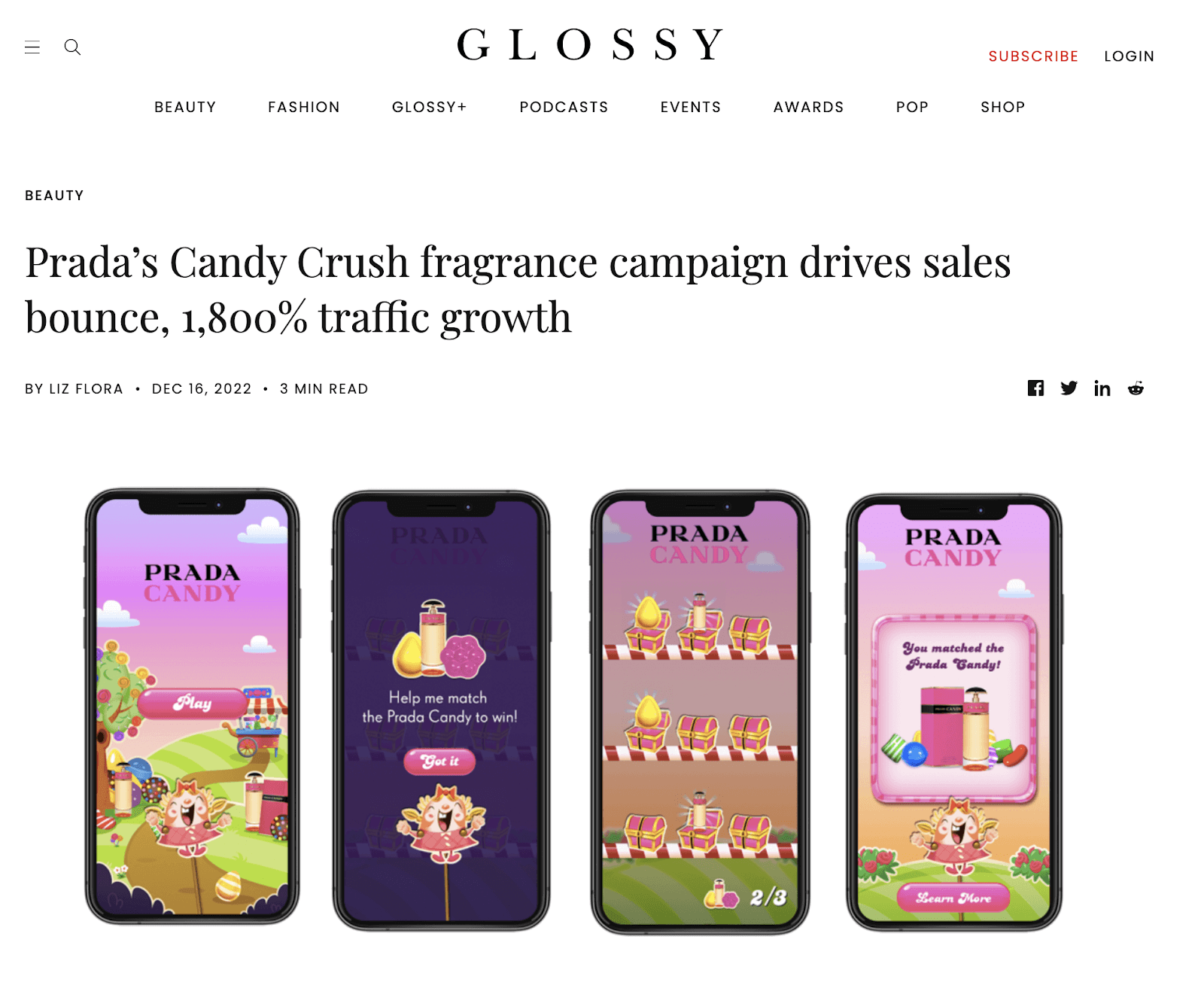
Opportunity for innovation
Meeting the needs of a niche market often encourages businesses to innovate in order to address specific needs and challenges. This can lead to the development of innovative and unique products or services that really set the brand apart from competitors.
Innovation is pivotal to a brand’s success. A notable example of a company that does this well is the Scandit Smart Data Capture Platform, which caters to businesses requiring intelligent data capture from barcodes, text, IDs, and objects. This platform empowers real-time, data-driven decision-making , engagement, and scalable workflow automation.
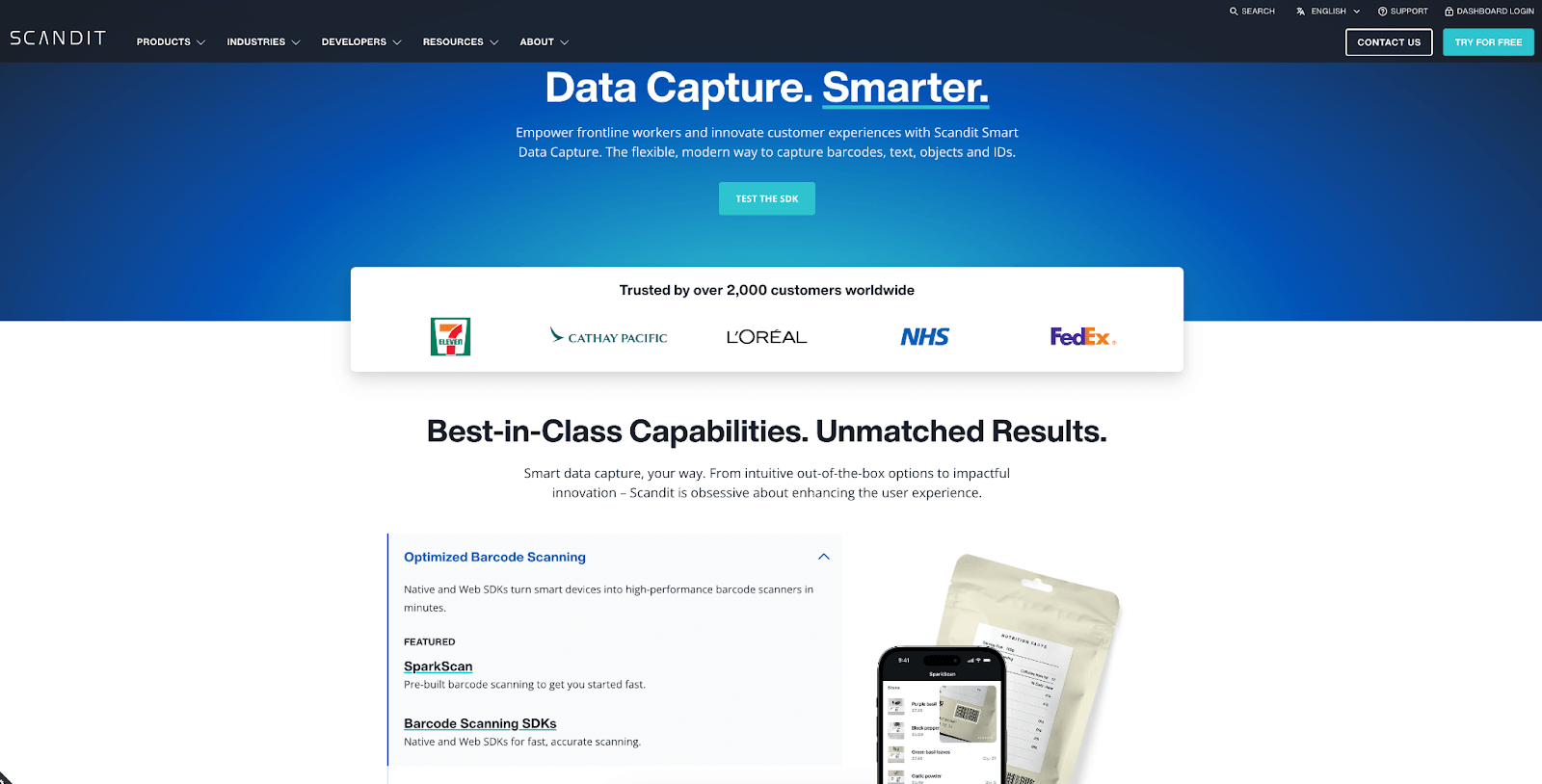
A data-backed example of a niche market
To further explain what a niche market is, let’s use an example from one of Similarweb’s recent consumer trend reports on the Financial Services sector .
Our report highlighted that digital banks like Revolut and Monzo – known as ‘challenger banks’ because they are going up against the traditional Big 4 – are edging their way in by catering to certain niche markets.
Their digital-first offerings align well with the needs of a younger, more tech-oriented audience that values convenience, transparency, and innovative features. These intuitive banking solutions help distinguish them from the larger traditional banking institutions which are generally slower to adopt.
Revolut takes it a step further than Monzo with its cryptocurrency and stock trading features – a niche within a niche.
Revolut users can buy, hold, and sell cryptocurrencies directly through the app, as well as invest in stocks, appealing to those interested in personal investing without the need for a separate brokerage account. This caters to an even broader niche of users interested in personal finance and investment beyond traditional banking services.
How to find a niche market: 7 expert tips
Building on the challenger bank example above, imagine you’re another contender aiming to disrupt an industry dominated by the Big 4. Much like Monzo and Revolut, your competitors have expanded their market share by targeting various gaps and niches within the banking sector.
To compete effectively, you must be able to identify and leverage these opportunities. Ideally, you’ll discover your unique niche audience , setting yourself apart from rivals. You can easily do this by using Similarweb’s range of market research tools . Here’s how:
Look at Similarweb’s ready-made industries
Similarweb boasts over 200 industries – and your niche may already be there. For example, as well as Finance, there are also subsectors like Banking and Credit , Insurance and Investing that you can delve into to find your niche audience.

Create a custom industry
Can’t find the right sector from our predefined list? Simply create a custom industry with Similarweb based on your research of the players leading in your current sector/niche. You can do this within Market Analysis:
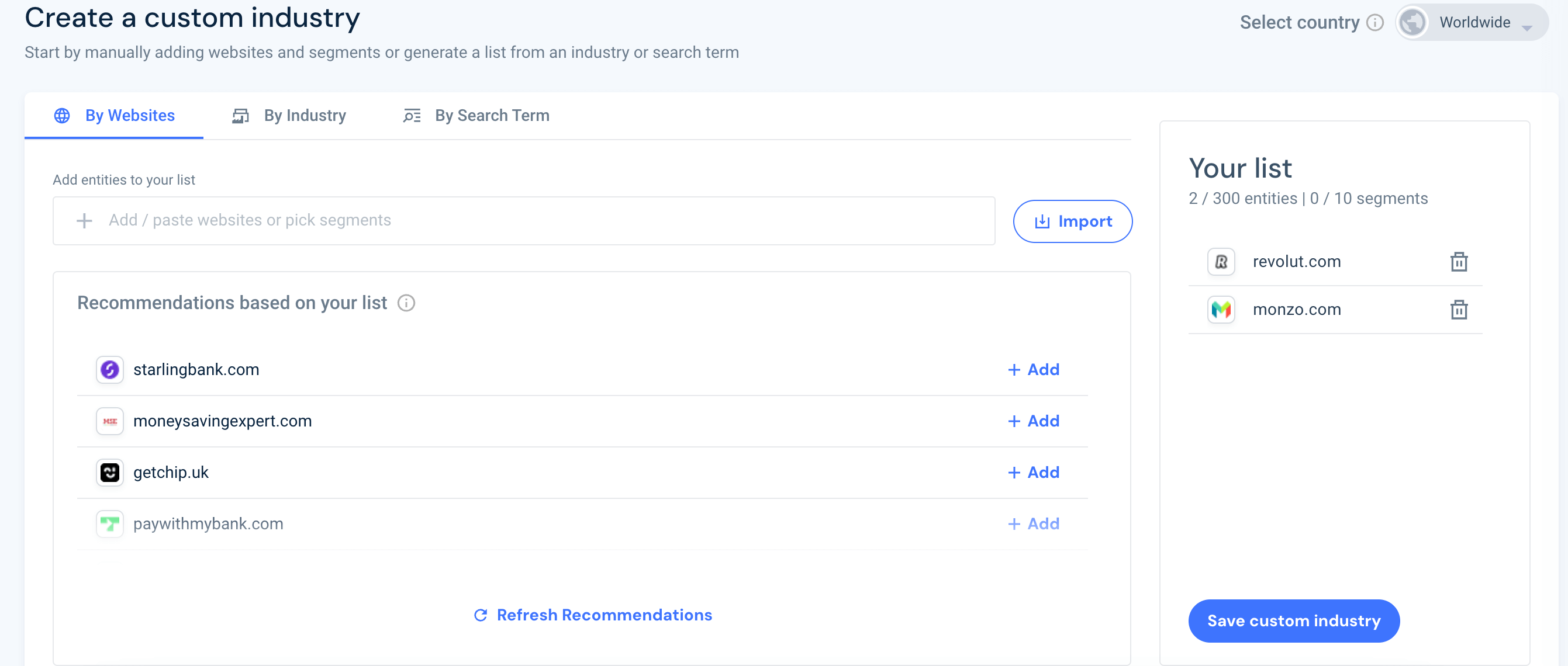
Here, we’ve added Monzo and Revolut to our ‘Challenger Bank’ custom industry as a starting point. The platform will offer recommendations based on these websites to help you add more relevant competitors to your custom industry.
Understand your market
Once you’ve got your industry down, the next step is getting an overview of your chosen market within Market Analysis .
For example, traffic to the Challenger Bank industry has increased by 13.5% in the last 12 months, leading up to March 2024:
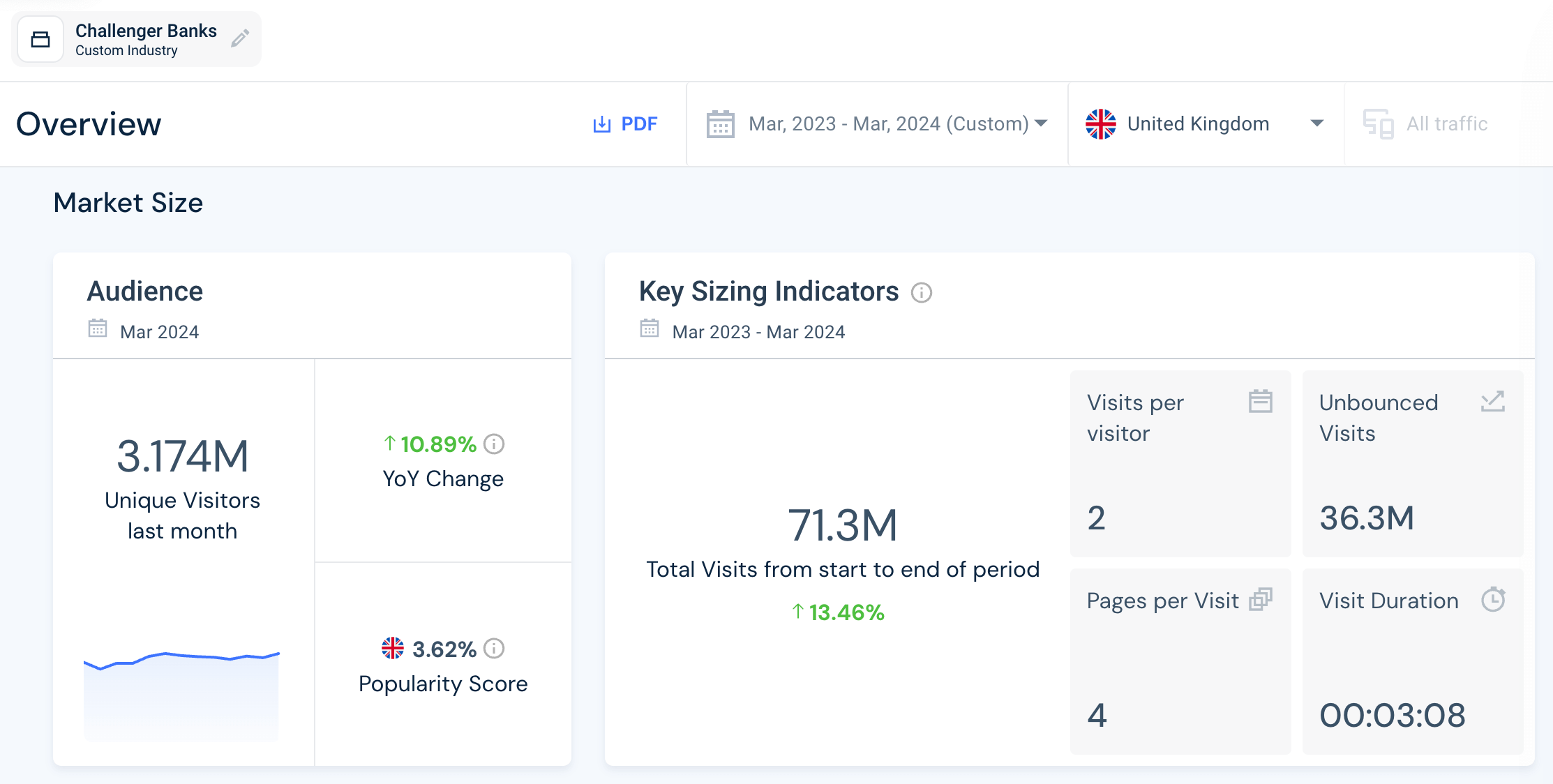
Here you can see that total visits were up 13.5% as compared to the previous year.
Check out which players are on the rise
Next, have a look at the ‘Rising players’ and ‘Declining players’ to get some insight into market dynamics and the impact of changing consumer preferences and emerging trends:

Some insights you can glean from these players to help you find a niche market include:
- Emerging trends and consumer interests: Rising players often succeed because they tap into emerging consumer interests or fulfill unmet needs within the market. Identifying what these new entrants are offering can reveal the most current trends and preferences within your target audience.
- Innovative business models or technologies : Similarly, the rising players may be using innovative business models and technologies that differentiate them from the competition and make them appeal to niche market segments. Analyzing these further can inspire new ways to reach them.
- Keyword and content strategies: Look into the keywords, content, and SEO strategies that are driving traffic to these rising websites. This can indicate what topics or products are currently resonating with the audience and may highlight niche areas not yet saturated.
For example, Tandem is the top-rising player here. Analyzing tandem.co.uk further reveals that they target several niches within banking – chiefly sustainable and digital banking – which are very current and trending topics. We also know that these topics appeal most to the younger, tech-savvy generations, which could indicate an audience you need to start targeting.
Head to our Website Analysis tool and dive deeper into each rising player to uncover the trends and consumer interests that they are capitalizing on. To catch what’s trending, check out their top keywords and spot terms and topics that are driving the most traffic to their site:
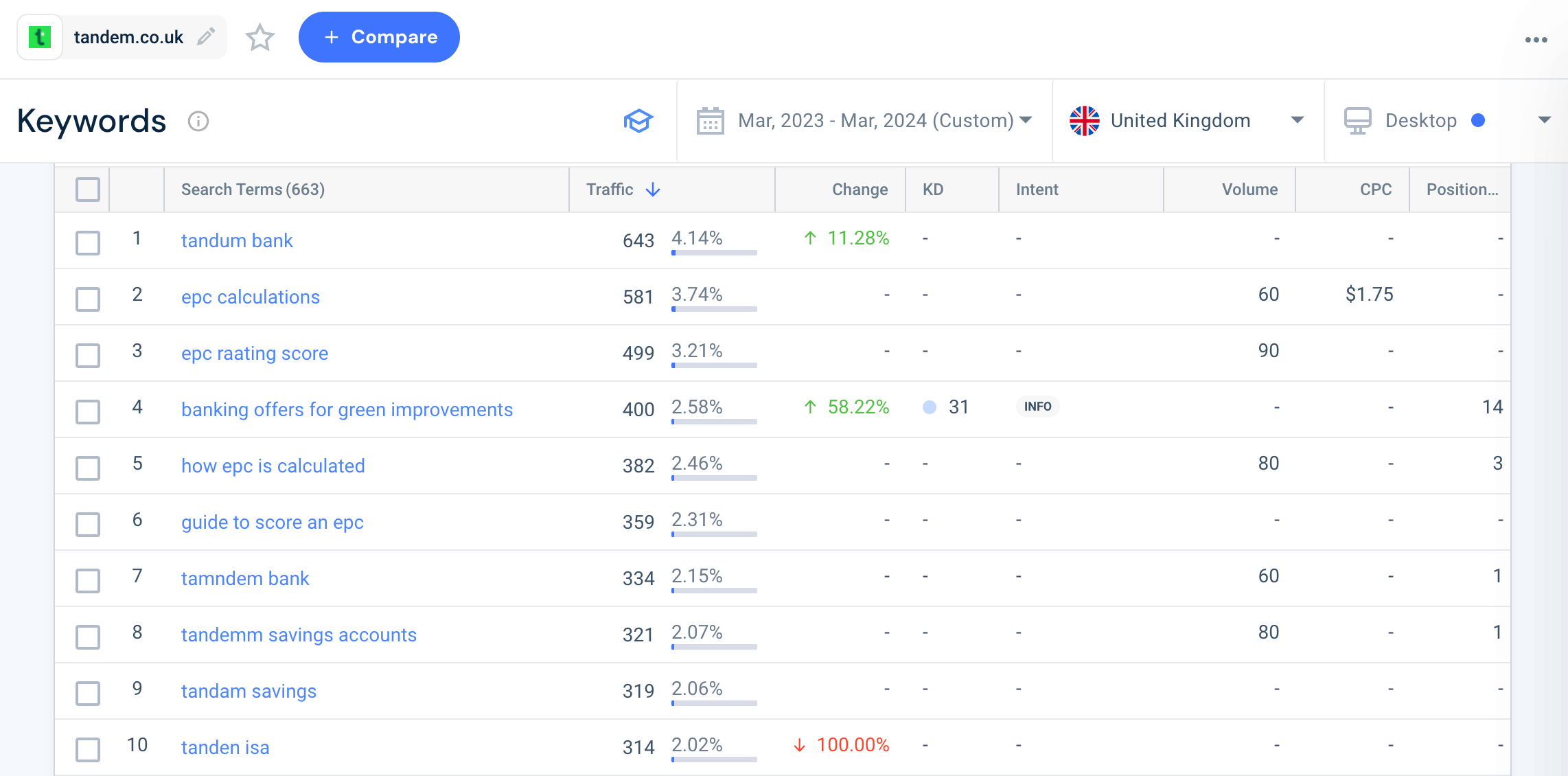
Here, by looking at Tandem’s top organic keywords, we can see that their traffic from the search term ‘banking offers for green improvements’ has increased by 58.2% since last month. This shows a growing interest in green banking solutions for Tandem.
Dive into audience demographics
Analyzing the age distributions and gender split of a group of websites in the same industry can provide important insights into consumer behavior, preferences, and potential market niches.
You can find this audience demographics data for the Challenger Banks industry under Market Analysis, where you get a clear overview of their core audience over the last 12 months:

For example, the 25-35 age cohort clearly dominates here, but when you compare the data to 2022-23, there is a slight increase in audience engagement within the 18–24-year-olds, while the other age brackets remain stable. Once again, this signals a growing younger audience to target in the near future.
Look for untapped global markets
Within Market Analysis, you can also look into the geographical data of your chosen industry to spot where markets are growing or declining. This helps you surface new emerging markets as quickly as possible:
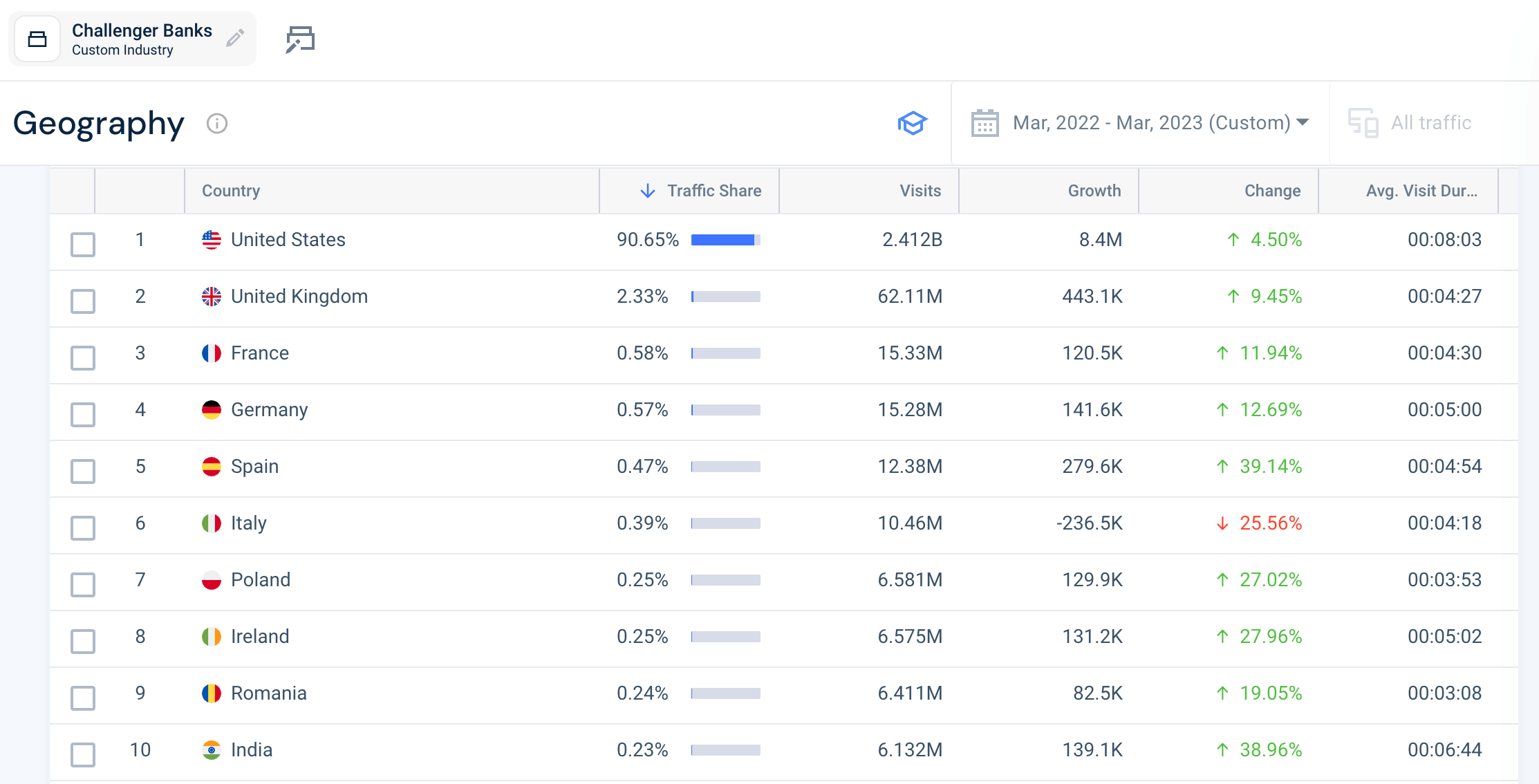
While in this example, the US market currently has the majority of traffic share , we can see other countries like Spain (up 39%), Ireland (up 27%), and India (up 38%) are potential niche markets to keep an eye on. Also, take note of those that are declining or growing slowly so you can make the most lucrative business decisions.
Track growing demand in your industry
As a last step, analyze a curated keyword list within Similarweb’s Demand Analysis feature to spot key terms that are quickly gaining traction in the Challenger Banks industry.
Create your keyword list within Demand Analysis to get insights on search trends based on these carefully selected keywords. To help you build your keyword list, use Similarweb’s Keyword Generator for inspiration. Be sure to check the ‘trending keywords’ tab for the freshest data:
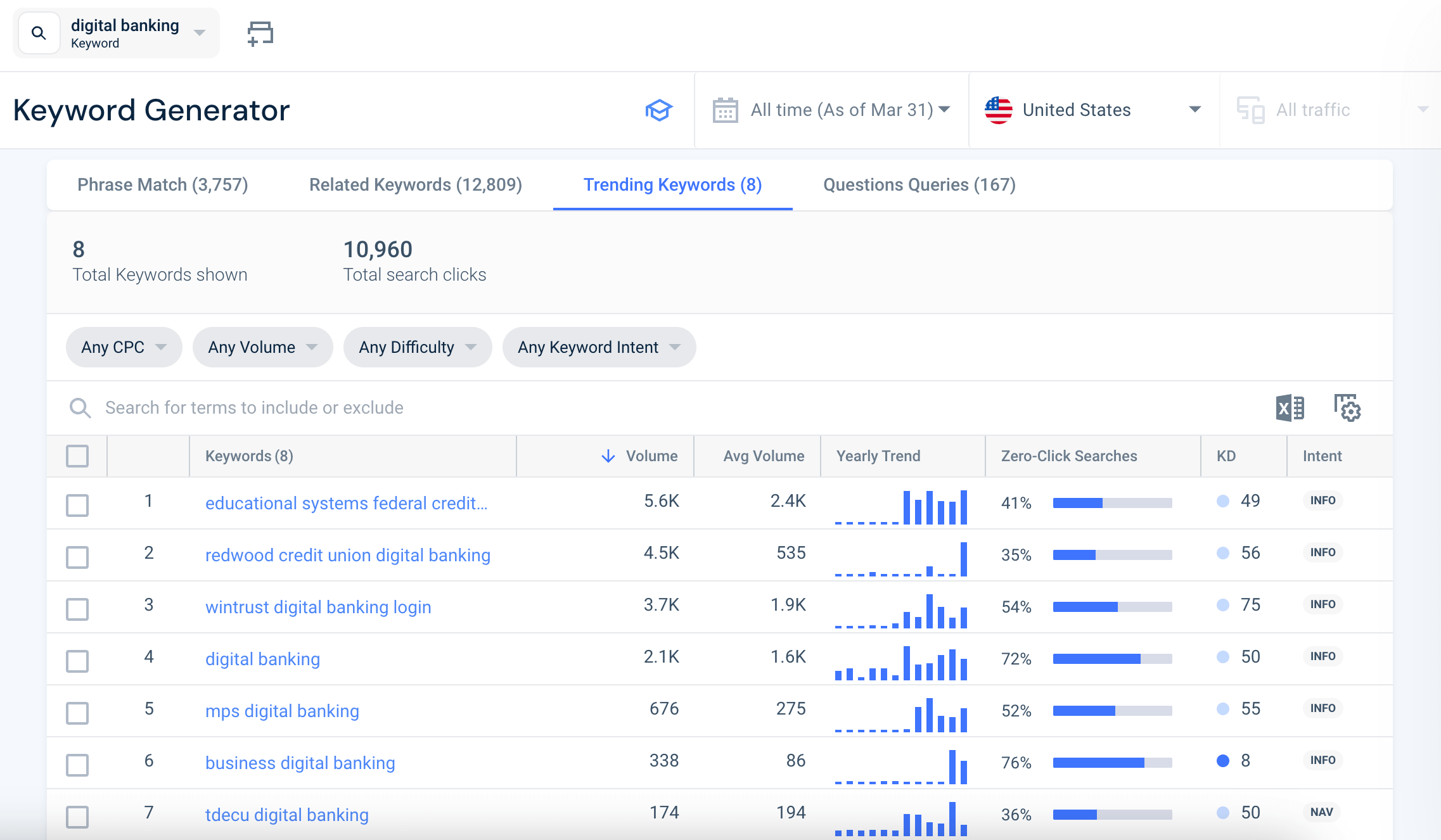
Here, we can see that ‘digital banking’ and ‘business banking’ are on the rise. Business banking, particularly for small businesses, is a lucrative niche to target in today’s economic landscape, where both consumers and businesses are feeling the pinch of inflation.
In Demand Analysis, data will be generated based on your curated keyword list:
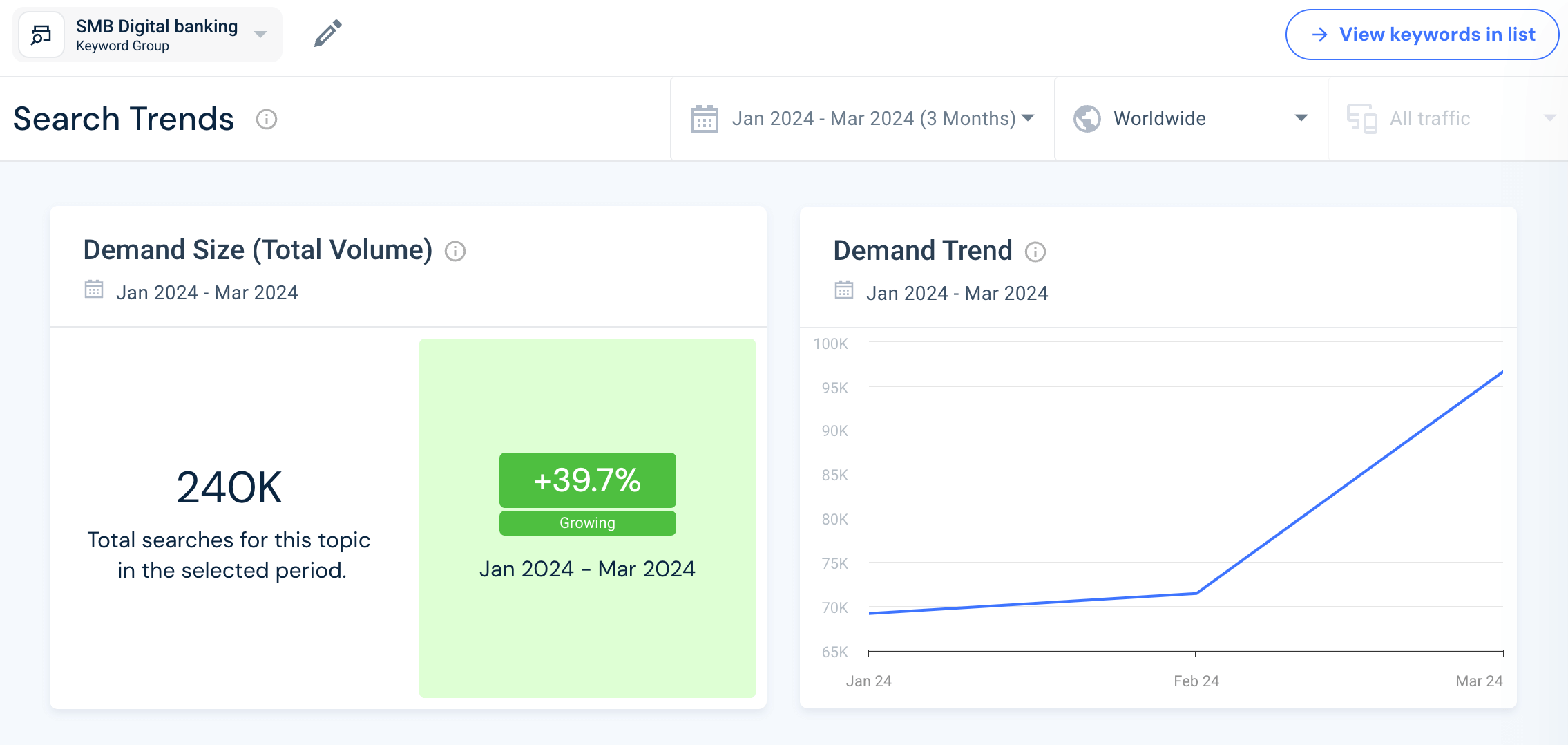
Here, you can gauge whether demand for these key topics is growing, stagnating, or declining, and see the demand trend over time.
Use the ‘comparison mode’ under date range to compare data to a previous period, so you can see the increase or decline in demand. For example, this is a comparison over consecutive three month periods:

Demand for SMB-related banking keywords has increased by almost 24% during this period, with searches on these topics rising from 191k to nearly 240k.
As a final step, check out the Keyword Trends graph to see which keywords are driving these trends over time:
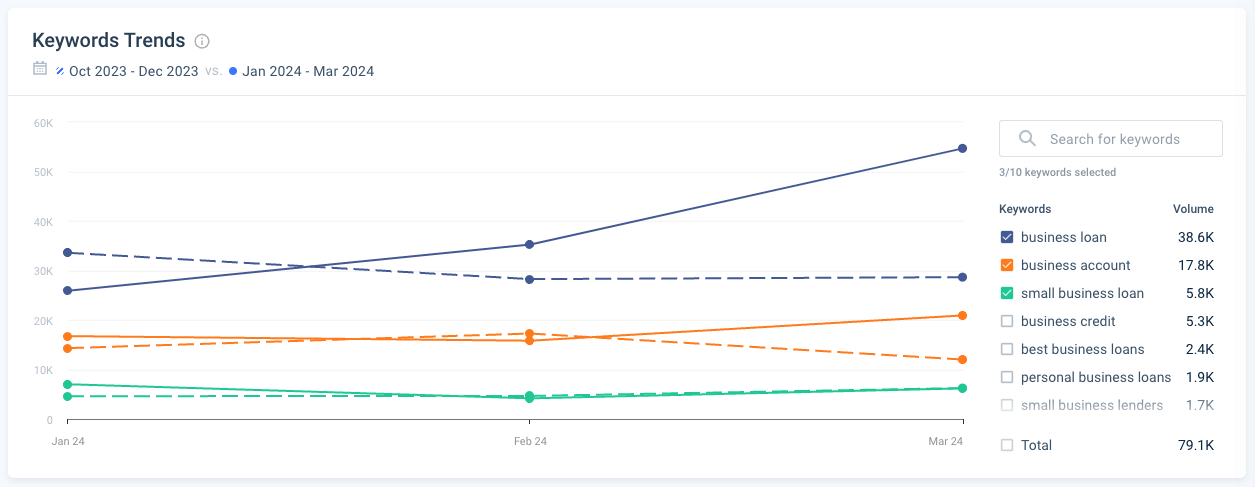
Take note of the keywords’ search volume and trend over time to gauge whether they are on-the-rise opportunities to capitalize on.
And you’re done! By following these steps, you’ll find lots of potential niche markets to explore and begin targeting. Happy digging!
A final thought on niche markets
We’ve explored the world of niche markets and uncovered the huge impact that catering to specific, specialized segments of a broader market can have on a business’s success.
Niche markets represent a unique opportunity to serve an audience whose needs are often overlooked by mainstream providers. By focusing on these specialized segments, businesses not only fulfill unmet needs but also build a loyal customer base willing to pay a premium for products and services that resonate deeply with their specific preferences and requirements.
Similarweb can help you uncover these lucrative niche markets. With its comprehensive digital data and analytics, Similarweb helps identify trends in the market, analyze demand, and understand consumer behaviors within specific industries.
By leveraging Similarweb’s market research tools, you’ll pinpoint emerging niche markets, track rising players, and optimize your marketing strategies to target these specialized segments effectively.
Find your niche market
With the most up-to-date data in the world.
A niche market is a specialized segment within a broader market, characterized by unique preferences, needs, or identities that mainstream businesses typically do not address. These markets often require tailored products and services to meet specific consumer demands.
What’s an example of a niche market?
An example of a niche market could be digital banks operating within the larger financial sector targeting younger, tech-savvy consumers with their digital products. This niche market values transparency, convenience, and innovative features such as cryptocurrency trading and app-based budgeting tools. These digital banks differentiate themselves by meeting these specific needs that are often overlooked by or slow to adopt by larger banks.
What are the benefits of targeting a niche market?
Targeting a niche market has several benefits, including less competition, which makes it easier for brands to stand out and capture consumer attention. It also fosters deep customer loyalty by focusing on specific needs, leading to repeat business and higher customer retention. Additionally, niche products often command higher prices due to their specialized nature, contributing to greater profitability.
How do I find a niche market to target?
You can find a niche market by using market research analytical tools like Similarweb to conduct thorough industry research, identify existing markets, and analyze market trends and consumer behavior to uncover gaps and opportunities within the market. You can also look at rising market players to gauge emerging trends and preferences, and utilize SEO and keyword analysis to understand what drives traffic and interest in these niche areas. Additionally, exploring demographic and geographical data can help pinpoint where potential customers are located and what specific characteristics they share.
Related Posts

The Future of UK Finance: Top Trends to Watch in 2024

From AI to Buy: The Role of Artificial Intelligence in Retail

How to Conduct a Social Media Competitor Analysis: 5 Quick Steps

Industry Research: The Data-Backed Approach

How to Do a Competitive Analysis: A Complete Guide

How to Check Website Traffic: Analyzing the Digital Data
Wondering what similarweb can do for you.
Here are two ways you can get started with Similarweb today!

What is a Niche Market? Examples, Benefits & How to Find One
Published: January 02, 2023
There are two paths for entrepreneurs . You can either serve the mass market or a niche market. Entrepreneurs who serve a mass market usually create many products or serve multiple industries. However, they struggle to become the market leader for each of their offerings.

This is different for entrepreneurs in a niche market. These entrepreneurs create specific products or serve specific audiences. Besides allowing you to narrow your scope, serving a niche market helps you gain more credibility and become the go-to brand for your audience.
In this post, you’ll learn about the benefits of niche markets, how to find your niche, and what to do after you identify an unmet need.
What is a niche market?
Benefits of a niche market, how to find a niche market, niche market examples, find your lane in a niche market.
A niche market is a focused set of people or businesses who want to purchase a specific offering. Think of niche marketing as the act of specializing in what you provide.
.webp)
Free Business Plan Template
The essential document for starting a business -- custom built for your needs.
- Outline your idea.
- Pitch to investors.
- Secure funding.
- Get to work!
You're all set!
Click this link to access this resource at any time.
When your company offers specific products and services instead of a wide variety of offerings, you benefit by saving money and becoming more productive. You’ll also build a comparative advantage over competitors who are generalists.
For example, in the pet industry, there are animals like dogs and cats. Creating a business that sells dog collars is a niche market. The same applies to cat sweaters and pet GPS trackers.
When companies decide to sell to a niche market , they attract more customers to their product or service. Let’s look at some benefits of operating in a niche market.
Whether you’re starting or scaling a business, niche marketing is an effective way to establish your brand positioning . Here are some other benefits that niche market entrepreneurs enjoy.
Effective Use of Marketing Resources
By focusing on a small audience, you can use your resources to find customers who align with your product. These people need your product the most and are most likely to convert.
Niche marketing also helps you save on your marketing and advertising budget. That’s because a highly targeted audience means you’ll have fewer buyer personas . You can spend efficiently, targeting specific types of prospects.
More Social Proof
Aligning your products or services with a small group of customers is an excellent way to encourage word-of-mouth marketing and positive reviews. This form of social proof is powerful. Recommendations can carry your business into a larger, potentially more profitable market.
Mass markets often evolve from niche markets. So while you’re starting small today, consider the big picture, and start building the foundation that’ll help you succeed on a grand scale.
Less Competition
Operating in a niche market means you’ll deal with less or no competition. Many companies or individuals like to serve many customers. By going narrow, you’ll offer a specific product that’ll eliminate many companies from your customers’ radar.
That said, there may also be fewer customers looking for your product or service. So you’ll need to enter a niche market that has an adequate audience.
Increased Brand Loyalty
Niche marketing allows individuals and businesses to improve brand loyalty. Engaging with fewer people means you’ll find it easier to nurture prospects and build quality relationships. Your audience will know that you understand their vibe. They’ll see you as a true partner, rather than a vendor who’s only interested in their money.
- Reflect on your passions and interests.
- Identify the problems and needs of your customers.
- Research the competition.
- Define your niche and its profitability.
- Test your product or service.
1. Reflect on your passions and interests.
Is there a hobby or skill you're passionate about or good at? Take some time to reflect on those areas of interest as potential niche market ideas.
Below are a few questions to help you brainstorm:
- What skills come naturally to me?
- How do I approach problem-solving?
- What topics do I enjoy learning about?
- How do I enjoy spending my free time?
- Do friends, family, and colleagues request my advice on a specific topic?
Writing your answers to these questions will help you identify your core strengths. This allows you to build on a niche market idea you already love.
2. Identify the problems and needs of your customers.
Now that you have some niche market ideas, think of the problems faced by your target market. Can your passion or interest meet your customer needs ? Do you know their motive to buy?
Conducting market research will help you determine the buying behaviors and challenges of customers.
There are a variety of tools (including free ones) for exploring your customer persona . Using them gives you a better idea of how your business can provide value to your niche market.
3. Research the competition.
Before devoting your time and energy to developing a brand-new business, research your potential competitors . You might have a viable product idea, but how many other businesses will you be competing with?
This is where research tools come in handy. Let’s explore some of them.
Exploding Topics
Exploding Topics is an excellent tool that allows entrepreneurs to find emerging trends before they take off. Here’s how it works.
Let’s say you’re interested in the beauty niche. To find emerging trends, you’ll visit explodingtopics.com and use the “All categories” filter. Once you click “Beauty,” you’ll get a result like this.

From there, you can see your competitors in that market and find your own way to shine.
Google Trends
Let’s say “Bakuchiol” from the beauty trends interests you. A competitive research tool like Google Trends helps you know how frequently people search for this term.
As you can see below, the interest in the term has been growing steadily since 2017 in the U.S.

Image Source
With this data, you can get an idea of market size and demand.
Answer the Public
To find a market around your search term, use a tool like Answer The Public to find a niche for different product categories.
For instance, if we enter “Bakuchiol for” in Answer The Public, we’ll see 331 results like bakuchiol for acne, body, blackheads, breastfeeding, skincare, and face.

Each result provides a niche opportunity for you to explore.
Ubersuggest
But before going all-in on any keyword, use a free keyword research tool like Ubersuggest to get a detailed overview of each term.
For instance, when we plug in “bakuchiol for acne,” we see it has a high-paid difficulty and moderate cost per click.
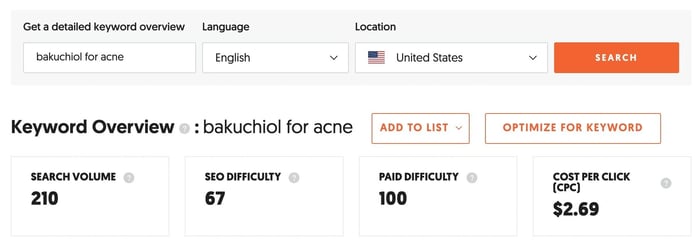
Other tools to use for competitor research are:
- Google Keyword Planner
Use these tools to explore the best-selling products consumers are researching and see if your new business can meet their needs.

Free Marketing Plan Template
Outline your company's marketing strategy in one simple, coherent plan.
- Pre-Sectioned Template
- Completely Customizable
- Example Prompts
- Professionally Designed
4. Define your niche and its profitability.
If you’re dedicating your resources and time to a new business, it should have the ability to become profitable. Here are a few factors to consider when finalizing the niche you’ll cater to:
- Product quality. Is your product handmade, eco-friendly, or premium?
- Price. Do you want to sell luxury items or will you price them moderately?
- Customer location. Where is your target audience? Are they in a certain country or region?
- Customer values and interests. Are you targeting vegans, environmental enthusiasts, travelers, or sports lovers?
- Customer demographics. Are you selling to straight folks or those in the LGTBQ+ community? What’s their age range, education, and income level?
Your idea could be profitable if you research the market and discover similar products, but few companies sell them.
Look at the price points of competitor products so you can price yours competitively.
Resources like Amazon (for products), G2 (for software), agency directories (for services), and PRICEFY.IO (for price monitoring) are helpful in evaluating competitor pricing and determining prices for your products and services.
5. Test your product or service.
Create a simple website or landing page for your business so customers can find you. Offer a trial period of the product or give out free samples to your target customers. This initial test period should not cost a large amount of money. However, you can certainly use paid ads to drive traffic to your website.
See if people want to put money towards your product with crowdfunding sites . Not only can you gain funding, but you’ll also get your product in front of potential customers.
If the test is not as successful as you hoped, don’t scrap your idea entirely. Go back to the drawing board and find key areas where you can improve your product or marketing.
If you’re wondering what a niche business looks like, below are seven examples of businesses that cater to niche markets.
- Georgetown Cupcake
- The Container Store
- Kirrin Finch
1. Georgetown Cupcake : A bakery that only bakes cupcakes.

After leaving their corporate jobs, sisters Katherine Kallinis Berman and Sophie Kallinis LaMontagne pursued their passion for baking and opened up Georgetown Cupcake. Unlike other bakeries that create cakes and other sweets, their sole product is cupcakes, and they were able to perfect their recipes by focusing on one product type.
2. The Container Store: A store that only sells containers.

Instead of offering a variety of home products such as furniture, textiles, and artwork, The Container Store focuses on selling compartments — large and small enclosed storage containers where consumers put their stuff.
Sure, customers could go to a convenience store to buy storage, but there’s a good chance they won’t find the exact container that fits the space and aesthetic of their cupboard.
The Container Store fills that void (literally) and the business has turned a healthy profit within this market.
3. Drybar: A hair salon that offers blowouts, no cuts or color.

The market size of the Hair Salon industry in the US was a whopping $48.3 billion in 2022. There’s certainly enough for entrepreneurs who want to provide specific services in this industry. That’s why Drybar only offers blow-drying and styling services. To give customers some variety, the salon offers a few hair-styling options . What sets Drybar apart is its unique concept of focusing on one thing and being the best at it: Blowouts.
4. SoulCycle: A workout studio that only offers indoor cycling classes.

SoulCycle is a 45-minute indoor cycling class that sets itself apart from competitors by only offering one specialized spin class. Other fitness studios don’t compare to the community of dedicated cyclers who spend hours working out at SoulCycle.
5. Ties.com: A clothing store that sells men's accessories.
Global revenue in the men’s apparel market was $499.80 billion in 2022 . The US alone had $100.5 billion. This amount proves the gigantic potential of the menswear market, allowing Ties.com to create a niche market that sells specific products.
In the broader market of menswear, Ties.com stands out by only selling accessories like ties, socks, pocket squares, and wallets. Since their products make up a small portion of the menswear industry, they stand out from the competition because they can focus on creating unique, high-quality accessories.
6. Dorm Mom: Laundry service for college students.
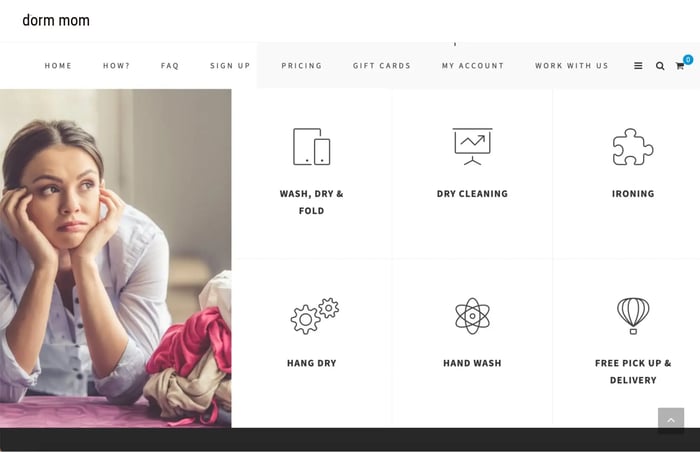
According to Grand View Research , the global dry-cleaning and laundry services market size could reach $79.91 billion by 2027. People can easily carve a niche in this industry by providing laundry services for kids, men, women, LGBTQ communities, students, and the list goes on.
Dorm Moms adopted this approach by focusing on a specific audience. Rather than cater to a large population of people in need of laundry service, Dorm Mom serves only college students.
7. Kirrin Finch: A LGBTQ+ clothing brand.

The spending power of the LGBTQ community is about $1 trillion in the U.S. alone. This is an excellent market for brands that stand with this community. The connection is even stronger when LGBTQ founders lead the brand. This is the case for Kirrin Finch, an LGBTQ clothing line.
Led by Kelly and Laura Moffat, Kirrin Finch provides individuals in the LGBTQ community with bespoke suits and button-up shirts for weddings, workwear, or just to look your best any time.
By specializing your products and services in a narrow market, you’ll better use your resources, produce products faster, and develop a loyal customer base. Selling to a niche market can be a short- or long-term strategy — the key is finding your audience and tailoring everything you do just for them.
Editor's note: This post was originally published in October 2018 and has been updated for comprehensiveness.

Don't forget to share this post!
Related articles.

A Complete Guide to Successful Brand Positioning

70 Small Business Ideas for Anyone Who Wants to Run Their Own Business
![what is market research niche How to Start a Business: A Startup Guide for Entrepreneurs [Template]](https://blog.hubspot.com/hubfs/How-to-Start-a-Business-Aug-11-2023-10-39-02-4844-PM.jpg)
How to Start a Business: A Startup Guide for Entrepreneurs [Template]

Door-to-Door Sales: The Complete Guide

Amazon Affiliate Program: How to Become an Amazon Associate to Boost Income
![what is market research niche How to Write a Business Proposal [Examples + Template]](https://blog.hubspot.com/hubfs/how-to-write-business-proposal%20%281%29.webp)
How to Write a Business Proposal [Examples + Template]

Product Differentiation and What it Means for Your Brand

The 25 Best PayPal Alternatives of 2023

The First-Mover Advantage, Explained

Intrapreneurship vs. Entrepreneurship: What's the Difference?
2 Essential Templates For Starting Your Business
Powerful and easy-to-use sales software that drives productivity, enables customer connection, and supports growing sales orgs
- Online Degree Explore Bachelor’s & Master’s degrees
- MasterTrack™ Earn credit towards a Master’s degree
- University Certificates Advance your career with graduate-level learning
- Top Courses
- Join for Free
What Is a Niche Market? And How to Reach One
In this article, you will learn all about niching down to reach a unique market, where you can position yourself as an expert and how to do that through researching customer behaviour, trends, and analytics.
![what is market research niche [Featured Image] Two women work at a laptop in an office.](https://d3njjcbhbojbot.cloudfront.net/api/utilities/v1/imageproxy/https://images.ctfassets.net/wp1lcwdav1p1/3g0Rfl9blg5xcKc6FHJoBL/c4844755a3d783bb7b893ec972f741e2/GettyImages-648946918.jpg?w=1500&h=680&q=60&fit=fill&f=faces&fm=jpg&fl=progressive&auto=format%2Ccompress&dpr=1&w=1000)
A niche market can be defined as a segment of consumers who share characteristics and, because of those characteristics, are likely to buy a particular product or service. The consumer characteristics you would examine fall under three main categories: demographic, psychographic, and firmographic.
Demographics are specific socio-economic factors such as age, ethnicity, or income level. Psychographics are behaviours, attitudes, aspirations, and other psychological factors. Firmographics are factors used to characterise the operations of businesses and organisations, and can include the industry type, organisation size, and revenue.
Niche markets comprise small, highly specific groups within a broader target market you may be trying to reach.
Identifying a niche market and learning everything you can about it enables you to do several things:
Develop products and services that meet your niche’s unique needs and desires
Show empathy for and connection to your niche through your marketing messaging
Build trust with your niche and turn them into loyal customers
Compete with larger brands
Become a credible “go-to” brand for the specific solution you provide, and ultimately attract more customers
Now that you have a clear definition of what a niche market is and why identifying one is important, let’s take a look at some niche market examples and steps you can take to find yours.
Aspiring novelists
Think of aspiring novelists as a smaller segment of writers in general. Aspiring novelists might share some characteristics with other types of writers, such as journalists, bloggers, poets, playwrights, copywriters, and technical writers, in that writers of all kinds typically enjoy using language to express their ideas.
As a niche audience, though, aspiring novelists would exhibit unique goals, interests, challenges, behaviours, and other demographic and psychographic characteristics that you’d need to take into account. Factoring this in, allows you to develop relevant products or services, as well as messaging, to appeal specifically to this niche market.
For example, aspiring novelists might be interested in courses on how to build page-turning plots and unforgettable characters, or even apps to help them navigate a book-length document. Depending on the demographic and psychographic information you discovered, messaging could appeal to this niche market’s “dream to tell stories” or desire to “bring ideas to life.”
Long-distance runners
Think of long-distance runners as a smaller segment of athletes in general. Long-distance runners might share some characteristics with other athletes, such as bodybuilders or dancers. For example, athletes typically enjoy the physical and mental challenges of exercise, as well as the benefits.
In researching the unique characteristics of long-distance runners, you might discover that this niche group places emphasis on building endurance, perfecting their stride, and staying hydrated during long runs. This niche market might be interested in group training events, hand-held water bottles, or even subscriptions to inspirational content. Messaging could appeal to this niche market’s drive to “cross the finish line” or “break personal records.”
Telemedicine physicians
Think of telemedicine physicians as a smaller segment of health care workers (a group that’s itself a smaller segment of remote workers). Telephysicians may share characteristics with health care workers in general, in terms of their commitment to patient care. They may share characteristics with remote workers in terms of their comfort with technology and their need for flexible schedules.
In researching the unique characteristics of telephysicians, you might discover that this niche market is interested in furniture or decor to make their home offices conducive for telemedicine, or even resources on how to exhibit “bedside manner” across a screen. Messaging could appeal to telephysicians’ compassion and mission to heal others.
How to reach a niche market
In this section, you will learn seven strategies for reaching your niche market. While you may already have ideas about the product or service you want to offer, you’ll want to prioritise getting to know your niche: how they behave, what they want, and the challenges they face. This ensures you can develop offers in response to potential customers’ unique characteristics and eventually market these offers with greater success.
1. Start niching down from broader categories.
If you know the broad market categories of customers you’d like to serve, the next thing to do is “niche down” to discover subsets of consumer groups according to their unique qualities. For example, you could start narrowing down a broad market such as “university students” to “biology students at Russell Group universities,” “international postgraduates,” or “students who need access to university-funded childcare.”
Ask yourself these questions to explore potential niche markets:
What might you (and potentially other consumers) need that currently isn’t available for purchase?
What specific problems do you want to solve?
What could you offer to consumers, based on your strengths?
What kinds of consumers would share your own values, passions, and experiences?
What basic demographic and psychographic details do you imagine these kinds of consumers share?
2. Identify niche market keywords.
Another way to define a niche market is to learn what consumers type into Google or other search engines when they want to find solutions to problems or answers to their questions. Start typing a few Google enquiries and note the keywords and phrases that Google automatically suggests, based on what’s trending.
For example, if you want to learn more about green consumers, type “non-toxic” into a Google search, and you may find that Google suggests, “non-toxic cookware” or “non-toxic cleaning supplies.” Typing these keywords into SEO research sites like Semrush and Ahrefs can reveal important metrics such as the search volume for a particular keyword and the difficulty of ranking high in a search result. These can offer clues as to what’s important to your niche market.
3. Research interest groups on social media.
You can discover quite a bit about niche markets by searching interest groups on social media or community platforms, where people engage with, and post content related to their passions, interests, professions, age groups, and other demographic and psychographic information.
For example, if you’re targeting developers, research them on GitHub, a platform that millions of developers and organisations use to create software and collaborate. Click around to discover the kinds of projects developers are working on, the skills developers are learning, and the connections GitHub users are making with each other.
If you’re targeting avid readers, research them on Goodreads, a platform where millions of readers post about and discover more books, join reading challenges, and track their reading activity. Click around to find out which genres, topics, new releases, and classes are trending, as well as how readers connect with each other through a shared love of books.
Learn more about how to use social media to gather information about your customers in a specific niche through course three of the Google Digital Marketing and E-Commerce Professional Certificate .
4. Examine competitors.
As you gather insights from keyword research and social media, you’ll want to find out who your competitors are and what they are offering consumers in your niche. For example, if you want to serve long-distance runners, what are the top brands runners currently follow on social media or buy from? What gaps do you notice?
With this information, you can devise a plan to compete effectively. This might include niching down even further, differentiating your products and services to fill gaps, and refining the messaging you use to promote them.
5. Explore fast-growing occupations.
As industries grow, you may find untapped niche markets amongst business owners, employees, and consumers within an industry you’re interested in. LinkedIn Emerging Jobs Report recently stated that e-commerce is the biggest rising occupation of 2021, with a 143 per cent increase [ 1 ].
The Office of National Statistics [ 2 ] shows that from July to September 2022, the largest number of job vacancies advertised was in the human health and social work industries.
As you gather information of this kind, ask yourself these questions:
What products and services could enhance the experiences of people in these growing career fields?
What’s the best way to learn more about people in these career fields?
What niche markets can you identify, based on companies hiring for these positions?
What kinds of marketing strategies would reach these niches most effectively?
6. Gather statistical data.
Statistical data about or relevant to your niche market can help you estimate its size, income level, and other purchase metrics. From there, you could use this information to determine your next niche marketing step.
Here are two industry-specific examples:
A search for “marketing manager” on Glassdoor yields 6,082 job listings in the UK, as of October 2022, with salary estimates ranging from £36,000 to £70,000, suggesting that these professionals are in demand and can make high salaries as they work their way up [ 3 ].
The ONS reports that spending online has dropped since the pandemic but is still high. However, shopping in stores is on the increase and online shopping is predicted to drop back towards pre-pandemic levels [ 4 ].
Niche marketing tip: Bear in mind that becoming a known brand within a niche can eventually attract competitors who want to share your success. You may be able to mitigate this by niching down even further, refining your products and services, and adjusting your messaging.
Reach your niche market with Coursera
Taking a course can be a great way to learn effective business practices, including how to find your niche market and attract niche customers to your products and services.
Reach new audiences on social media with the Google Digital Marketing and E-Commerce Professional Certificate . Learn how to develop marketing campaigns to engage customers using analytics to attract the right audience for your products and services.
Article sources
LinkedIn. “ Jobs on The Rise , https://business.linkedin.com/talent-solutions/resources/talent-acquisition/jobs-on-the-rise-uk-cont-fact.” Accessed August 29, 2023.
Office of National Statistics. “ VACS02: Vacancies by Industry , https://www.ons.gov.uk/employmentandlabourmarket/peoplenotinwork/unemployment/datasets/vacanciesbyindustryvacs02.” Accessed August 29, 2023.
Glassdoor. “ Marketing Manager Jobs , https://www.glassdoor.co.uk/Job/uk-marketing-manager-jobs-SRCH_IL.0,2_IN2_KO3,20.htm?suggestCount=0&suggestChosen=false&clickSource=searchBtn&typedKeyword=&typedLocation=uk&context=Jobs&dropdown=0.” Accessed August 29, 2023.
Office of National Statistics. “ How our spending has changed since the end of coronavirus (COVID-19) restrictions , https://www.ons.gov.uk/businessindustryandtrade/retailindustry/articles/howourspendinghaschangedsincetheendofcoronaviruscovid19restrictions/2022-07-11.” Accessed August 29, 2023.
Keep reading
Coursera staff.
Editorial Team
Coursera’s editorial team is comprised of highly experienced professional editors, writers, and fact...
This content has been made available for informational purposes only. Learners are advised to conduct additional research to ensure that courses and other credentials pursued meet their personal, professional, and financial goals.
What is a Niche Market? Definition, Examples & How to find one
- Posted on 9 months ago

What is a Niche Market? In the vast and bustling landscape of business, finding your place to shine can be a daunting task. But fear not, for hidden within lies a treasure trove of untapped opportunities known as niche markets. Today, we delve into the fascinating world of niche markets and uncover the secrets to unlocking your business’s true potential.
What is a Niche Market?
Picture a bustling marketplace, and within it, a smaller corner filled with unique treasures that cater to a distinct group of customers. That’s precisely what a niche market is a specialized segment within a larger market, characterized by its own identity, needs, and preferences. Niche markets are like exclusive clubs, where businesses cater to a select audience, offering solutions that stand out from the crowd.
A niche market is more than just a target audience; it’s a group with its own unique set of demands and expectations. These distinct segments emerge when certain consumers seek specialized products or services that are not adequately addressed by mass-market offerings.
Imagine you have a passion for eco-friendly, handcrafted home decor. In the mainstream market, you may find generic home furnishings, but nothing that aligns perfectly with your eco-conscious values and appreciation for artisanal craftsmanship. That’s when a niche market comes into play. Businesses can cater directly to customers like you, providing a curated selection of environmentally friendly and beautifully handcrafted home decor items.

Also Read: Find Profitable Micro-Niche Ideas
The Power of Niche Markets
The allure of niche markets lies in their ability to foster a sense of belonging for customers. When a business focuses on serving a niche, it shows an understanding of the unique requirements of that specific group. This specialization allows for a deeper connection between the brand and its clientele.
For businesses, tapping into a niche market opens up a world of opportunities. By catering to a select group, they can build strong brand loyalty and establish themselves as experts in that domain. This level of expertise fosters trust among consumers, making them more likely to turn to the niche brand for their specific needs.
Why Choose a Niche Market?
Defining a niche is not just about carving out a smaller piece of the pie; it’s about discovering a goldmine of opportunities. By focusing your efforts on a specific customer base, you gain valuable insights into their desires and challenges. This knowledge positions your business as not only an expert but also a provider of unique solutions to your customers’ specific needs.
Starting Small, Growing Big
A niche market serves as a springboard for success, especially for small businesses and startups. Rather than spreading your efforts thinly across a broad market, a niche allows you to start small, garner attention, and establish a loyal base of customers. As you build brand loyalty and expertise, you can gradually expand your horizons and venture into larger markets.

The Benefits of Embracing a Niche
1. Reduced Competition: In the vast ocean of the business world, competition can be fierce. However, by targeting a niche market, you can reduce the number of competitors you face. This niche-exclusive approach gives your business an edge over others and sets you apart from the crowd.
2. Tailored Marketing Efforts: Niche markets enable you to focus your marketing efforts on a specific type of customer. This precision allows you to run targeted ads and promotions that resonate deeply with your audience, leading to higher conversion rates and lower marketing costs.
3. Potential for High Profits: When you cater to the specific needs of your target customers, they are more likely to recognize the unique value you provide. As a result, they may be willing to pay a premium for your products or services, leading to potentially higher profits.
4. Showcasing Expertise: By offering a specialized product or service to a niche market, you become an expert in your field. This expertise helps build trust with customers, making you the go-to solution for their specific needs.
Examples of Niche Markets
- Organic Baby Products: A niche that caters to eco-conscious parents seeking organic and non-toxic baby essentials like clothing, skincare, and toys.
- Vintage Camera Restoration: A niche for photography enthusiasts who appreciate the artistry of vintage cameras and seek expert restoration services.
- Pet Subscription Boxes: A niche that curates monthly subscription boxes filled with unique toys, treats, and accessories for pet owners who want to pamper their furry companions.
- Urban Farming Solutions: A niche market serving urban dwellers with limited space but a desire to grow their own fresh produce through innovative gardening solutions.
- Athleisure for Yoga Enthusiasts: A niche that offers stylish and sustainable activewear designed specifically for yoga practitioners seeking comfort and functionality.
Finding Your Perfect Niche (How to Find Your Niche Market)
Embarking on a niche journey requires careful research and planning. To identify your ideal niche, consider the following steps:
1. Passion and Interest: Start with what you are passionate about or skilled in. Your genuine interest in the niche will fuel your drive and dedication.
2. Unmet Demands: Look for unmet demands in the market. A niche is all about providing unique solutions that others are not delivering.
3. Target Audience: Research your potential customers based on demographics, psychographics, and their specific needs. Understanding your target audience is crucial for building a healthy customer base.
4. Profitability: Assess the profitability of your niche. Ensure there is enough demand and that your product or service is positioned correctly in the market.
Learn more on how to find your niche: The Ultimate Guide to Find Profitable Niches
Launching Your Niche Business
Once you’ve identified your niche, it’s time to take the plunge and launch your niche business. Keep these essential steps in mind:
1. Unique Selling Proposition (USP): Clearly define your USP. What sets your business apart from others in the market? Highlight this uniqueness in all your marketing efforts.
2. Niche Marketing Plan: Develop a comprehensive marketing plan tailored to your niche audience. This plan should include strategies for product development, pricing, promotion, and customer engagement.
3. Test Run: Before going full throttle, test your product or service with a pilot campaign. Gather feedback from early customers to fine-tune your offering.
4. Listen and Adapt: Embrace feedback and be willing to adapt to the changing needs of your niche audience. Constantly evolve your business to ensure it remains relevant and competitive.
Real-Life Niche Market Examples
The success stories of niche businesses are truly inspiring. Here are some real-life examples that are thriving in their respective niches:
1. Divvies: Vegan Baking Delights 🌱 Tapping into the growing demand for vegan food, Divvies delights customers with vegan nut-free cookies, popcorn, cupcakes, and sandwiches.
2. Ring: Home Security Innovators 🔔 Ring revolutionized the home security market with its smart home security devices, including the pioneering video doorbell.
3. Skillshare: Empowering Learning 📚 Skillshare has carved a niche in the online learning platform, offering thousands of classes on diverse subjects.
4. PugoStudio: Pugostudio has carved a niche around the notion app by selling notion templates for business and startups and helping entrepreneurs with notion templates .
In Conclusion
As you embark on your journey into the realm of niche markets, remember that success lies in understanding your customers’ unique needs and providing tailored solutions. By embracing your niche, you’ll create a loyal customer base and discover opportunities for business growth that might have remained hidden in the broader market. Unleash the power of niche markets, and let your business shine like a rare gem in the business landscape!
In a world of vast markets and fierce competition, niche markets offer a refreshing approach that caters to unique customer desires. Businesses that embrace these specialized segments can forge deep connections with their audiences, leading to brand loyalty and long-term success. So, whether you’re a consumer seeking one-of-a-kind products or an entrepreneur looking to make your mark, exploring the enchanting world of niche markets could be the key to discovering something truly extraordinary.
Previous post
The Ultimate Guide to Find Profitable Niches
How to validate a niche idea: a step-by-step guide.

Recent Posts
35 creative youtube video ideas, 15 businesses you can start for less than $100, why is taking action so important when starting a business.
- What should be included in a business plan?
- What is a SWOT analysis, and why is it important for my business?
Recent Comments
- November 2023
- October 2023
- August 2023
- January 2023
- Affiliate Marketing
- Business Ideas
- Business Tips
- Career Opportunities
- Freelancers
- Green Business
- Keyword Research
- Make Money Online
- Niche Ideas
- Niche Marketing
- Social Media
- Start Business
- Success Stories
Recent posts

- Affiliate Marketing 1
- Business Ideas 3
- Business Tips 8
- Career Opportunities 1
- Employment 1
- Freelancers 1
- Green Business 1
- Keyword Research 4
- Make Money Online 9
- Niche Ideas 10
- Niche Marketing 1
- Niche Tips 7
- Social Media 1
- Start Business 14
- Success Stories 1
Related Posts

20+ Profitable Niches You Can Tap into Right Now
Profitable Niches You Can Tap into Are you eager to kickstart your entrepreneurial j ..

28 Best Niche Website Ideas + Examples
Hey there! When it comes to building a successful website, choosing a niche is one o ..

50 Tips for Creating a Niche Marketing Funnel That Converts
Crafting a marketing funnel that resonates with your niche audience is the key to dr ..
Spiralytics
- Content Marketing
- Paid Advertising
- Social Media Marketing
- Lead Generation
- Digital Marketing
- Marketing Automation
6 Simple Steps to Niche Marketing Research
In business, one of the most important pieces of advice you’ll receive is to know your market. If you want to guide your business to success, you’ll need to research your niche first.
But, researching your niche is about more than knowing who your audience is. To profit off your passion, you have to know where there’s potential for success.
You’ll also need to know where you can fail before you reach that point.
This includes knowing aspects of your business such as:
- How much it costs to get started
- Where you need to focus your marketing efforts
- What ROI counts as “profitable” in your niche
That’s where our Niche Marketing Research Guide comes in handy. We’ll point you in the right direction, so you can be prepared for success when you launch your new business .
What is Niche Marketing?
A niche market is a small segment that a product or brand caters to. For instance, the wedding planning market is enormous. If you wanted to stand out in the crowd, you could focus on nontraditional ceremonies, for example.
In the digital world, we usually refer to a niche market as just a market segment or a segment in a sector. For example, eCommerce is a market sector, selling bowties online is a niche.
Niche marketing is the process of defining, honing, and marketing to your niche. The key is to define your market with precision and intent. If you want to turn your audience into raving fans, it’s important to target the right people with the right products.
To that end, let’s jump straight into the first tip of our Niche Marketing Research Guide.
Step #1: Identify Interests and Problems
If you’ve been considering your business for a while, you’ve likely completed this step already. But, if you haven’t, it’s important to know what you’re passionate about.
While not every passion is profitable, it’s still important to work in an area that interests you. Otherwise, chances are that you’ll quit when the going gets too tough.
Once you know what segment of the market you want to work in, it’s time to seek out problems you can solve.
To get an idea of where the problems in your target niche lie, it’s important to dive into the industry.
Let’s check a couple of tips where you can identify ideas:
Your own experience
The basic source of inspiration is your own experience. Maybe you thought of a service that might be very handy but nobody is operating it. Or you were looking for a piece of information that is nowhere to be found.
- Bezos started Amazon because he wanted an “everything store”.
- Brin and Page founded Google because they wanted a better way to search the internet.
These of course are the top examples, but there are many more that are under the radar.
Internet Audience
Inspiration is found in the most unexpected places. For example, Reddit has a section called ShutUpAndTakeMyMoney . While it is of course not advised to jump on the first post and start investing time into it – it can give you some interesting ideas on where to do more research.
If you repeatedly see an ad, it probably works. Facebook is a good source of such ideas:
4k likes and 392 comments? This ad is running for quite some time. Meaning it is working well and the product is selling.
See if you can identify new trends and draw inspiration from them. For example, Check Google Trends or Pinterest Trends , write some ideas down for later research. It does not have to be the final market or product idea, just some overall themes that you may develop.
Also Read: Content Marketing: How to Succeed
Step #2: Identify Your Market
Once you have a couple of overall ideas about what could be a good niche to have a more detailed look at it is time to estimate the market size.
Google Trends
Here we can have a look at google trends again:
While this does not give you the exact number of searches. It provides you with an overall idea of how big the potential audience may be. You can also check seasonalities:
Sure, “Christmas” may mean any kind of search intent, but with upcoming holidays it might be an indicator that your market idea should have a particular angle.
Advanced Research
If you want to take it one level higher, you might want to check some of the SEO tools that are available . Ahrefs is one of the most popular ones so we will illustrate it on it:
Here we can see more details, from this we know the overall search volume and assumed difficulty to rank high in Google search results. There are also many additional keywords that are suggested for further research, which is one of the services that Spiralytics provides to its customers . Let’s compare it to rc models:
With similar difficulty, we see that the search volume is much lower, BUT the term “motion rc” has over 20k searches, that is because they are one of the most established stores in this niche.
It might happen that you find a niche that seems to be easy to get into, so immediately start asking a question why is that so? For example, some niches may be easy to rank for because there are no ways to properly monetize it.
That gets us to step number 3.
Step #3: Determine Your Profitability
Once you have an idea of your industry and audience, it’s important to know what your prospects look like.
You can get started by looking up top products or services in your niche. Then, analyze what it costs to serve your chosen need.
Say that you want to make handknit goodies. You’ll need to know what you can get out of your goods, plus the cost of materials.
Knowing how much time it takes to produce a single item is essential, too. After all, time is money when you own a business.
If you can’t find much about your preferred niche, that’s a red flag. While there may be a market out there, a lack of information indicates a small customer base.
Your ideal situation, then, is finding a small niche with good profit margins. An unsaturated market and limited competition give you the best edge in turning a profit .
Let’s have a look at some ways that you can monetize your niche
Affiliate Marketing
When doing your research this is the term that you frequently see. Affiliate marketing is a process where you drive traffic to the offer and if the visitor takes an action (buys, downloads, registers, etc.) you receive a commission. Such programs are organized by affiliate networks.
There is a wide choice of affiliate programs for every niche imaginable. If you check around and there are no affiliate programs for that particular niche you have to consider if it is at all monetizable or looks for other methods of making a profit from it.
Ad Networks
If you found a great niche, with fantastic traffic potential from the US, but no affiliate programs that would be a good fit – ad networks are the answer. These networks place advertisements on your website and pay you for each user session.
The most known ad network is Google Adsense, it is widely used as it has no barrier of entry. When you reach 10 000 sessions per month you will want to join a more premium ad network as Ezoic . Over 50 000 there is Mediavine and over 100 000 AdThrive . This can be combined with other methods of monetization.
Online Store
Possibly you found a niche that requires an online store, that means that you are in ecommerce niche . No problem platforms like Shopify or Sellfy got you covered. You will have your online store ready in a few hours (including all the settings). Then it is just a matter of driving traffic and sending the products.
Dropshipping
But what if you do not want to buy inventory or make your own products? Again, the world wide web thought of everything. With dropshipping you just transfer the order from the client to the manufacturer and get the profit margin. This is a great stepping stone into ecommerce as you can test products very quickly without any big financial commitments.
Print On Demand
Online store or dropshipping seems like too much hassle? Check some of the print-on-demand services (like Teespring ) chose an item that you would like to sell, add your logo or a full design, and start driving traffic to your print-on-demand store.
Online Courses
Maybe you are a skilled Octobass player (yeah…google it). The term has 9.4k searches globally with very low difficulty. But how to monetize it? You won’t find any affiliate programs, you won’t craft an octobass, reselling from amazon will bring you next to nothing.
Create lessons! A recent study from StuDocu found that 77% of businesses used e-learning in some capacity and 42% of companies that use e-learning generate more income. With online course platforms , you can record your lessons once, and sell it for eternity. This is a great option to scale monetization of skill, rather than a service or a product.
Let’s take a difficulty up a notch. Are you an analyst in a particular market niche, that just finished research that is nowhere to be found? Great, choose any webinar software , and make a paid life event or a pre-recorded webinar for the niche you are in.
As you can see you can monetize anything online. Just keep in mind one thing – if you like something as a hobby, it does not mean that it will be hugely profitable. So “do what you love and you will no work a day in your life” is not completely true.
Step #4: Decide Where You Want to Start
Given the various options that are listed above, you will need to decide where to start.
In fact, plenty of entrepreneurs start by partnering with marketers and creators. These commission-based arrangements provide a source of income for newcomers.
Plus, working with competitors and related businesses lets you learn about the industry. In doing so, you have a chance to decide if this is where you want to be.
You’ll also be able to see where your competitors have flaws through this process. In learning from their mistakes early, you can capitalize on the market in a more effective manner when you’re ready to start selling.
Additionally, a soft working entry gives you an idea of where the market is going. This makes up a “sub-tip” in our niche marketing research guide: you should have an idea of where the industry is headed.
After all, technology and society are evolving faster than ever. Jumping ahead of the curve may be your best shot at thriving in these unprecedented times.
So apart from the market size and potential profit, you must also decide what type of traffic are you going to go after.
Organic Traffic
The holy grail of traffic sources. It is traffic that you receive organically from search engines based on the visitors’ search queries. Most lucrative and most competitive – dominated by Google.
Every platform with an audience has a paid ads platform . It is a great way to get immediate clicks and see how your offer works. While organic traffic takes a very long time before you can see any results at all, paid ads are instant and you can target the exact audience that you need.
Social Media
While all the social media platforms are running paid ads, there are many options on how to create a following from which you can profit. It takes a bit more time to build the audience but it is quite loyal to your brand when you do.
There are ways to get immediate results from social media. You can work directly with various influencers , go right after your audience and test ideas very quickly. This is one of the tactics frequently used in combination with dropshipping.
Contests and Giveaways
This would be more in the category of “guerilla marketing” tactics. You can run a referral contest to build your audience more quickly. Gaining visitors, followers, and even email subscribers in the process.
The idea is very simple, you offer a price (service, consultation call, 6month trial) in exchange for your audience signing up with their email, or following your social media account.
Email Marketing
Last, but definitely not least. Email marketing is a powerful tool that you should build from the start. It is listed in the last position as you do not have immediate access to a huge email list. Choose any of the email marketing services, put them on your site, and build your subscriber count. Soon it might become one of your most profitable traffic channels and also a way to expand to new projects.
The traffic source is one of the defining cornerstones of your niche. It is easier to find traffic and monetize it than to take a product and think about the traffic after.
Step #5: Find the Right Keywords
Now that you have an idea of what you’re getting into, it’s time to research your keywords .
This is an opportunity to play around with your business and content ideas.
When it comes to keyword research, start by doing a basic Google search. See what results come up and if there’s a particular way your competitors phrase their headlines.
These are their keywords.
Once you have a good-sized list of keywords, you can plug them into a keyword tool. Options such as Google’s External Keyword Tool and Yoast Keyword Expander are free. These invaluable sites can help guide newbie niche keyword researchers to the right keywords.
When using these sites, it’s important to home in on key information, such as:
- How difficult it will be to rank for that keyword
- The number of people who look up and click on that keyword
- If there are any variations of your keyword that perform better
Ideally, you want a keyword you can rank for with little effort. You also want keywords that get at least 1,000 searches per month.
Knowing if any of your keywords tend to be paid for is a good idea, as well. CPC, or cost per click, is a measure of how much your competitors pay to rank for a keyword.
While it’s not impossible to rank for CPC keywords, they’re usually harder to rank for.
But a high number of CPC keywords in your niche also shows there is money to be made.
When looking at keywords as a measure of niche profitability, you’ll want to example metrics such as:
- High CPC for your chosen keywords
- Targeted ads that focus on the main keywords
- Ads in the top 3 positions of your search engine results
Step #6: Research the Competition
It’s rare for a business to have no competition. Even in a tiny niche, there will likely be at least one other company with an overlap in products and customers.
In fact, having a little competition shows that there’s money in your chosen market. While too many competitors can drown you out before you’ve begun, a few decent-sized competitors can keep the audience coming back. In turn, you can capitalize on the existing market.
But, if you want to compete in the market, you’ll need to know what your competitors are up to . This involves knowing what needs they’re servicing, as well as any areas they may be overlooking. (Which may give you an easy inroad into the niche).
First, start by creating a spreadsheet of your known competitors. You may also want to include information such as their products and services.
Then, see if there’s an area of the market your competitors aren’t servicing. Can you rank for your keywords? What else or more could you do?
Look for indications of weak competitors, such as:
- Poor content . Regardless of your niche, content generation, such as a blog or any website is essential to building credibility. If your competitors don’t have high-quality content, you may be able to find your angle there.
- No paid competition. If you have a list of keywords with low competition and high search volume, capitalize on it as soon as possible.
- A corporatized environment. People want authenticity – so much that they’re willing to pay for it. If you want to enter an environment with a strong corporate presence, try doing the opposite.
Test Your Ideas
Now that you’ve done as much research as possible for your niche, it’s time to guide your attention to the testing phase. All this work would be worthless without putting it all into action.
Pick a landing page builder and get your website going, record the webinar, start an eshop, write down your online course, it is time to act. Once your landing page is up, you can start driving traffic as per our Step 4.
While there are a lot of science-like approaches to online business and digital marketing, still there is some “alchemy” to it. So even though after a week of research and two weeks of testing you are not getting any results – do not give in.
The thing is that it is difficult to know when you need to pivot and when to keep pushing forward. To solve this, when launching a new project, set time, and financial limits.
Look for an indication that you are moving in the right direction. Do not look at the ultimate numbers but first, look at percentages in clicks and conversion . If those numbers work you can think about volume.
There is one step that is the most important one “Do it”. No, it is not the slogan of Nike, it is a part of speech by Art Williams: “Do it, and do it, and do it, and do it …until the job gets done.”
There are nearly 3mil. new posts each day just on WordPress. Let that sink in for a minute. The easy way in, creates a lot of competition. If you are starting to be anxious about starting your online endeavor – don’t be. You can try as many times as you want without any notable financial consequences.
With each project that you launch you learn a bit. Maybe your first project will be a success, maybe it will be your 5th. Nobody knows. It takes only that one project for everything to click perfectly together, to pay off for all the struggles both financially and emotionally.
So get to it.
Related Articles
Subscribe to our newsletter.
We promise we won’t spam your inbox.
Category All SEO Content Marketing Paid Advertising Social Media Marketing Lead Generation Digital Marketing eCommerce Marketing Automation Others
Please leave this field empty.
I confirm that I would like to receive emails from Spiralytics*
- Building Your Site
- Promote Your Site
- Entrepreneurship
- Design & Inspiration
- Tips & Tricks
What is a Niche Market: Examples, Benefits & How to Find Them
In today's competitive business landscape, finding a way to stand out is crucial for success. This is where niche markets come into play. Understanding what a niche market is and how to target it effectively can unlock a world of business opportunities. This article will explore the power of niche markets, delve into what defines a niche market, and discuss various strategies to excel in niche marketing.
The Power of Niche Markets
Niche markets are specialized segments within larger industries that cater to specific customer needs or interests. Businesses can tap into the power of personalization and customization by focusing on a narrow target audience. This allows them to create tailored products or services that resonate deeply with their customers, fostering loyalty and trust.
Understanding What is a Niche Market
A niche market is characterized by its distinctiveness and specificity. It involves identifying an untapped customer segment with unique preferences or requirements not adequately addressed by mainstream offerings. By honing in on these specific needs, businesses can position themselves as experts in their field and become go-to sources for customers seeking specialized solutions.
Exploring Niche Marketing Strategies
To succeed in niche marketing, businesses must employ effective strategies tailored to their target audience's preferences and behaviors. This may include developing highly targeted advertising campaigns, leveraging social media platforms popular among the niche community, or partnering with influencers with credibility within the specific market segment.
Businesses can unlock tremendous growth potential by understanding what is a niche market and the power it entails, defining what constitutes a niche market, and exploring marketing strategies specifically designed for these segments. In the following sections, we will explore examples of successful niche markets, the benefits of targeting them, how to find profitable niche markets, and ideas to fuel your growth in these specialized segments.
Examples of Successful Niche Markets
Strikingly Template: Zikape
In today's competitive business landscape, understanding what is a niche market and finding it can be the key to success. These specialized markets cater to a specific group with unique needs and interests. Let's explore some examples of successful niche markets that have thrived by understanding and meeting the demands of their target audience.
Plant-Based Food
The plant-based food market is growing rapidly, with global sales projected to reach $74.2 billion by 2027 . This is due to several factors, including increasing awareness of the health and environmental benefits of plant-based diets and the growing availability of high-quality plant-based products.
Within the plant-based food market, there are several successful niche markets, such as:
- Vegan cheese. The global cheese market is expected to reach $3.9 billion by 2026 . This is due to the growing popularity of vegan diets and the increasing availability of high-quality vegan cheese products.
- Plant-based meat. The global market is expected to reach $24.7 billion by 2028 . This is due to the growing popularity of vegan and vegetarian diets and the increasing availability of high-quality plant-based meat products.
- Plant-based ice cream. The global plant-based ice cream market is expected to reach $878 million by 2028 . This is due to the growing popularity of vegan diets and the increasing availability of high-quality plant-based ice cream products.
Pet Products And Services
The global pet market is estimated to be worth over $100 billion . This market includes various products and services, such as food, treats, toys, grooming supplies, and veterinary care.
Within the pet market, there are several successful niche markets, such as:
- Luxury pet products. The global luxury pet products market is expected to reach $368.88 billion by 2025 . This is due to the growing trend of pet humanization and the increasing disposable income of pet owners.
- Pet subscription boxes. The global pet subscription box market is expected to reach $3.2 billion by 2027 . This is due to the convenience of pet subscription boxes and the growing demand for personalized pet products.
- Pet grooming services. The global pet grooming services market is expected to reach $14.8 billion by 2025 . This is due to the increasing demand for pet grooming services and the growing disposable income of pet owners.
The global gaming market is estimated to be worth over $200 billion . This market includes various gaming platforms, such as consoles, PCs, and mobile devices.
Within the gaming market, there are several successful niche markets, such as:
- Esports. The global esports market is expected to reach $1.87 billion by 2025 . This is due to the growing popularity of esports and the increasing investment in esports teams and tournaments.
- Game streaming. The global game streaming market is expected to reach $17.39 billion by 2027 . This is due to the growing popularity of game-streaming platforms and the increasing demand for high-quality game-streaming content.
If you are interested in starting a business, it is important to choose a niche marketing ideas that you are passionate about and that you have some knowledge of. By targeting a specific niche market, you can better understand the needs and wants of your customers and develop products and services that meet those needs.
Benefits of Targeting Niche Markets
Strikingly Template: Mystery Box
Cultivating Customer Loyalty and Trust
When you are learning what is a niche market and you want to focus on a specific niche, you have the opportunity to understand your customers' needs and preferences deeply. You can create a strong bond with your target audience by tailoring your products or services to meet those needs. This personalized approach fosters customer loyalty and trust, as your brand understands and values them. Building this connection with your customers can lead to repeat purchases, positive word-of-mouth referrals, and long-term relationships.
Lower Competition, Higher Profits
One of the major advantages of targeting niche markets is the reduced competition compared to broader markets. While large companies may dominate general industries, niche markets allow smaller businesses to shine. With fewer competitors vying for the same customer base, you have a higher chance of standing out and becoming a go-to brand in your niche. This decreased competition often translates into higher profit margins since you can charge premium prices for specialized products or services that cater to specific needs.
Tailoring Products and Services to Specific Needs
Niche marketing allows you to focus on a specific group of customers with unique preferences or requirements. By understanding their pain points and desires, you can develop products or services that precisely address their needs. This level of customization sets you apart from generic offerings in the market and positions your brand as an expert in serving that particular niche. When customers see that you genuinely care about meeting their specific requirements, they are more likely to choose your brand over competitors who offer generic solutions.
How to Find Profitable Niche Markets
Strikingly Template: Lotus Catering
Identifying Passionate Communities and Subcultures
After you understand what is a niche market, you need to find profitable niche markets. You can start by identifying passionate communities and subcultures. These groups share a common interest or passion, creating a perfect target audience for niche products or services. Look for online forums, social media groups, or local clubs where these communities gather to discuss and engage in their shared interest. By understanding their needs, preferences, and pain points, you can tailor your offerings to cater to their desires.
Conducting Market Research and Analysis
Market research and analysis are crucial steps in finding profitable niche markets. Start by identifying trends and gaps in the market that align with your expertise or interests. Look for keywords related to your niche on search engines and analyze the competition level for those keywords. Additionally, study consumer behavior through surveys or interviews to gain insights into purchasing habits and preferences within your chosen niche.
Leveraging Online Tools and Resources
In today's digital age, numerous online tools and resources can help you find profitable niche markets. Keyword research tools like Google Keyword Planner or SEMrush can provide valuable insights into popular search terms within your niche market. Social media listening tools such as Hootsuite or Mention can help you monitor conversations related to your niche on various platforms.
These tools can assist you in identifying trends, understanding consumer sentiment, and uncovering untapped opportunities within your chosen niche market.
By following these strategies for finding profitable niche markets, you can identify passionate communities and subcultures that align with your interests, conduct thorough market research and analysis, and leverage online tools and resources to uncover untapped opportunities within your chosen niche. This will enable you to develop specialized products or services that cater to your target audience's unique needs and desires, setting you up for success in the world of niche marketing.
Build Your Online Store for Your Niche Market with Strikingly
Strikingly Template: Craftbox
Building an online store for your niche market with Strikingly is easy and affordable. With Strikingly's drag-and-drop website builder, you can create a beautiful and professional-looking online store in minutes, even without coding experience.
Here's how to get started:
- Sign up for a Strikingly account. You can create a free account to try out Strikingly before you upgrade to a paid plan.
- Choose a template. Strikingly offers various templates for different types of websites, including online stores. Choose a template that fits your niche market and your brand style.
- Customize your website. Add your logo, images, and text to your website. You can also customize the layout and design of your website to match your brand.
- Add your products. Once you're happy with the design of your website, it's time to add your products. Strikingly makes it easy to add products, including images, descriptions, and pricing.
- Publish your website. Once you've added all your products, you can publish your website and sell them online!
Strikingly also offers several features that are specifically designed for online stores, such as:
- Payment processing. Strikingly integrates with popular payment processors like PayPal and Stripe, so you can start accepting payments from your customers immediately.
- Shipping. Strikingly makes calculating shipping costs easy and offers your customers different shipping options .
- Tax calculation. Strikingly can automatically calculate taxes for your customers based on their shipping address.
- Inventory management. Strikingly can help you track your inventory levels and ensure you never oversell a product.
Strikingly also offers several other features that can help you grow your online store, such as:
- SEO tools. Strikingly's SEO tools can help you improve your website's ranking in search engine results pages (SERPs) so that more potential customers can find your online store.
- Marketing tools. Strikingly's marketing tools can help you promote your online store and reach more potential customers.
If you're looking for an easy and affordable way to build an online store for your niche market (of course, after you've mastered what is a niche market), Strikingly is a great option. With Strikingly's drag-and-drop website builder and various features specifically designed for online stores, you can create a beautiful and professional-looking online store in minutes, even without coding experience.
Strategies to Successfully Market Your Niche Business
Strikingly Template: Thai Food
To effectively market your niche business, it is crucial to employ strategic tactics that resonate with your target audience. Here are three key strategies that can help you achieve success:
Building an Engaged Online Community
Your job doesn't stop when you understand what is a niche market and you find your niche. Building a strong and engaged online community is one of the most effective ways to market your niche business. This involves creating a space where your target audience can come together, share their experiences, and connect with like-minded individuals. By fostering a sense of belonging and providing valuable content, you can establish yourself as an authority in your niche market.
To build an engaged online community, start by identifying the platforms where your target audience spends their time. This could be social media platforms like Instagram or Facebook groups, forums dedicated to your niche, or even creating your online community through a website or app. Once you have identified the platforms, create valuable, engaging content that resonates with your audience's interests and needs.
Remember to actively engage with your community by responding to comments, asking questions, and encouraging discussions. You can foster loyalty and trust by building relationships with your audience members and showing genuine interest in their opinions and experiences.
Leveraging Influencer Partnerships to Reach Your Target Audience
Another effective strategy for marketing your niche business is leveraging influencer partnerships. Influencers have established credibility within specific niches and amassed a loyal following of engaged followers.
To leverage influencer partnerships effectively, start by identifying influencers who align with your niche market and have a genuine connection with their audience. Look for influencers who regularly create content related to your industry or products/services similar to yours.
Once you have identified potential influencers, reach out to them with a personalized message explaining why you believe a partnership would benefit both parties. Offer them incentives such as free products or exclusive discounts in exchange for promoting your business to their audience.
By partnering with influencers, you can tap into their existing audience and gain exposure to a highly targeted group of potential customers. This can significantly increase brand awareness and drive traffic to your niche business.
Customizing Your Marketing Approach for Niche Platforms
When marketing your niche business, it is essential to customize your approach for the platforms where your target audience is most active. Different niche markets have distinct preferences regarding communication channels and content formats.
For example, if your niche market consists of avid readers and writers, consider leveraging platforms like Medium or Wattpad to share valuable articles or stories related to your industry. On the other hand, if your target audience is more visually oriented, platforms like Instagram or Pinterest may be more effective in showcasing your products or services.
Customizing your marketing approach also involves tailoring your messaging and tone to resonate with your niche market's specific needs and interests. Use language that speaks directly to their pain points and desires, demonstrating that you understand their unique challenges and aspirations.
By customizing your marketing approach for niche platforms, you can effectively reach and engage with your target audience in a way that resonates with them on a deeper level.
Successfully marketing a niche business requires strategic planning and execution. By building an engaged online community, leveraging influencer partnerships, and customizing your marketing approach for niche platforms, you can unlock the full potential of niche marketing strategies and propel the growth of your business.
Embracing the Power of Niche Markets
Strikingly Template: Yoga Studio
In today's competitive business landscape, understanding what is a niche market and harnessing its power can be a game-changer. Businesses can carve out their unique space and stand out from the crowd by focusing on a specific target audience. Niche markets allow businesses to connect with passionate communities and subcultures, creating a loyal customer base that values their specialized offerings.
Understanding what is a niche market and harnessing the power of niche markets can unlock tremendous opportunities for business growth. Businesses can cultivate customer loyalty and trust by catering to specific audiences and tailoring products and services to their needs. With lower competition and higher profits, niche markets offer a unique space for businesses to thrive.
Ready to start learning what is a niche market and finding your own?
Trusted by millions of entrepreneurs & creatives.
Small Business Trends
What is a niche market.

If you buy something through our links, we may earn money from our affiliate partners. Learn more .
A niche market can be defined as a subgroup of a larger market that has its own unique identity, needs, and, preferences making it stand out from the overall market. Niche marketing entails channeling marketing efforts towards first identifying a particular type of clientele and their particular needs. And then attempt to deliver a better solution not being offered by other companies.
How do You Define a Niche Market?
Defining a distinct niche is key to building a successful small business. The reason why you need a niche is to help you focus on specific customers where you can really listen to what they want and need.
This will help you to position your business as not only an expert but a business that is offering unique solutions to your customer’s specific needs.
Starting a niche business can increase your business’ prospects for success. A niche market can help you garner attention, establish a loyal base of customers, and even opens up opportunities to expand into larger markets.
With a niche market, you can start small and grow gradually making it an ideal choice for small start-ups to enter markets and compete with bigger competition.
How a Niche Market Works

By identifying a niche market, you get to tap into a segment of a broader market with its own needs and preferences through the sale of personalized products and services.
There are several benefits to choosing a niche market, for one it helps to reduce the number of competitors your business has. Second, your business model focuses its efforts on a particular type of client giving you clearer direction for developing unique content or choosing a limited number of products to sell.
With such targeting not only do you get a better understanding of the needs of your customers but you can also create brand loyalty easily.
Why You Should Consider a Niche Market for Your Business
Simply put a niche market puts the quality of clients before a large customer base. By segmenting your clientele and pinpointing the type of clientele that is best suited to leverage your brand and products you can embark on a focused effort towards capitalizing on your efficiency.
You can select your niche market through geography (neighborhood, city, or even country); demographics (age, gender, education, or income level); psychographics (attitudes, values, interests); level of quality of the product (economic, handmade, premium); and price (discounted, moderate, luxury). This strategy will afford you the following competitive advantages:
- Brand loyalty: With a niche market, you engage with a smaller targeted audience. This allows you to focus on the quality of customer service and build lasting relationships with them.
- Cut costs on promotions and marketing: Since you know your targeted customer very well you can easily identify the best touchpoints with customers in terms of niche marketing and advertising. Because you run targeted ads specific to the needs of your target audience you cut your costs substantially when marketing your products and services.
- Less competition: Because you cater to a select type of customers you offer something unique compared to those companies that seek the mass market. This gives you an edge over them in terms of offering something unique.
- Potential high profits: Since you cater to the specific needs of your targeted customers you offer a particular type of product or service not available anywhere else. As such your clients will be inclined to pay a little extra more for your unique service.
- Show expertise: When you offer a specialized product to serve a niche market, you are in effect becoming an expert in your field. This makes you stand out as the best option to get the right answers for customers. These skills and expertise in one area can go a long way in attracting customers with specific needs.
What are the Criticisms of Niche Markets?
Despite the advantages of niche markets, there are also potential niche mistakes . Among these include:
- Limited Growth: Because niche markets focus on a subset of the entire market the number of clients you attract will be limited. As such you will focus on small production volumes and a few customers thus limiting your business’ potential for growth.
- Negatively impact profits: Having few customers will in return also negatively affect opportunities to make a profit. Unless you offer premium prices for your products and services serving a smaller target market, it can sometimes make it harder to earn good profits.
- Potential for competition to crop up: Business e ntry requirements in a niche market are often relatively low and do not rely on significant investments. As such you might face a sudden inundation of competition serving in your niche and eat into your market share.
16 Amazing Niche Market Examples
Because of the relative ease and smaller capital required to start a niche market, there are endless possibilities for entrepreneurs to enter the marketplace with their product or service and compete.
That’s what makes niche markets appealing. However not all niche markets end up succeeding like any enterprise these require thorough research on what your niche market will be.
How to go about your niche marketing activities and how you deploy your niche marketing strategies to deliver your message directly to your ideal clients in a way that will appeal to them is key. Below are some examples of niche markets taking the market by storm.
1. Vegan Baking
The global vegan food market reached a value of about $15.4 billion in 2020. Spurred by lifestyles, food restrictions, or allergies there is an increasing demand for vegan food.
One company that is tapping into this unmet demand is Divvies . Through its nifty marketing strategy, it has built a strong customer base that craves vegan nut-free cookies, popcorn, cupcakes, cookie, and sandwiches.
2. Home Security Products
Home security is a potential niche market you can explore. Whether you are away abroad or at the office you need to make sure that your home is secure.
One such company that tapped into the market is Ring which is a smart home security device producer that pioneered the video doorbell. The technology allows users to see, talk to, and record people who come to their doorsteps.
3. Casual Wear

Let’s face there is nothing as disappointing as going to a shop, finding a shirt that we like, and that the shop does not have one in our size. With Untuckit customers will not experience this as the company has more than 50 fits targeted at men and women.
4. Self-improvement
Self-improvement is a fast-growing niche market with more and more people looking to improve on their skills set as well as advance their careers.
By offering courses, webinars, coaching sessions as well as self-help books and videos you too can tap into this lucrative business. Companies like Skillshare have carved a niche Skillshare through their online learning platform offering thousands of classes on topics including illustration, design, photography, video, freelancing, and more.
In recent years the gaming industry has seen rapid growth over literally all platforms be they through consoles, PCs, and others.
Gaming enthusiasts these days are looking for custom-made hardware to suit their growing demands. Glorious PC Gaming Race is responding by offering gaming laptops, PC mice, mousepads, hangers for headphones and goggles, and more.
6. Social Conscious
Did you know that some 10% of the population is left-handed? Despite this, left-handed people often struggle to perform basic daily tasks in a world designed for right-handed people.
Things like measuring cups, tapes, rulers, household equipment, and devices are all designed with right-handed individuals in mind. Seeing this Lefty’s has a whole store dedicated to products for left-handed people that included left-handed kitchen items, school and office supplies, gifts, and more.
7. Sportswear

You might know the Under Armour brand but did you know that the company was started to meet specific needs in the market? In 1996 Kevin Plank the company’s founder and former football player wanted a shirt that wouldn’t be soaked with sweat after a few minutes playing football.
As such he developed a compression shirt made of material that stayed dry during intense physical exertions. Soon the brand became a global sports equipment company that manufactures footwear, sports, and casual apparel.
8. Freelance work
As homeowners, we often rely on others to run errands for us or help out with tasks. But how do you find the right person for the job? Gig apps like TaskRabbit can help connect you with people in your area willing to do these chores for a fee.
This gig app can help you get help in several jobs including plumbing, haircutting, teaching music, and others.
Fintech has been an indispensable tool for business. Besides offering cost-effective options for consumers and businesses it helps to save money and integrates both physical and digital payment methods as one.
The company Square offers unique solutions to small businesses whereby they can accept credit cards using their phones.
Additionally, it offers solutions that include invoicing, virtual terminals, online payments, and tools to monitor and dispute chargebacks to help small businesses grow.
10. Health and Fitness

For years we have been obsessing over losing weight and getting in shape. In today’s market, there are many seeking help for weight loss, building muscles, having a healthy diet, supplements, fitness equipment, and more.
Health and fitness niches such as the Atkins Diet, Keto diet, Weight Watchers, and others continue to offer solutions to targeted customers.
11. Eco-friendly Living
With the growing emphasis on sustainable living, products that are both eco-friendly and functional are in high demand. From biodegradable products to items made from recycled materials, businesses are coming up with innovative solutions to reduce environmental impact.
One such company, Ecosia, is a search engine that plants trees with its ad revenue. Not only does it offer the same searching capabilities as other search engines, but every search supports a cause that directly benefits the environment.
12. Pet Specialization
Pets have always been beloved members of many families, but there’s a rising trend of products catering to very specific pet needs. For example, there are companies focusing solely on organic, breed-specific, or even meal-prepped pet food.
BarkBox, for instance, curates monthly themed boxes filled with unique toys and natural treats tailored to dogs, ensuring that furry family members get something new and exciting every month.
13. Men’s Grooming Products
The men’s grooming market has seen significant growth in recent years, catering specifically to men’s skincare, haircare, and grooming needs.
Brands like Dollar Shave Club and Beardbrand have carved out substantial niches by focusing on high-quality, men-specific products that address everything from shaving essentials to beard oils and grooming tools. This niche appeals to the modern man who values personal care and grooming, underscoring the importance of specialized products in today’s market.
14. Sustainable Fashion
Sustainable fashion targets consumers who are concerned about the environmental impact of their clothing choices. Brands in this niche market focus on eco-friendly materials, ethical manufacturing processes, and sustainable business practices.
Companies like Patagonia and Reformation have successfully tapped into this market by offering products that not only appeal to fashion-conscious consumers but also those who prioritize sustainability. This niche is growing as awareness and demand for eco-friendly products rise.

15. Educational Toys and Games for Children
This niche market focuses on toys and games that promote learning and development in children. Brands such as Melissa & Doug and LeapFrog specialize in products designed to enhance cognitive skills, motor abilities, and creativity among children.
By targeting parents and educators seeking beneficial play options, these companies have established themselves in a market that values educational value alongside entertainment.
16. Plant-Based Foods
The plant-based food niche caters to vegetarians, vegans, and those looking to reduce meat consumption due to health or environmental reasons.
Companies like Impossible Foods and Beyond Meat have gained popularity by offering plant-based alternatives that mimic the taste and texture of meat, appealing to a broad audience that includes not just vegetarians and vegans but also meat-eaters looking for sustainable options.
This niche demonstrates the potential for innovation in meeting specific dietary preferences and needs.
How to Find a Niche Market

To find your dream niche you will need to carefully deliberate on your options. The following steps can help you arrive at finding your true niche.
Research Potential Niches and Find Your Market Segment
You will need to take time to thoroughly research various niches before you settle on one.
Start with your passion and interest: To help you close in on your niche start with your passion and interests. This could be a hobby or skillset that you are particularly passionate about or good at.
See if there is a solution to a problem in the market: Remember a niche is all about a unique solution for unmet demand from your niche audiences. Research possible solutions by creating a visual map of all your ideas to develop your offering to the market where others are not delivering. See if your market segment is big enough to sustain your business and research marketing examples.
Keep an eye on the competition: Before launching your company and building your brand research your potential competitors. Measure how your product or solution weighs compared to what they are offering in terms of quality and price. Use Google trends and keyword research to do your competitive research.
Write your business plan: Your business plan is your blueprint to your company’s operations that include its product features, pricing strategy, production quality, branding, marketing strategy, financials, and operational features.
Identify Your Target Market
To establish yourself in a niche market, you will need to identify your target market based on your customers’ values, beliefs, and passions.
Research Your Target Market
Research your target audience based on what defines your chosen niche such as age, profession, hobbies, needs, and values. Since niche markets are highly targeted you should know as much as possible about your target market to build a healthy customer base so that your business thrives.
Decide on Your Product or Service
Decide on your product and service that is highly sought by your niche audience. Your offering should be based on your segmented customer’s unique needs, preferences, or identify what makes it different from other products and services in the market.
Figure Out How Your Product Solves Your Target Market’s Problem?
Remember you are offering a solution that is under-served in the market. To market a niche you will need to put your finger on your customer’s problem and solve it. Successful niche industries find pressing customer problems and do something to solve them in a way that is convenient, cost-effective, and timely.
Determine How Profitable Your Niche Is
It’s clear cut if you don’t make profits in your business enterprise you risk losing money and shuttering your business. Your product and service should have enough demand, be well-positioned in the market, and be priced right to not only provide a steady income but also be profitable.
Create a Niche Marketing Plan
Unlike mass marketing, niche marketing is designed to attract a specific subset of customers. This entails carving out a small part of the market whose needs are not fulfilled by focusing on a small group of buyers, with products or services that stand out from the competition, attract the right amount of people to boost profits. Some of the things to include in your niche marketing plan:
- Your business objectives for your niche market
- Your Strengths, Weakness, Opportunites, and Threats (SWOT analysis) of your niche market
- Identifying who your potential competitions in your niche market
- Determine your Unique Selling Proposition (USP) which is the unique benefits that your company offers which stand out from the competition
- Target markets and customers in the niche market
- Market strategy in terms of product, price, promotion, people, and process
- Marketing channel for marketing campaigns
Test Run Your Product
Before you go into full production mode and market a niche you will need to test whether your niche is profitable. Start small by introducing your product or service to your target market by running a campaign.
Try to get feedback from customers who’ve made the first purchases to see what they think. This will help you make last-minute tweaks to your offering based on design, service delivery, and pricing to determine you are guaranteed a steady flow of sales at the prices that customers will be comfortable with.
Launch a Profitable Niche Market Business
To launch a successful niche business you will first need to identify an underserved segment of the market and tailor your products or services to them.
You will also need to assess how you are going to market to this specific audience and keep tabs on your competition. And most importantly you will need to listen to your customers, ask them for feedback and rectify any mistakes immediately.
Utilizing Google Trends for Identifying Niche Markets
Google Trends is a powerful tool for identifying emerging trends, consumer interests, and potential niche markets. By analyzing search query data, businesses can gain insights into what people are currently interested in or what might become popular in the near future.
How to Use Google Trends for Niche Identification
- Keyword Research: Start by entering keywords related to your potential niche market into Google Trends. This will show you the interest over time for those terms, indicating whether a niche is growing, stable, or declining.
- Seasonal Trends: Google Trends can reveal seasonal patterns in consumer interest. For example, if you’re considering a niche in holiday-specific products, you can identify peak times when these products are most in demand.
- Geographic Insights: Google Trends provides data on where search queries are most popular, helping you identify geographic markets that may be more interested in your niche.
- Related Topics and Queries: The tool also shows related topics and queries, which can help you broaden or refine your niche based on what else your target audience is interested in.
By carefully analyzing the information provided by Google Trends, businesses can make informed decisions about entering a niche market, ensuring that there is a genuine and growing interest in the products or services they plan to offer. This strategic approach to niche identification can significantly increase the chances of success in a competitive marketplace.
Is Apple a niche market?
Though initially, Apple was a niche market it has grown over the years to become a market leader in tech with a valuation of over $2 trillion.
Which is better niche or mass market?
For small businesses, a niche market is as ideal as it comes with advantages that include low costs on promotions and marketing; less competition; and potential for high profits.
What are the best niche markets?
Some of the best niche markets include food, eco-friendly products; home and office equipment; health and beauty; and pet products.
What niche market is most profitable?
Some profitable niches include health and personal care; clothing and apparel; kitchen and groceries; office products; tools; and gaming.
Which niches are trending in 2024?
Various market trends have evolved recently, reflecting changes in consumer behavior, technology advancements, and societal shifts. Here are some trending niches that have gained prominence:
- Sustainable and Eco-Friendly Products: As awareness of environmental issues grows, there’s a rising demand for sustainable, eco-friendly products across various categories, including fashion, home goods, and personal care.
- Remote Work and Home Office Supplies: The shift towards remote work has increased the demand for home office supplies, ergonomic furniture, and technology solutions that facilitate productivity and comfort for remote workers.
- Health and Wellness Apps: With a growing focus on mental and physical health, apps offering wellness services, virtual fitness coaching, meditation, and personalized nutrition plans are in high demand.
- Plant-Based and Alternative Foods: The plant-based food market continues to expand, including alternative dairy products, meat substitutes, and snacks, driven by health concerns and environmental sustainability.
- Smart Home Devices and Automation: Smart home devices, including energy-efficient lighting solutions, smart security systems, and home automation products, are becoming increasingly popular as technology becomes more integrated into daily life.
- Personal Finance and Investment Tools: With the growing interest in personal finance management and investment, fintech products offering budgeting tools, cryptocurrency investment platforms, and robo-advisors are gaining traction.
- Subscription Boxes and Services: Personalized subscription boxes and services, ranging from gourmet foods and beverages to beauty products and hobby kits, continue to be popular, offering convenience and customization to consumers.
- E-learning and Online Education Resources: The demand for online learning platforms, courses, and tools has surged, catering to students, professionals, and hobbyists seeking to expand their knowledge and skills remotely.
These niches reflect ongoing trends towards sustainability, health and wellness, technology integration into daily life, and the growing importance of remote work and education, indicating potential areas for growth and investment in 2024 and beyond.
Image: Depositphotos

Comments are closed.
© Copyright 2003 - 2024, Small Business Trends LLC. All rights reserved. "Small Business Trends" is a registered trademark.
- SEO Done For You
What is a Niche Market? Definition, Examples & Products To Sell

Are you making the one big mistake that can stop you from getting rich in affiliate marketing ? That mistake is being a “generalist.”
A generalist tries to sell products to a large audience in a broader market. When you cast a wide net, you make it harder to target your scattered audience with offers.
As an experienced affiliate marketing expert with a proven track record, I can assure you that the solution lies in niche marketing.
In this guide, you’re going to learn what that means and how to find a niche market/product you can serve. You’ll also learn the advantages and disadvantages of pursuing this type of marketing as your central strategy. It worked for me, so why wouldn’t it for you?
Table Of Contents
Niche Definition: What Is a Niche Market, Exactly?
Niche market examples, 1. start with your interests, 2. research the niche, 3. research the customers, 4. test, acclimate and adjust, what is niche marketing, find your way to your niche audience.
A niche market is a market segment identified by a unique set of needs or preferences. These needs may follow from the purchaser’s budget, location, interests, attitude toward the product, or other factors.
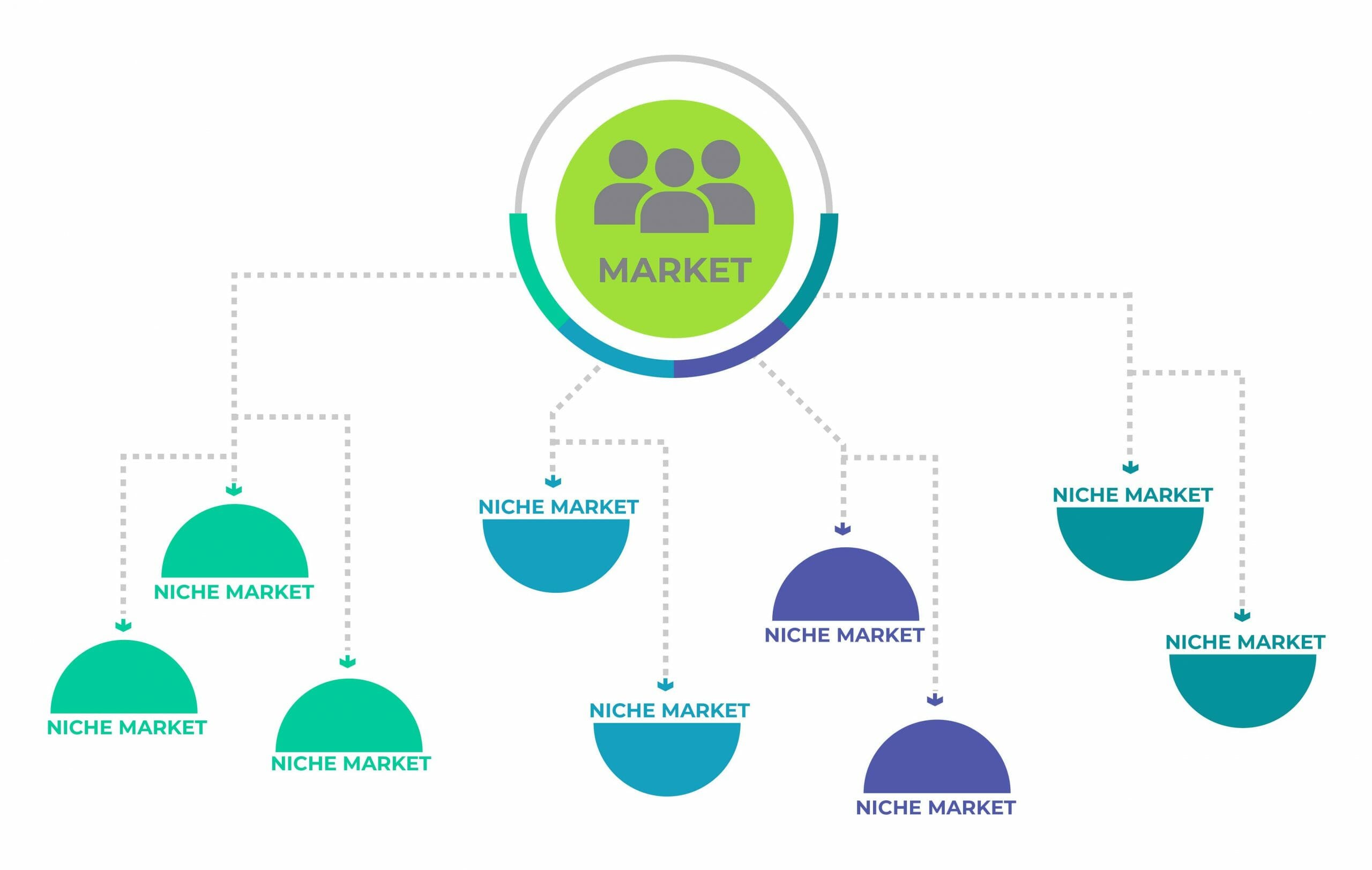
Customers in these narrow niche markets typically have more brand loyalty to small businesses because they have unique needs that aren’t often served by the rest of the market. That can make them a more receptive target audience for your chosen niche product.
BONUS : Download 3 Case Studies that Increased Website Profit 132x!
Niche markets are everywhere in online commerce. Nearly every larger market you can sell to has several niche products that appeal to a narrow, but enthusiastic, segment and takes less marketing effort on your end. Let’s dive deeper into some niche business examples.
It’s not hard to recognize a potential niche market idea when you understand what you’re looking for. As an example, here is a list of markets (and some hugely profitable niche examples at that) that do a healthy amount of more focused business:
Organic pet food
All the examples in this list of niches are included because the product or service they involve meets a more specific need than the larger market.
That’s just the beginning. You could niche down even further. For example, you could focus on pet owners with specific breeds of dogs or types of health supplements, or you can check various niches withing gaming affiliate programs .
Bodybuilders are a very different target audience than weight watchers. Making either one of them your target market is going to require you to promote different products and approach your marketing differently.
These niche site ideas have made quite a few people rich, but they aren’t necessarily right for your online business. Let’s look at how you can find your niche market products.
How to Find Your Niche Market
Now that you know how to define a niche, it’s time to brainstorm some niche market ideas.
Finding the right niche market can be complicated. It’s personal and has a lot to do with your unique selling proposition. There is a right way to go about choosing your loyal customer base and niche product. I’ve laid out a process below that can speed it up.

I’ll start with four steps that can point you to your potential market and explain each one in more detail.
- Start with your interests
- Research the niche
- Research the customers
- Test, acclimate, and adjust BONUS : Download 3 Case Studies that Increased Website Profit 132x!
Having an interest in your niche market is a natural advantage because enthusiasm is a powerful tool when you’re selling anything.

It motivates you to learn more and gives you a personal insight into what your readers want and which businesses they trust. That means it will be easier for you to answer questions like:

Trust me when I say:
Researching a niche market means finding the right specific audience for your product or service. Start by looking at the current google trends in the market and identifying the needs of potential customers.
Where to Find One
Starting with your interests, you can begin researching niche markets and the businesses that sell in them. There are three primary sources that you can use to begin your search.
Check out the cost of various sites to determine what building in a niche market might be worth. You can also list out the most valuable sites so that you can research them later. The most valuable sites are the ones that are most worth reverse-engineering.
Once you’ve determined what’s viable, you should consider what to look for in a niche, and what you should avoid.
What to Look for in a Niche:

What to Avoid in a Niche:

Particular niches are more difficult for a variety of reasons. You should try to avoid the ones that are:
You’ll have found some strong mass markets at this stage with potential. Now, you need to understand the customers’ motivations in that market.
The keyword research you did while estimating rankability will also be helpful here. Still, there are some actions you can take beyond keyword research to find out what a particular niche market customer is like and what they want.

Even if you’ve done everything else right, testing is a necessity. You won’t know if you understand or enjoy a niche market until you’ve spent some time in it.
Keep track of the amount of time you’re using to get started and the sales that you’re making and the rate conversions happen..
If you aren’t accomplishing as much as you’d like, there are some steps you can take to adjust things without giving up all the work that you’ve already put in.
Niche marketing (“nicheing” to some) is the name given to the marketing strategy of focusing on a very specific market niche. Is it worth it? That’s not an easy question to answer. You should consider the advantages and disadvantages.
Niche marketing can be a very effective way to reach a highly targeted audience. It can be particularly beneficial for small businesses with limited resources, allowing them to compete against larger businesses by providing unique products or services to a specific group. However, it requires significant market research, an understanding of the target customer, and continual adaptability to market changes.
While there are potential disadvantages, such as smaller market size and vulnerability to market fluctuations, many of these can be mitigated with careful planning and an adaptable business model. Ultimately, the success of a niche marketing strategy will depend on how well it aligns with your business’s capabilities, resources, and goals. It’s not a one-size-fits-all approach, but for some businesses, it can be a game changer.
Now, you’ve learned what a niche market is and how to identify one across different affiliate networks.
That should be all you need to find your niche market and start reaching out to businesses with offers. You can use this knowledge to target a unique market segment with content marketing, affiliate marketing, social media platforms or whatever digital marketing strategy you prefer.
Armed with the knowledge of what to look for and what to avoid, you can find a product that’s a perfect match for you. Just make sure you consider the advantages and the disadvantages before you decide to pursue niche-marketing.
If you need a little help learning the ropes, you can join The Affiliate Lab . Here, you can learn from a library of elite guides, and hang out in a community with some of the best affiliates online.

Matt Diggity
Matt is the founder of Diggity Marketing, LeadSpring, The Search Initiative, The Affiliate Lab, and the Chiang Mai SEO Conference. He actually does SEO too.
Want to rank easier, higher and faster?
Sign up and join 100,000+ other subscribers and get SEO test results sent straight to your inbox.

"One of the most effective SEOs I've ever met" - Cyrus Sheppard
As Seen On...

How to 132X Your Website's Profit
The biggest wins from 3 case studies.
- Female Beauty Niche: $500/month to $16,400/month.
- Weight Loss Niche: $4,000/month to $33,100/month.
- Toy Niche: $400 to $45,000 per month on Christmas.


Why Social Champ
A social media management solution that fits the needs of all.
By Industry
Featured blogs.

65+ Instagram Demographics That Matter to Marketers in 2024

20+ Social Media Video Tips to Boost Engagement in 2024

The Ultimate Guide to Twitter Giveaways – Benefits, Rules, and Winning Ideas
Experience powerful social media management like never before with multiple automation features & integrations.
Integrations
Talk to one of our professional customer representatives to find out the best-fit plan for your team!
Explore our wide array of learning material, success stories, support and other helpful tips & tricks to take your social media game to the next level!
Other Products
Comparisons, free ai tools.
Dreaming of launching your own business or side hustle? One of the biggest challenges for any entrepreneur is figuring out what exactly to offer. This is where niche markets come in. Niche marketing is a strategic approach that can empower your venture and help you increase your chances of success.
In this guide, we will explore the concepts in detail, including why they matter and how they are ideal for your unique skills and vision.
But before you get started, here’s a little tip: Once you figure out your niche market, try platforms like Social Champ to streamline your marketing.
Let’s get started!
Own Your Niche on Social Media With Social Champ
Schedule, analyze, and engage your niche audience seamlessly with social champ. take control of your social media presence and watch your community thrive., what is a niche market.
A niche market is a specialized segment within a larger market. It caters to a specific group of people with distinct needs or interests. They often focus on a particular:
- Group of people
Why are niche markets important?
Targeting a niche market offers several advantages:
- Less competition: Standing out is easier in a smaller crowd.
- Loyal customers: Customers value the specialized offerings, leading to strong brand loyalty.
- Targeted marketing: Precise marketing efforts lead to higher engagement and sales.
Finding your niche requires introspection and research. Look for the sweet spot where your interests and skills intersect with unaddressed customer needs.
Here’s how to get started:
Reflect on your passions and expertise. What are you good at, and what ignites your curiosity?
Research the market. Look for gaps where your skills or interests could provide solutions.
Validate your niche. Is there a sufficient customer base to support your venture?
Remember, a niche market isn’t just about being small; it’s about understanding a specific group deeply and offering them unique value.
How to Reach a Niche Market
When you select a niche marketing approach for your business, it is essential to determine how to identify a niche market.
- Start With What You Know
Begin your search for a niche market with what you’re familiar with. This could be a field you’ve worked in, a hobby, or a need you’ve noticed that needs to be met.
- Do Lots of Research
Do extensive market research to understand the problems and wants of your potential niche market. Use surveys, focus groups, and social media listening tools to collect information and determine whether your ideas are in demand.
- Use Data to Make Decisions
Use data analysis to support your findings. Look for clear trends and signs that your niche market is possible and profitable.
Making the Perfect Niche Marketing Plan
Now that you have selected your niche market, it is time to devise the perfect marketing plan for your selected customer group.
- Find Your Unique Selling Point (USP)
Your USP is what makes you different from your competitors. Find out what makes your product or service unique and meets the needs of your niche market.
- Content Is Important
Make high-quality, niche-focused content that teaches, entertains, and engages your audience. Content marketing is a powerful tool for building your brand and engaging with your community within your niche market.
- Make It Personal
The secret to winning over a niche market is personalization. Customize your messages, products, and customer experience to the specific interests of your niche audience.
- Use Many Channels
Use an omnichannel marketing approach to reach your niche market. This means using social media marketing, email campaigns, content marketing, and other relevant channels.
- Form Strategic Partnerships
Work with influencers, other businesses, or organizations that already have connections in your niche market. Partnerships can give you credibility and greatly increase your reach.
- Use SEO and SEM
Make sure your business is easy to find online by those searching within your niche. Create content using keywords related to your niche market, and consider using paid advertising through search engine marketing (SEM).
Related Article: The Top Influencer Marketing Platforms for Businesses in 2024
Building and Keeping Relationships
Attracting one-time customers shouldn’t be your goal. Instead, aiming for a returning customer who loves and trusts your brand is more significant. Building long-term relationships with your target market lets you achieve that. Here’s how to do it:
- Focus on Customer Service
Provide excellent customer service for your niche market to give you a competitive edge and create loyal customers.
- Build a Community
Build a community around your brand and niche market. This could involve hosting events, creating online or offline forums, or other initiatives that bring people with similar interests together.
- Collect and Use Feedback
Regularly ask for customer feedback and use this information to improve your products and the customer experience.
Checking Success in Your Niche
The next and equally important step is keeping tabs on the progress of your marketing strategies.
- Follow Key Performance Indicators (KPIs)
Decide on the most critical KPIs for your niche market. This could be customer satisfaction scores, how often customers make another purchase, or how engaged they are with certain content or channels.
- Change and Grow
Be ready to change your strategies and products based on market changes and feedback. Growing in your niche market is important for long-term success.
- Celebrate Success
Remember to celebrate your wins, no matter how big or small. This can create a feeling of community and success in your niche market.
How to Assess Your Niche Market Ideas
After conducting thorough research and identifying several potential niche markets, assessing their feasibility is crucial. Here’s a detailed approach:
Analyze the Competition
Estimate market potential, benefits of niche market.
Niche marketing has several benefits, including the following:
- Less Competition: In a niche market, there are fewer businesses doing the same thing. This means less competition, which allows businesses to become stronger and possibly make more profit.
- More Loyal Customers: When a business meets customers’ specific needs, those customers are usually more satisfied and loyal. This means they stay with the company longer, so the business doesn’t have to keep finding new customers.
- Easier Understanding of Customers: It’s easier for businesses to understand their customers in a smaller market. This helps them to communicate better with their customers and understand how to serve them best.
- Better Use of Marketing Money: With niche markets, businesses can target their marketing more precisely. This means they can use their marketing money more wisely by reaching the customers who are most likely to buy their products or services.
- Chance to Become an Expert: By focusing on one area, businesses can become experts in their niche. This helps them to build trust and become a respected authority in the market.
- Ability to Change and Innovate: Niche businesses can be more flexible, allowing them to respond faster to changes in the market and always come up with new ways to meet the changing needs and preferences of their customers. So, niche marketing has many benefits, showing why it’s a very important strategy for businesses today.
Niche Marketing Strategies
To fully use niche marketing, businesses need strategies that match the unique aspects of their chosen niche market.
Study a Lot
Make products for the niche, customize marketing and messages, create brand identity, use technology, connect with the community.
Niche markets often have communities of people who think alike. Connecting with these communities through social media, events, or partnerships can help build relationships and grow the brand’s presence in the niche.
Niche Marketing Examples
Let’s take a look at some brands that have leveraged niche marketing.
Paxton Pet Goods
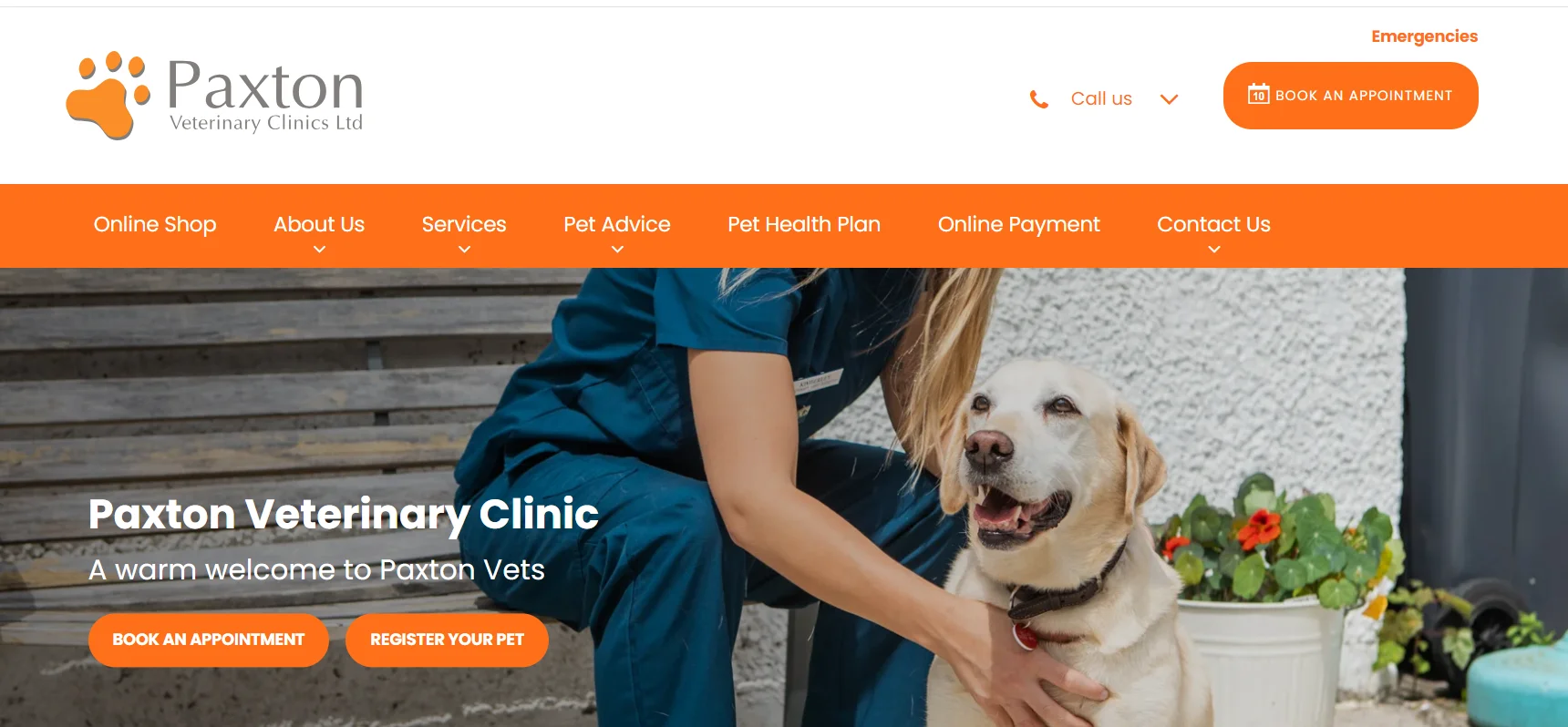
Paxton Pet Goods is a family business located in the Pacific Northwest. It was founded by Sarah Paxton, who saw a chance to make high-quality, natural products for pet’s health. Sarah’s dog had allergies, which led her to make grain-free, organic treats. She first shared these with friends and family. The response was so good that it gave her the confidence to start her business, serving pet owners who wanted natural solutions for their pet.
Niche Terrain: Challenges and Strategies
One big challenge for Paxton Pet Goods was teaching potential customers about the benefits of their products in a market full of traditional pet foods and treats. To tackle this, Sarah used content marketing a lot, creating blog posts and social media content that showed off her products and gave helpful information on pet health and nutrition.
To make her brand stand out, Sarah worked with local pet stores, offering events and education sessions in the stores. This helped her products reach more people and made partnerships that improved her brand’s reputation.
Scaling the Niche: Growth and Expansion
Paxton Pet Goods’ growth depended on keeping its niche focus while adding more pet care products. By paying attention to what customers said and what was happening in the market, they brought out new products that went well with their original line, like natural grooming supplies and supplements.
Thrive Yoga

Thrive Yoga Studio isn’t your average yoga center. Founded by Alessia Marino, it caters to a niche in NYC’s bustling scene. It offers comprehensive wellness for mind and body.
Building a Supportive Community
Thrive started with a variety of yoga styles, adding workshops on meditation, nutrition, and other wellness aspects. Marino’s goal: create a supportive community for personal growth.
Weekly social events like potlucks fostered connections, while providing valuable feedback on their approach.
Growth Through Personalization
Thrive’s reputation grew, attracting students citywide and beyond. They expanded their space and added instructors passionate about holistic wellness.
Rothwell Robotics
Rothwell Robotics found a special opportunity that mixed education with new ideas. The founder, Dr. Emily Rothwell, who used to be a STEM teacher, imagined a program that didn’t just teach robotics but focused on making a fun and easy way for kids to get involved with technology and engineering from a young age.
Rothwell Robotics started as an after-school program, teaching elementary and middle school students about the basics of robotics through hands-on projects and games. Their method mixed serious education with a fun environment, ensuring students learned while having fun.
Rothwell Robotics didn’t just stick to school programs; they also reached out to communities with less opportunity, offering their classes on a scholarship basis. This gave children important STEM skills and increased their social impact, getting support from local and national sponsors.
Balancing New Ideas and Old Ways
A big part of Rothwell Robotics’ appeal was their ability to balance new technology with the familiar. As robotics became a bigger field, Emily’s team kept updating their curriculum, keeping it relevant and interesting.
Dollar Shave Club

Dollar Shave Club is a well-known company in Venice, California. They are famous for their special way of selling men’s grooming products. The company saw a unique chance in the busy market of men’s grooming: they offer high-quality razors at a low price, and they send them to your home when you subscribe to their service.
Their smart business model gives customers the benefit of not having to keep buying new razors all the time and always having a new blade when needed. This special feature has helped Dollar Shave Club create its place in a very competitive market.
But Dollar Shave Club doesn’t just sell razors. It has added more personal grooming items to its product line so customers can buy all their grooming needs from one place. Its products are available not only online but also in stores, making it even easier for customers to buy them.
An important part of Dollar Shave Club’s success is its brand personality. They are known for their funny and joyful marketing, which has helped them build a strong bond with their customers. This strong brand identity, together with their focus on making things easy for customers and offering quality products, has led to a loyal following.
Dollar Shave Club’s ability to find and serve a specific group of customers has been key to its success. By offering good-quality, low-cost razors through a handy subscription service, they have made a name for themselves in the busy market of men’s grooming products. Their success story is a great example of how powerful it can be to find and serve a specific group of customers.
Wrapping Up
Knowing about niche markets is important for businesses in 2024. A niche market is a particular customer group that wants specific things. This helps businesses to focus on these customers, build good relationships with them, and become experts in that area.
To find a niche, companies need to do some homework. They need to look at what people want, how many other companies are doing the same thing, and what they are good at. If you’re starting a new business or if you already have a business and want to grow, finding your niche can make a big difference. This way, you can have your special part of the market, make your customers happy, and help your business do well.
Frequently Asked Questions
1. why is niche marketing important, 2. is the niche market better than the mass market, 3. how can i select a niche, resources for you.

Leave a Comment Cancel Reply
Your email address will not be published. Required fields are marked *
Save my name, email, and website in this browser for the next time I comment.
Related Posts

YouTube Audio Library: Everything You Need to Know About It
One of the very few things that may make or break your videos’ ability to interest viewers on YouTube is how well you use sound effects and/or music.

Later Reviews: Why Do You Need an Alternative in 2023
Each passing day makes the social media landscape a tougher than usual space for many with newer advancements making waves. Managing a seamless social media presence often comes

Social Media Managers Reveal the Biggest Challenges That They Face
Ever wondered what goes in the mind of the person behind your favorite brand’s social media? The person who spends hours and hours in front of a computer
- Privacy Overview
- Strictly Necessary Cookies
- 3rd Party Cookies
This website uses cookies so that we can provide you with the best user experience possible. Cookie information is stored in your browser and performs functions such as recognising you when you return to our website and helping our team to understand which sections of the website you find most interesting and useful.
Strictly Necessary Cookie should be enabled at all times so that we can save your preferences for cookie settings.
If you disable this cookie, we will not be able to save your preferences. This means that every time you visit this website you will need to enable or disable cookies again.
This website uses Google Analytics to collect anonymous information such as the number of visitors to the site, and the most popular pages.
Keeping this cookie enabled helps us to improve our website.
Please enable Strictly Necessary Cookies first so that we can save your preferences!

How to Identify & Dominate a Niche Market
How to Identify & Dominate a Niche Market
Finding an untapped or underserved niche market can be like striking gold for an entrepreneur or small business. Dominating a niche allows you to become the go-to expert and preferred provider in that focused area, making attracting and retaining loyal customers easier. But how do you identify the right niche and establish your foothold?
In this article, we'll break down a simple yet effective process for pinpointing profitable niches and dominating them through targeted marketing and positioning. First, we'll explore how to research potential places based on industry trends, consumer demand, and competition. Next, we'll discuss best practices for tailoring your product or service to the niche audience. Finally, we'll provide tips for owning the niche through search engine optimisation, social media marketing, strategic partnerships and other innovative growth strategies.
Whether you're looking to launch a new business or take an existing one to the next level, dominating a niche market can help you stand out, rapidly grow a customer base and boost profits. With the right game plan, your small company can become a big name in a specialised category. This article provides the playbook to help get you there. Let's get started!
Table of Contents
What is a niche market?

A niche market is a specific portion that caters to a particular group. Mainstream markets target a more diverse group. Niche markets focus on a narrower group with needs, preferences, and interests.
This niche could be anything from hobbies to industry-specific services. Its uniqueness and specificity mark it. Businesses can tailor their offers for their customers.
In addition, there are fewer competitors in niche markets than in broader markets. This allows businesses to be the experts and form relationships with customers. They can deliver what their audience needs, becoming leaders in their niche.
Smaller businesses can gain an advantage over larger companies. They can understand and respond better to the needs of the niche customers.
Pro Tip: Research the market to ensure enough demand and viability for your product or service. Know your target audience's wants and needs to ensure you're positioned correctly in the market. This increases your chances of dominating it.
Why is identifying a niche market important?
Identifying a niche market is crucial for several reasons. Firstly, it allows businesses to focus their efforts and resources on a specific target audience, increasing the chances of success. This is because a niche market consists of a smaller, more particular group of consumers with distinct needs and preferences, which can be better addressed through tailored products or services.
Moreover, identifying a niche market helps businesses stand out from the competition. By catering to a specific group of consumers, companies can differentiate themselves and develop a unique selling proposition . This not only helps in attracting customers but also in building brand loyalty and reputation.
Additionally, targeting a niche market enables businesses to establish themselves as experts or leaders in that particular industry or field. They can acquire in-depth knowledge about their customers, competition, and market trends by narrowing their focus. This expertise provides a competitive advantage and increases the chances of success in the long run.
Furthermore, identifying a niche market allows businesses to optimise their marketing efforts. Instead of wasting resources on generic advertising, they can create personalised and targeted campaigns that resonate with their niche audience. This increases the effectiveness of marketing strategies and ensures a higher return on investment.
A study found that companies that successfully identify and dominate a niche market experience higher growth rates than those targeting broader markets. The ability to serve specific consumer needs and build strong customer relationships contributes to their accelerated success.
Targeting a niche market is like having a secret weapon in business – it's the strategic equivalent of bringing a knife to a gunfight and walking away as the victor.
Benefits of targeting a niche market
Targeting a niche market offers many benefits that can significantly help businesses. Companies can understand the needs and preferences of a specific group of consumers and adjust their products or services to meet them. This builds customer loyalty and makes companies stand out from competitors in a hectic market.
- Customers feeling understood and valued brings increased loyalty.
- The market is more focused and specialised, reducing competition.
- You can charge premium prices due to unique offerings and less competition.
- Marketing messages are more effective as they reach their target audience.
- You know more about customer behaviour and preferences, which helps product development.
- Niche markets often have untapped potential, leading to long-term growth.
In addition, niche markets help businesses become experts in their field. They develop deep knowledge and expertise, improving their credibility among consumers. This increases customer trust in the brand and makes them more likely to buy again.
Pro Tip: When selecting a niche market, do in-depth market research. Understand the demographics, buying patterns, and preferences of the target audience. This way, you can refine your strategies and create tailored offerings that customers like.
How to identify a niche market
When identifying a niche market, it's crucial to approach it professionally and precisely. Understanding how to narrow down your target audience can significantly benefit your business. Here's a concise and informative guide to identifying a niche market:
- Research: Conduct thorough research to gather insights into various industries and markets. Analyse consumer behaviour and trends to identify potential gaps or opportunities.
- Find a Specific Market Segment: Once you have researched, narrow your focus to a specific market segment . Look for a group of consumers with unique needs or interests that are not currently being met adequately.
- Understand Consumer Pain Points: Dive deep into understanding the pain points of your target market. What challenges do they face? What solutions are currently available? By identifying these pain points, you can offer a unique product or service that addresses their specific needs.
- Test and Validate: Before fully committing to a niche market, testing and validating your ideas is crucial. Conduct market surveys , run pilot campaigns, and gather feedback from potential customers to ensure there is demand for your product or service.
In addition, it's essential to consider the following details:
- Demographic Analysis: Evaluate demographic factors such as age, gender, location, income level, and occupation to ensure your target market aligns with your business goals.
- Competition Analysis: Analyse the competition within your chosen niche market. Identify their strengths and weaknesses, and find ways to differentiate yourself by offering a unique value proposition .
- Marketing Strategies: Develop effective marketing strategies tailored specifically to your niche market. Utilise channels and platforms your target audience will engage with.
- Consistency and Adaptability: Stay consistent with your niche market and continually adapt your offerings based on customer feedback and changing market trends. This will help to build trust and loyalty among your target audience.
By implementing these strategies, you can identify a niche market and dominate it successfully. Remember to keep a professional and informative tone throughout your approach, avoiding unnecessary phrases or words. Do your market research like a detective on a never-ending TV series – find clues, follow leads, and solve the case of the profitable niche market.
Market research
Market research is vital for businesses. It involves techniques like Demographic Research, Psychographic Research, Competitive Analysis, Customer Surveys, and Focus Groups.
Demographic Research looks at characteristics like age, gender, income, and education level to understand the target market. Psychographic Research examines consumers' interests, values, attitudes, and lifestyle choices to recognise their preferences.
Competitive Analysis studies competitors' products, pricing strategies, marketing techniques, and customer feedback to gain an advantage. Customer Surveys gather customer feedback through surveys or questionnaires to understand their needs and expectations. Focus Groups involve interactive discussions with specific participants to gain qualitative insights about a product or service.
Other than these, market research may also include analysing online trends, monitoring social media platforms , and observing consumer behaviours.
One business owner utilised the power of market research before releasing a vegan snack line. The analysis indicated an ever-increasing demand for plant-based foods among health-conscious individuals. Consequently, the business developed products that addressed this niche market and achieved great success.
By recognising the value of market research and applying various techniques, businesses can locate niche markets and adjust their offerings accordingly. This allows them to stand out from competitors and effectively fulfil their target audience's unique needs.
Identifying customer pain points and needs

Identifying customer pain points and needs is essential for businesses targeting a niche market. You must learn the challenges and desires of your target audience. Then, you can tailor products and services to meet their requirements.
Conduct thorough market research. Gather data on consumer behaviour, preferences, and industry trends. Analyse the data to get insights into what motivates your target audience's buying decisions and identify any gaps in the market.
Engage with customers through surveys, interviews, or focus groups. Listen to their concerns, understand their frustrations, and find opportunities for improvement.
Monitor customer feedback on social media platforms and online review sites. This helps to spot issues customers are having using products or services. Responding to these concerns shows you care about customers' needs.
Apple revolutionised the music industry with iTunes. Consumers were frustrated with illegal downloading sites compromising sound quality and not paying artists fairly. Apple identified this pain point and created a legal platform for users to buy high-quality music at affordable prices while ensuring artists got paid.
Analysing competition
Analysing your competition means studying competitors in the market. This helps you work out their strategies, strengths, and weaknesses. You can then decide how to position yourself best.
Check out the table below for an overview of analysing competition:
By looking at the competition, you can get unique insights. These include their target audience, pricing plans, and distribution channels. This allows you to make intelligent decisions about your niche market.
Forbes conducted a study which found that companies that analyse their competition will have a higher chance of long-term success. They can respond and adapt to changing market conditions.
Understanding niche market characteristics
Understanding niche market characteristics is crucial for success in a specific market segment. To identify and dominate a niche market, it is essential to comprehend its unique features and tailor strategies accordingly.
The table below presents key characteristics of niche markets:
In addition, niche markets may hold unexplored opportunities, untapped potential, and increased customer loyalty compared to broader markets. Understanding these unique details allows businesses to develop targeted marketing strategies to attract and retain niche customers.
To maximise opportunities in niche markets, businesses must take action and take advantage of potential growth. Ensure your business stays ahead of competitors by identifying niche markets and tailoring products or services accordingly. Don't let the fear of missing out hold you back from capitalising on the untapped potential and profitability niche markets offer. Act now and dominate your niche!
In the vast ocean of potential customers, finding your niche market is like spotting a floating cupcake in a sea of kale smoothies.
Size of the market
The size of a niche market affects business success. We must delve into data to analyse factors and figures that define the scope.
A table can show market size info. Examining data such as target audience size, customer demographics, and market share analysis gives businesses an understanding of the niche market.
We must note unique details about the size. This can include analysing trends, industry growth rates, and expansion opportunities. When considering these factors, businesses can make informed decisions regarding niche market entry or expansion strategies.
To succeed, pay attention to the importance of understanding niche market size. With this knowledge, you may gain potential customers and growth opportunities. Uncover critical insights and stay ahead in your industry!
Target audience demographics
A successful entrepreneur , Alex knew the value of pinpointing his target audience demographics. He saw that his product appealed to tech-loving people aged 25-40, with an income of £30,000 – £50,000 . By focusing his marketing efforts on this group's interests and likes, Alex saw excellent growth in his business .
Plus, it's essential to consider the geographical area of the target audience when planning marketing strategies. For instance, if the target audience is located in urban or rural areas.
Customer behaviour and preferences

Customer behaviour and preferences are essential to understand niche markets. By studying customers' behaviour and the factors which affect their decisions, businesses can shape their products and services to meet their specific needs and preferences. Let's look at some of the characteristics of customer behaviour and preferences.
Below is a table with an overview of different aspects of customer behaviour and preferences:
Businesses can use this information to adjust their marketing strategies. However, there are more details to consider.
Customer behaviour and preferences change over time due to trends, new technology, and cultural shifts. This means businesses need to keep track of these changes to stay competitive in the market.
Pro Tip: Along with studying customer behaviour, it is vital to gather direct feedback from customers through surveys or feedback forms. This will provide valuable insights into their needs and preferences and help businesses make better decisions.
Dominate a niche market.
In today's competitive business world, dominating a niche market is essential for success. To achieve this, follow these three steps:
- Identify your target audience : Clearly define your niche market by understanding your potential customers' needs, preferences, and characteristics. Conduct thorough market research to gather valuable insights.
- Develop a unique value proposition : Differentiate yourself from competitors by offering a product or service that solves a specific problem or meets a particular need within your niche. Focus on delivering quality, innovation, and exceptional customer service.
- Implement effective marketing strategies : Craft a tailored marketing plan to reach and engage your niche audience. Utilise various channels such as social media, content marketing, email campaigns, and partnerships with influencers to increase brand awareness and attract customers.
Additionally, continuously analyse and adapt your strategies based on market trends and customer feedback to stay ahead of the competition.
To maximise your chances of dominating your niche market, take action now. Take advantage of the opportunity to establish yourself as the go-to brand in your industry. Start implementing these steps and witness the growth and success of your business .
Positioning your brand : Because being the master of your niche is like being the only fish in a tiny pond, it's time to dive in and make a big splash!
Positioning your brand

Dominating a niche market requires effective brand positioning. Here are five key points to keep in mind:
- Identify Target Audience. Learn your customers' demographics, preferences, and needs to tailor your messaging.
- Create Unique Value. Differentiate your brand by highlighting what makes you stand out from competitors.
- Be Consistent. Keep visuals, tone, and messaging the same across all platforms. This builds recognition.
- Evoke Emotion. Connect with your audience by telling stories that resonate with their values.
- Stay Updated. Monitor trends and consumer behaviour. Stay informed about industry developments.
Collaborate with influencers who align with your brand values to reach more people.
For instance, a small London coffee shop faced tough competition. But they positioned themselves as the spot for speciality brews from ethically sourced beans. They earned a loyal customer base by showing their commitment to quality and sustainability. This story illustrates how strategic positioning can help businesses thrive in a niche market.
Tailoring marketing strategies
Creating custom marketing strategies is necessary to capture and conquer a niche market. By comprehending your target market's particular needs and preferences, companies can make unique campaigns connecting with prospective customers enhancing brand recognition and sales.
To craft successful strategies, it's imperative to analyse buyer data, do market research, and recognise critical demographic groups. By finding the precise characteristics of your target market, such as age, gender, location, interests, and buying behaviour, you can design campaigns that appeal directly to their wants and needs.
Also, businesses can use technology to personalise their marketing attempts. Utilising customer relationship management systems lets firms collect valuable data on individual consumers, customising their messages based on past interactions and tastes. This individualised approach boosts customer engagement and increases the chances of transforming leads into faithful customers.
Moreover, altering marketing strategies to match current trends and industry advances guarantees relevance in a continuously changing market. Keeping up with the latest digital marketing techniques and platforms allows businesses to reach their target market efficiently. From social media advertising to influencer partnerships, embracing new channels enhances brand exposure within the niche market.
In addition to staying informed of industry trends, studying past successes and errors gives valuable insights for bettering future marketing strategies. Businesses better understand what engages their niche market by analysing historical data on customer response rates, campaign reach and impact metrics. This understanding impacts decision-making processes when making subsequent campaigns for sustainable growth.
Customised marketing strategies have been successful for numerous brands throughout history. Nike's famous “ Just Do It ” campaign, which focused on empowering individuals through sport, captured the attention of athletes worldwide while situating Nike as a symbol of determination and accomplishment. Nike dominated the sports apparel industry by targeting a particular audience–athletes aiming for greatness.
Building relationships with customers

Creating strong bonds with customers is critical for taking over a specific market. Companies can tailor their services or products by understanding their needs and wants, leading to a devoted customer base. Good communication and personal interactions help create trust and boost customer satisfaction.
One way to build connections with customers is through excellent customer service. Responding promptly to questions, tackling problems swiftly, and exceeding expectations can make a lasting impression on customers. Furthermore, keeping them informed about new offerings or special deals shows their needs are valued.
Another technique is to use social media platforms to connect with customers. Businesses can form meaningful relationships by listening to their feedback, responding to posts and messages, and sharing helpful content. Offering exclusive discounts or promos for social media followers further strengthens customer bonds.
Developing relationships with customers dates back to the early days of commerce. Shopkeepers would know each customer's name and preferences. They would take note of individual tastes, suggest products according to previous purchases, and listen attentively to any issues. This tailored approach created loyal customers and led to word-of-mouth referrals, helping businesses thrive in their niche markets.
Examples of successful niche market domination

Niche market domination has been seen in various cases. Here are five standouts:
- Fitbit took the electronic fitness tracker industry by storm, targeting health-conscious people who wanted to track their daily progress.
- Dollar Shave Club made shaving products affordable and easy to get with a subscription model, beating traditional razor companies.
- Lush Cosmetics became a leader in cruelty-free beauty products, appealing to customers prioritising ethics.
- Airbnb revolutionised the hospitality industry, allowing homeowners to rent to travellers seeking unique accommodations at competitive prices.
- HelloFresh supplied convenient and healthy meal solutions, sending pre-proportioned ingredients and recipes to those who wanted to cook at home.
These cases show the value of understanding a target audience's needs and offering tailored solutions.
Niche market domination can also be done by combining features that stand out from competitors. Tesla's success in electric vehicles is an example of this; they focus on high-performance cars with long-range capabilities and autonomous driving technology.
In conclusion, here are the chief takeaways from exploring niche markets:
- Research is vital to find an untapped niche market. Look for customer needs and gaps in the market.
- Knowing your target audience is vital to dominating a niche market. Make products or services to meet their wishes and requirements.
- A strong brand presence is essential to stand out in a competitive marketplace. Highlight distinct advantages that fit your niche audience.
- Promotion strategies tailored to your niche market will strengthen visibility and draw the right customers. Use targeted ads, partnerships, and social media to reach your audience.
- Maintaining consistent quality and excellent customer service helps secure long-term loyalty for your niche market. Focus on building relationships to get repeat business.
- Continually adjust and innovate to stay ahead of rivals in the ever-changing marketplace. Track emerging trends and try to be at the edge of industry developments.
Furthermore, checking competitors can give you helpful info about what's happening in your niche market. Stay informed about their plans and services to keep up your competitive advantage.
Pro Tip: Be creative and think outside the box when tackling your niche market. Unconventional ideas can lead to successes that set you apart from the competition.
By following these guidelines, you can become a leading player in your chosen niche market, eventually driving sustained growth and success for your business.
Frequently Asked Questions
A niche market is a specialised segment of a larger market, focusing on a specific product or service that caters to a distinct set of customers with unique needs and preferences.
How can I identify a niche market?
To identify a niche market, you can conduct market research to identify gaps or underserved areas within a broader market. Look for specific demographics, interests, or problems not adequately addressed by existing products or services.
What are the benefits of targeting a niche market?
Targeting a niche market offers several benefits, including less competition, higher customer loyalty, increased profitability, better customer relationships, and the ability to position your business as an expert in a specific field.
How do I dominate a niche market?
Dominating a niche market requires a strategic approach. Some key steps include understanding your target audience deeply, offering unique and tailored products or services, leveraging digital marketing techniques, building strong brand visibility, providing exceptional customer experiences, and continuously adapting to market trends.
Can I target multiple niche markets?
While it is possible to target multiple niche markets, focusing on dominating one niche market is generally more effective. Once you have established a strong presence and success in one niche, you can expand your business to other related or complementary places.
How long does it take to dominate a niche market?
The time it takes to dominate a niche market can vary depending on several factors, such as the level of competition, the size of the market, the effectiveness of your marketing strategies, and the uniqueness of your offering. Establishing a dominant position in a niche market can take several months to a few years.
Stuart Crawford
Need help building your brand.
Let’s talk about your logo, branding or web development project today! Get in touch for a free quote.
Leave a Comment Cancel reply
Trusted by businesses worldwide to create impactful and memorable brands.
At Inkbot Design, we understand the importance of brand identity in today's competitive marketplace. With our team of experienced designers and marketing professionals, we are dedicated to creating custom solutions that elevate your brand and leave a lasting impression on your target audience.
- Free SERP Checker
- Book a Demo
- SEO Content , Uncategorized
- March 11, 2022
How to Do Niche Research and Find Profitable Niches
Financial freedom is what most people strive for. And niche marketing affords you this opportunity.
No longer do you have to depend on clients for your livelihood. By creating a profitable niche website, you are your own boss . You dictate how you want to earn and how much.
At best, you can even make money while you sleep!
The online gambling industry is one of the most competitive niches to target. It offers millions of dollars in revenues per year, and it’s extremely difficult to break into. In this Profitable Niches https://gamblizard.ca/deposit-bonuses/deposit-2/ offer cutting-edge games and competitive bonus packages. Plus, they spend millions on marketing. That makes this niche the perfect place to build a profitable bundle.
As the internet has become the go-to tool of the 21st century, the demand for online casino services has increased. As a result, affiliate marketing has followed suit. This industry is highly competitive and requires a large budget. The demand for online casinos is increasing and there’s a growing demand for affiliate marketing.
Affiliate marketers should start with a gambling niche if they’re new to affiliate marketing. Established affiliates create new websites that focus on certain topics. This way, they can target specific markets with higher conversion rates. Moreover, these niches are more likely to attract loyal users. So, it’s important to consider this when creating a website.
But before you dream of having this kind of life, you need many things to go your way. And aside from working tirelessly to build a site from the ground up, you must know how to research the right niche market and how to find profitable niches.
This post outlines the exact process of performing niche research to find niche markets and filtering them down to the most profitable, and nailing the steps down guarantees you the most money in the shortest period.
You can use these tips to find profitable affiliate niches , markets with the highest RPMs for display ads, and lucrative product ideas for online store.
Look for Familiar Niche Ideas
For starters, take a look around and look at the products you’re currently using.
Do you have dumbells and weights lying around your home? Consider the fitness niche market as your entry point.
Do you find yourself playing guitar often? You can get into the guitar niche instead.
Other than products, list down your hobbies and interests as potential niche ideas.
If you like cooking and love to try out new recipes during your spare time, the cooking niche is a good starting point for you.
Even interests like cryptocurrency, movies, or basketballs are possible niche ideas that you can turn into a profitable website.
The idea behind going into a familiar niche is because you have pre-existing knowledge about the niche and have a special attachment .
Working on a niche you know gives you the edge against competitors who are just doing it for the money. It gives you insights into the subject that ordinary people don’t have.
This is important, especially when you create content on your site since your content will better resonate with your audience.
At the same time, not all the niche ideas you’ll come up with here are and will be profitable. The point of gathering as many niches as possible is to narrow down the selection to the most profitable one.
How to Stay Up-to-Date on Keyword Search Trends
Look for Niche Ideas Outside Your Scope of Knowledge
There are lots of great niches to choose to build your online business. And you may not even be aware of most of them.
In this case, you must research what these other niches could be.
Start your niche research with Google trends . Search for a keyword or topic, and the tool will break it down according to interest in the subregion and related queries and topics.
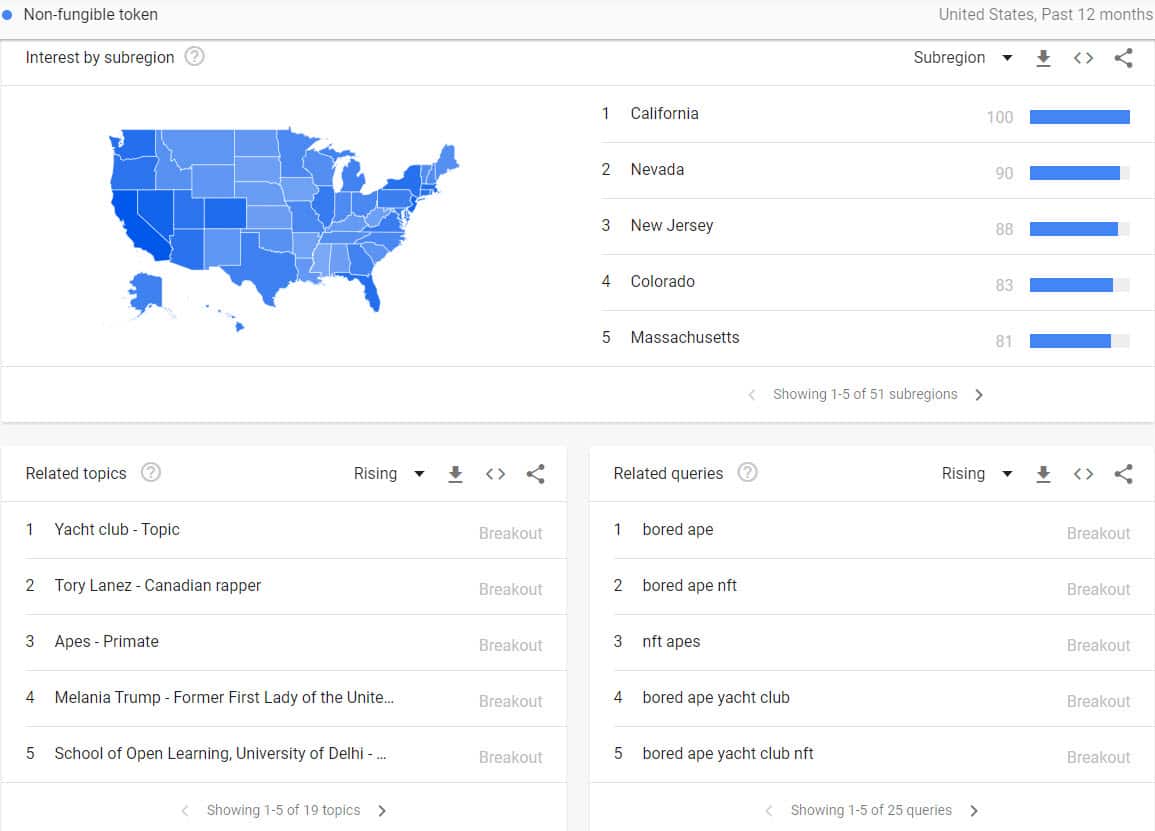
From here, you can narrow down your search to a specific subtopic or niche market. You can then compare and pick one that has the highest interest among these markets over time.
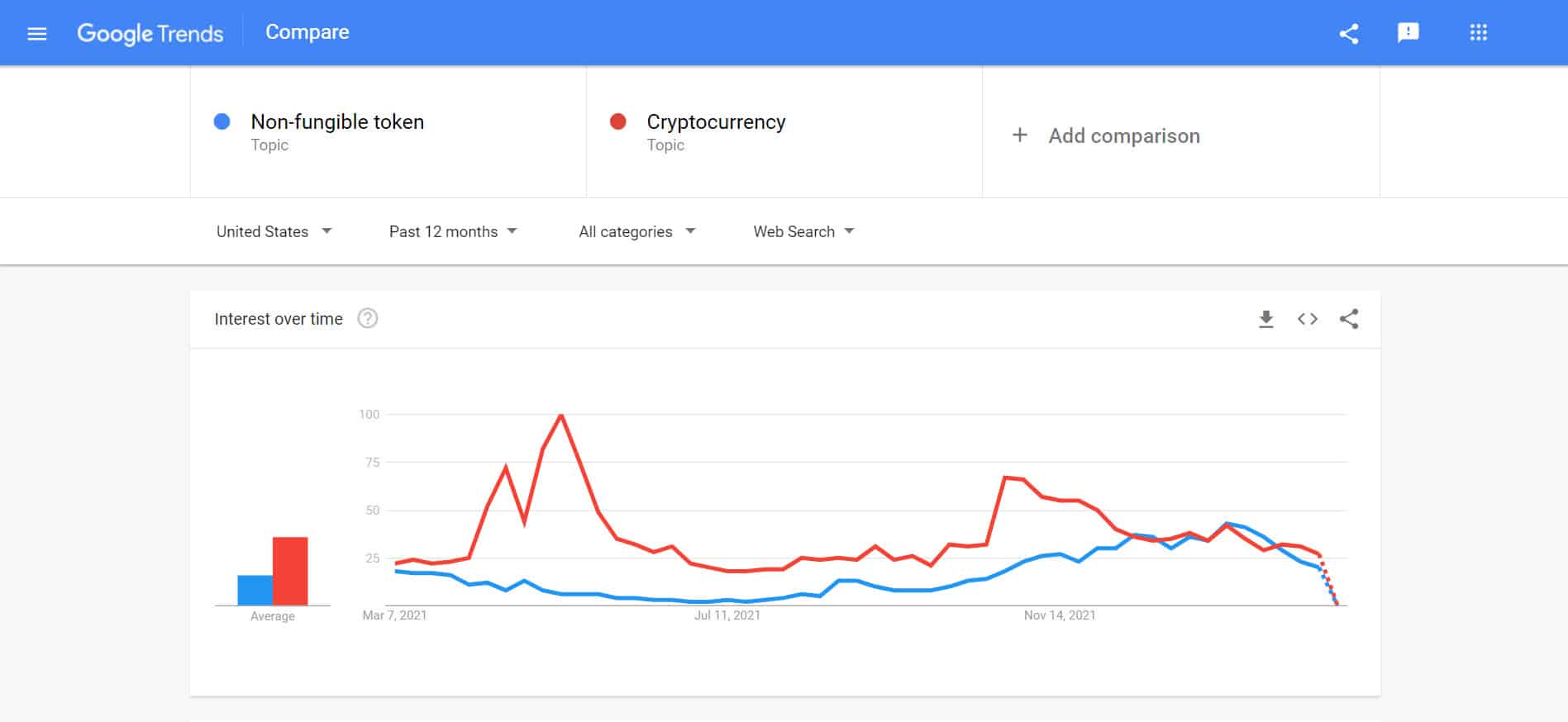
You can even run your list of niches using Google Trends to get an idea regarding their interest using Google search.
The tool also provides you with daily and real-time search trends over a period.

You can use this feature to learn more about the current trends and dig deeper into their respective niches.
Another way to search for niche ideas is by using Ahrefs . It’s one of the best search engine optimization (SEO) tools in the market that helps you with different aspects of SEO.
For this purpose, its Keyword Explorer feature is the only keyword research tool in the market that allows you to enter nothing on the search bar. This way, you can gain access to its extensive keyword data .
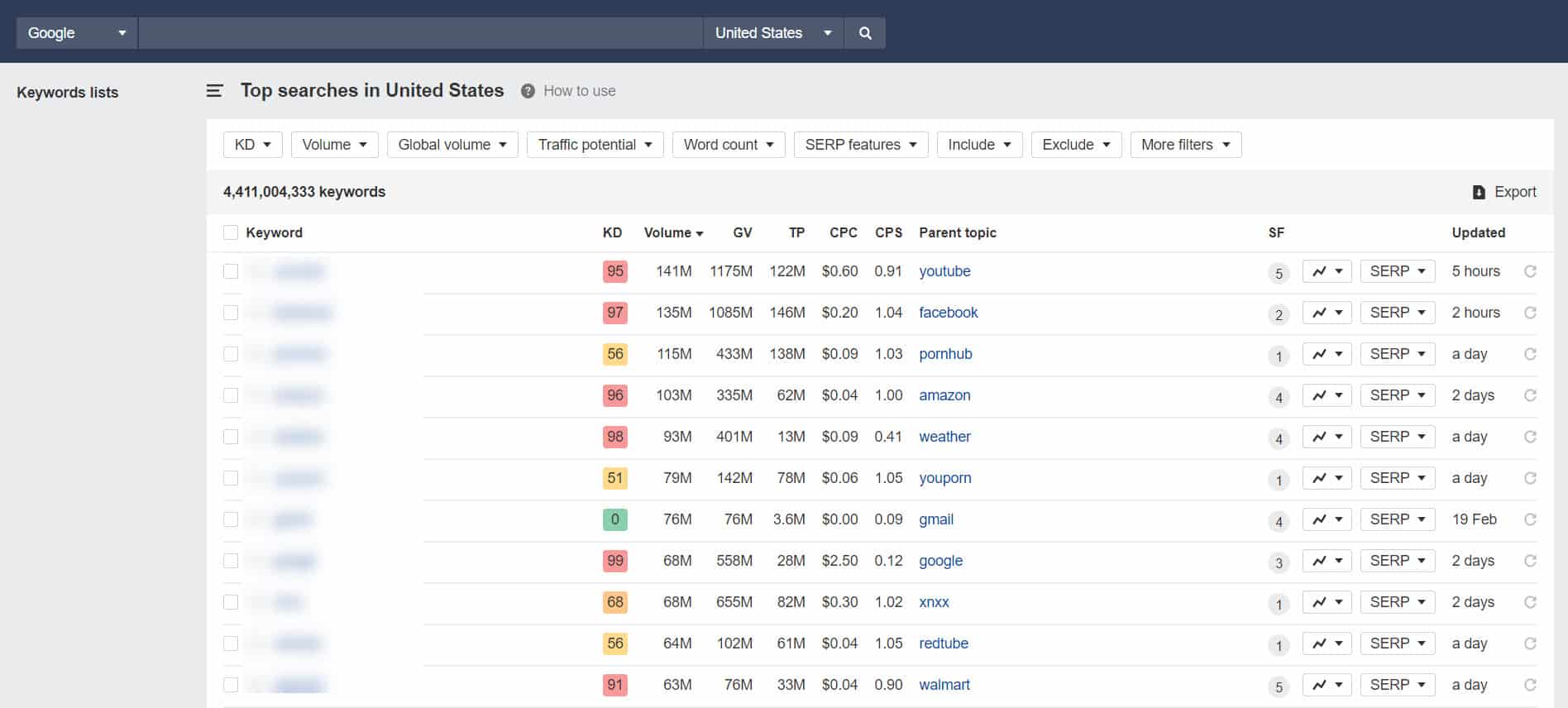
From here, you can comb through the list using filters to drill down niche keywords that are easy to rank for on organic search.
Ideally, you want to find keywords with relatively low Keyword Difficulty (KD) and Traffic Potential (TP).
For example, you can limit the niche keyword results by setting the KD to 10 and TP to at least 1 million.
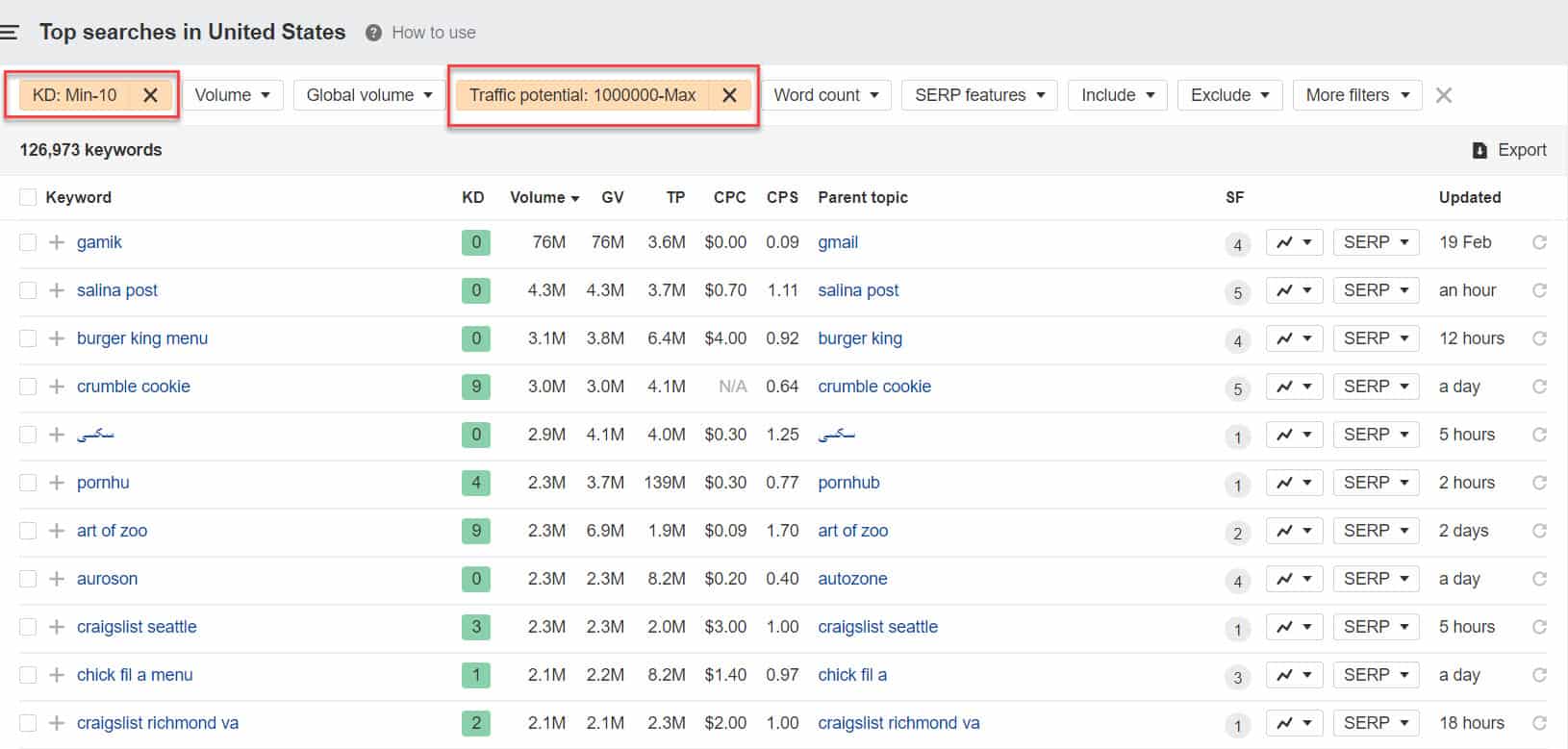
You can refine the results by playing around with the filters. You can exclude niche keywords containing specific words or phrases to prevent them from showing up.
Once you’ve found something interesting, click on its Parent Topic to see related keywords that you can optimize and rank for.

This shows data about the topic to which the initial keyword belonged. We will delve deeper into the information here once we reach the keyword research section of this article.
Finally, you can use Exploding Topics to expand your niche research.
It’s a premium tool with a 14-day trial for $1. But the site shows data for some of the niches that exploded in search volume.
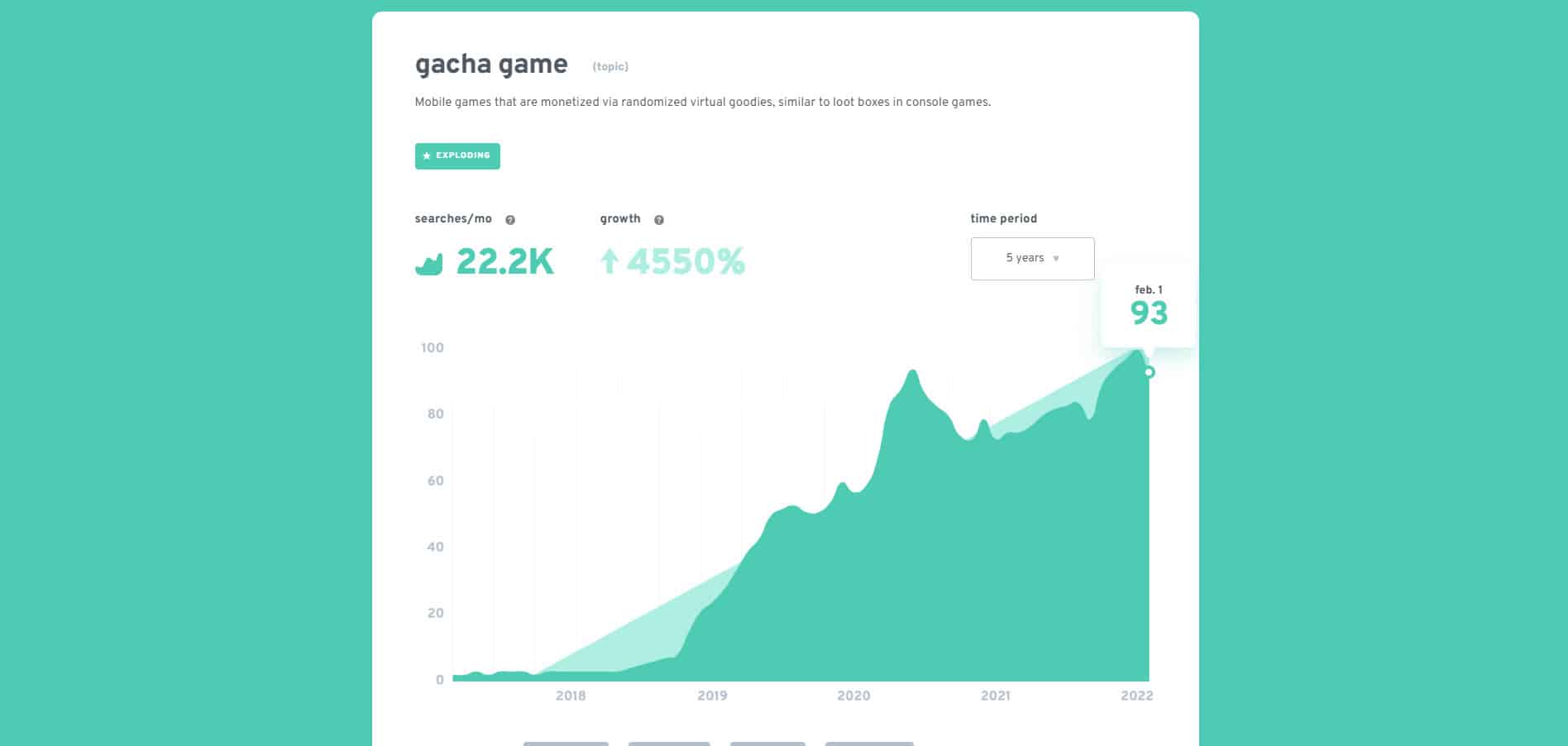
Unlike the previous tools that analyze a niche based on its current search volume and interest, Exploding Topics uses an algorithm that predicts the growth of a niche in the future.
This means the niche may not have lots of interest and organic searches now, but it could have tremendous popularity in six months.
Keep in mind that the niches featured in the tool won’t guarantee you profitability in the future. However, it does help expedite your research of a profitable niche market so you can focus on getting your niche site up.
Find a Niche from Products You Can Sell (and Make Money From)
Another place where you can perform niche research is by going to online marketplaces.
These sites carry various products across different niches that you can promote and sell on your website.
What you’re doing here is reverse-engineer the process of niche research .
Usually, you search for products to sell and make money at the latter part of your research. But you can use these marketplaces for hunting down niches you didn’t know existed.
There are many marketplaces to sink your teeth into, including Amazon and eBay .
The former is the largest online marketplace with a host of products to sift through for niche ideas. And while eBay isn’t as big as Amazon, it hosts products you may not find on Amazon, in particular auctioned and pre-loved items.
Upon visiting either site, look for the Category section and check out the subcategories of the one that is of interest.

Click on the subcategory to visit the related products and subcategories page to broaden your search.
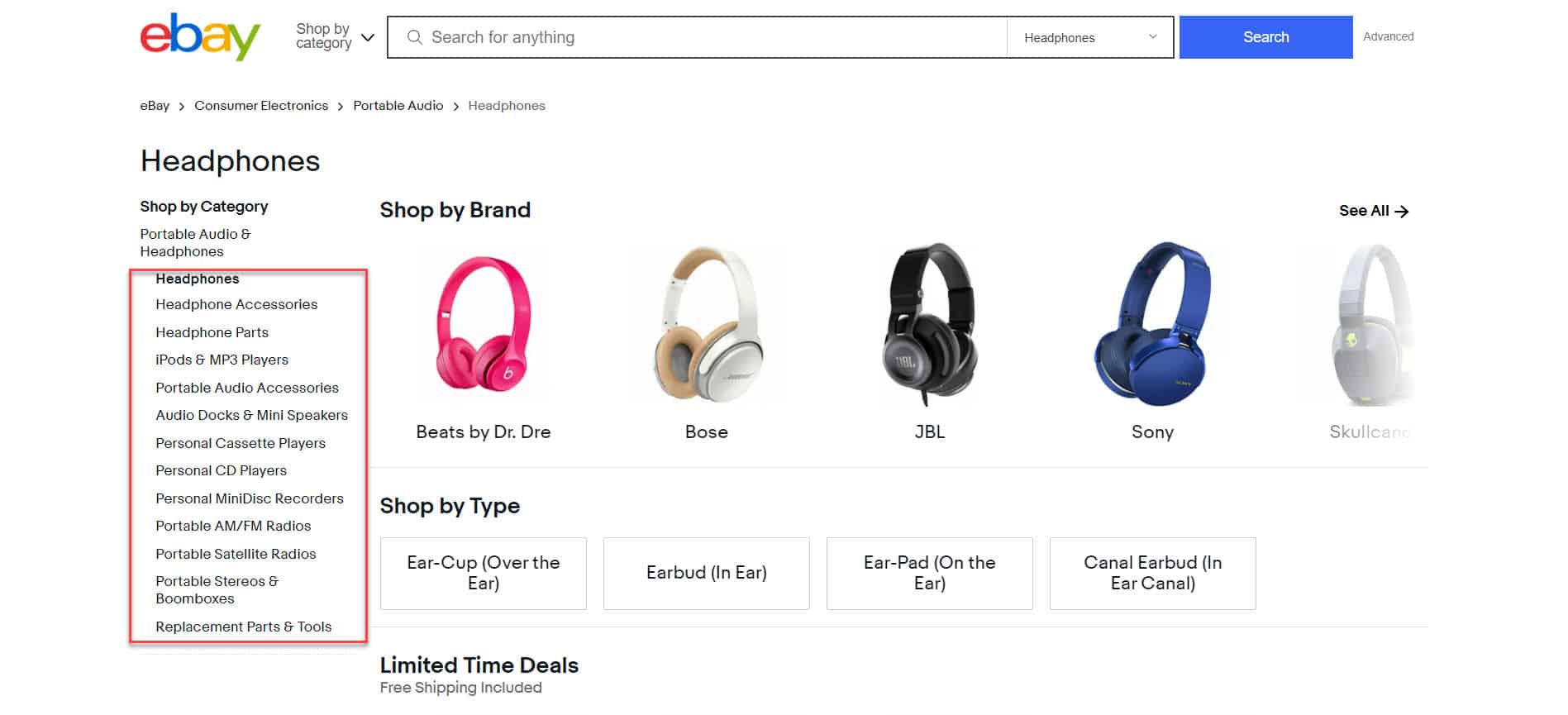
At this point, you might as well look for the best products sold under this subcategory.
On eBay, scroll down until you reach the products section. You can filter the results based on price, brand, and others to get a general sense of the average product cost in this niche.
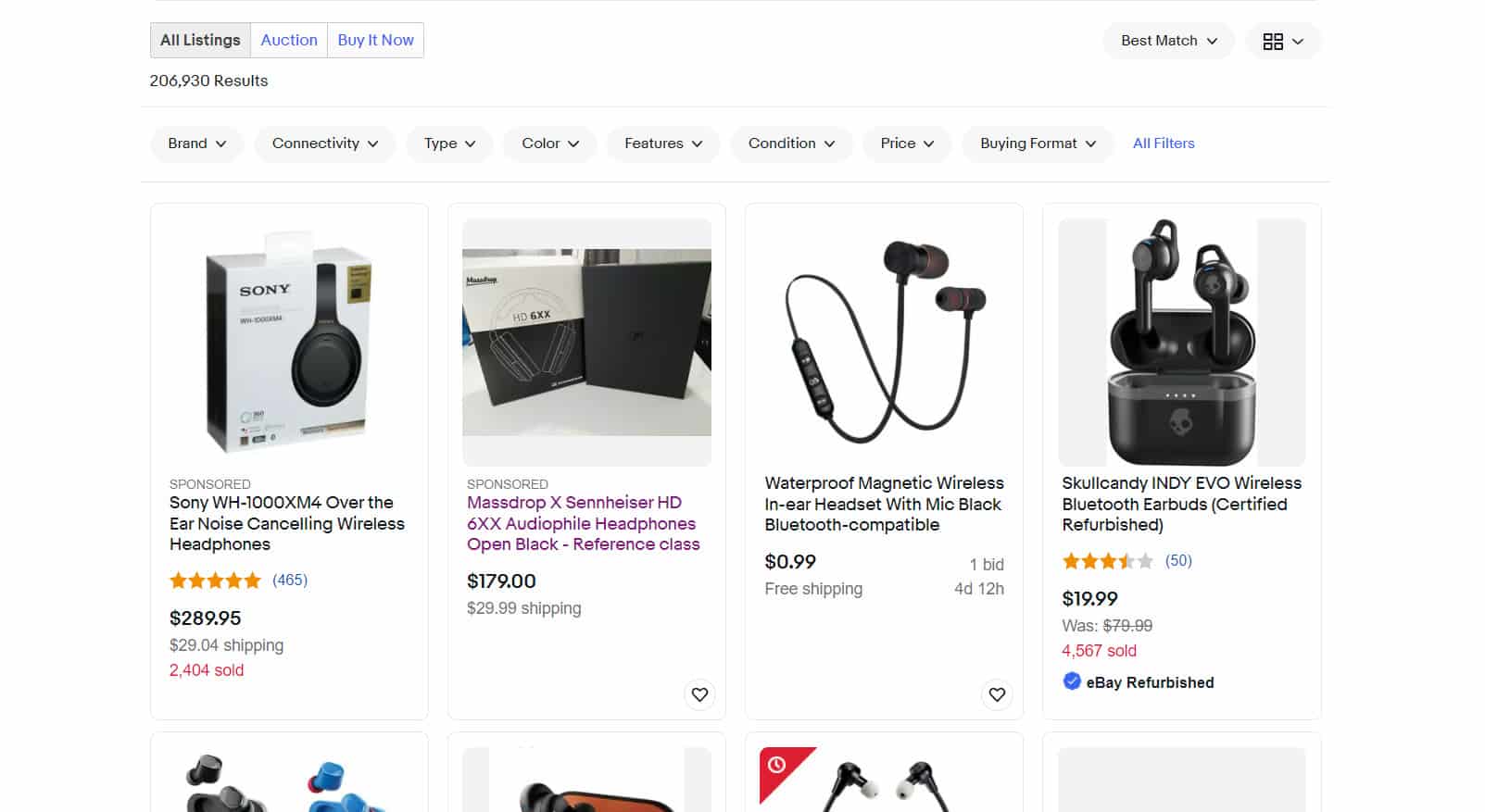
If you’re on Amazon, you can even filter the results based on their rating to help you find what customers think are the best products in the category.

This will be much more important later on , especially if you’re going the affiliate marketing route.
But if you’re planning on building an online store , research on AliExpress instead. The site carries the most affordable products you can purchase in bulk.
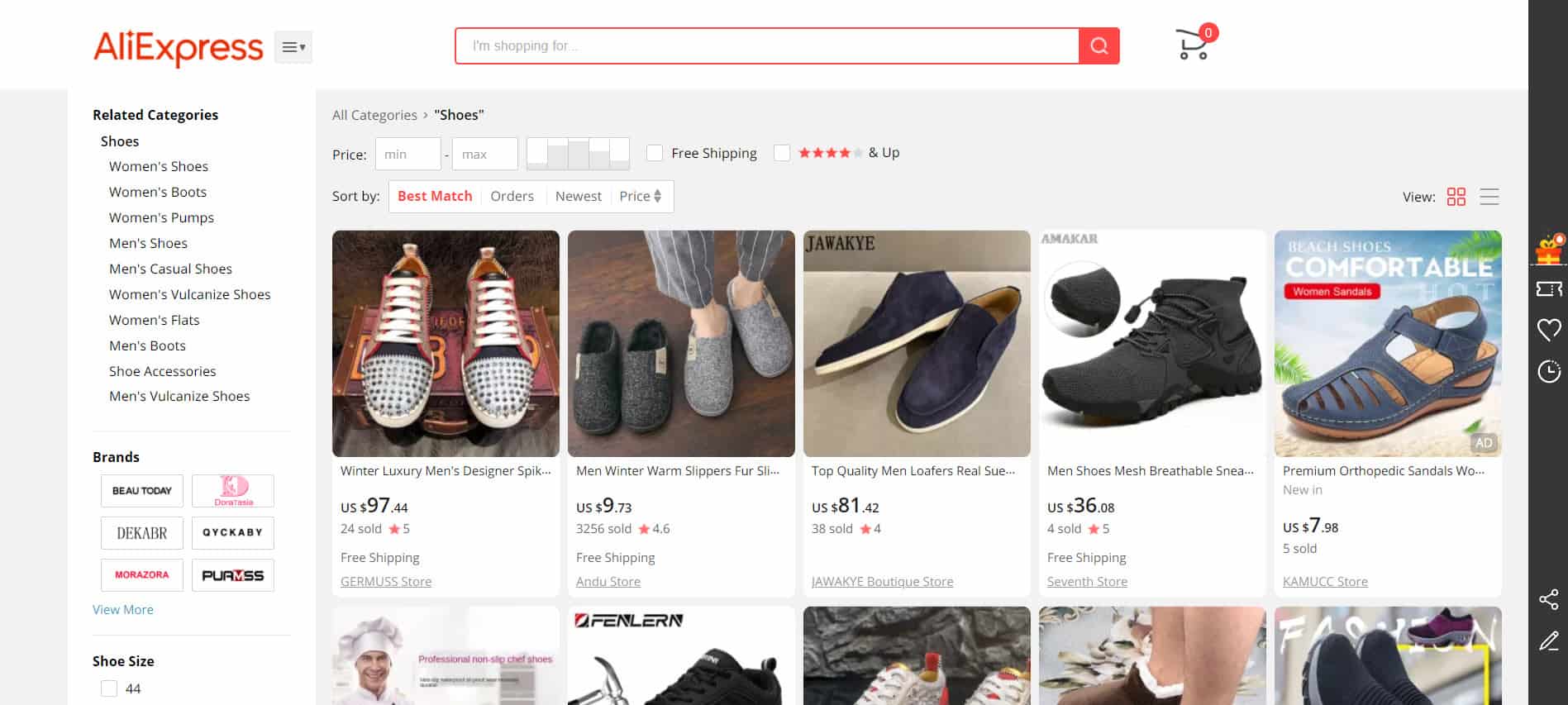
Analyze The Niche Market and Audience
Once you have brainstormed for different niches, you must filter which are the most profitable.
Knowing how much you can potentially earn from your niche enables you to choose the one that will help you make the most money.
To do this, you must check out their respective market shares and their online audience .
Regarding the former, you can check Statista to help you identify the market shares for a niche.
For example, Statista has a collection of statistics and data about cryptocurrency as a whole and the different currencies for trading.

You want to find out whether the outlook towards the niche is good. A good sign is when you see growth based on the graphs shown from the different studies on the site.
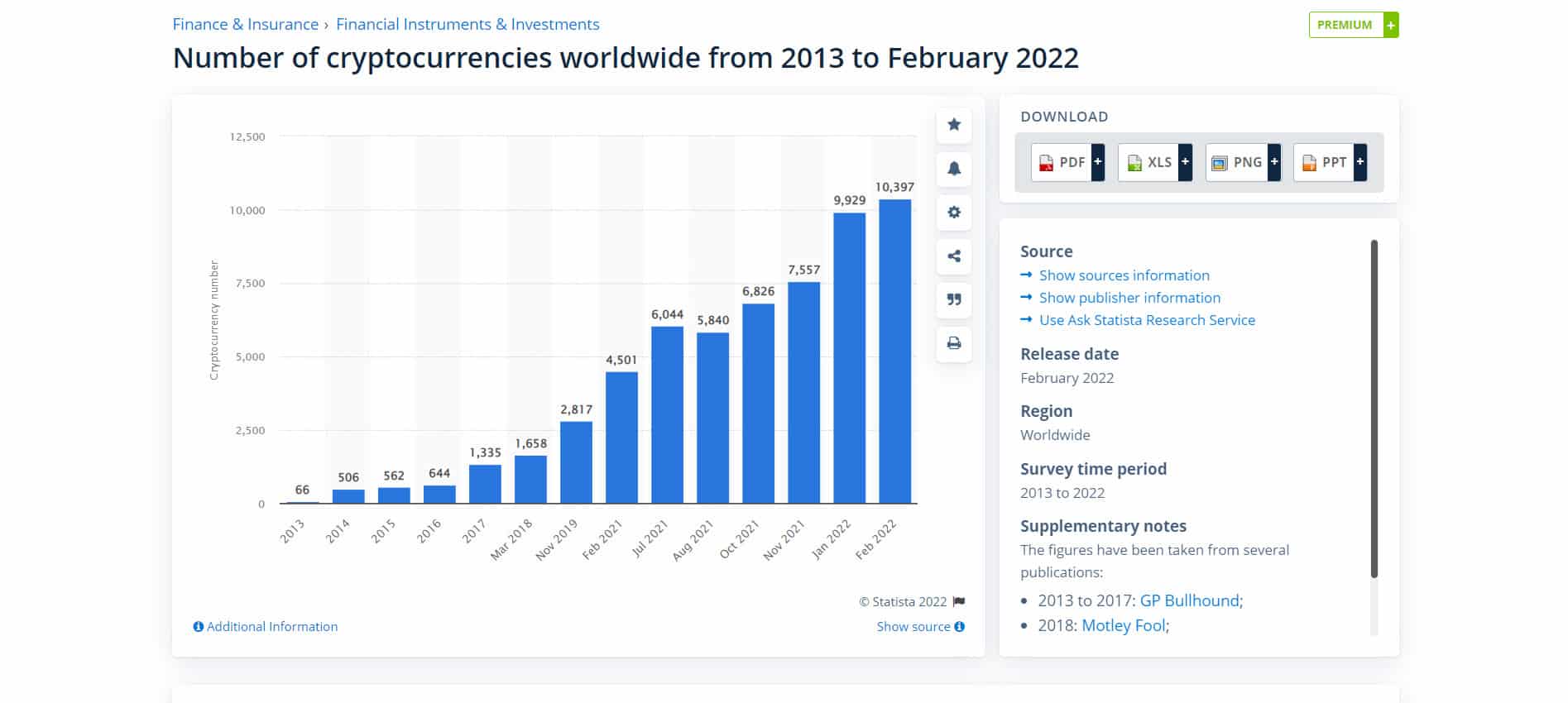
Some of the niches ideas may not have statistics available in Statista. In this case, search for “[keyword] statistics” on Google to show you other sources that provide the latest stats about your niche.

In this niche market example, instead of seeing statistics about marriage, the top-ranking page is about divorce. While both terms are related, Google showing results about the end of a marriage is not a very good sign.
If anything, the results should tell you to consider divorce as your niche instead of marriage or wedding!
Aside from leveraging statistics to determine a niche’s popularity and profitability, you should also search for online communities dedicated to your niche.
The goal is to find lots of communities with thousands of vibrant members discussing the topic in depth.
One of the easiest places to search for these communities is Facebook . Enter your niche topic on the search bar and filter the results to only show posts from public ground and groups that you are a member of.

Reddit is another place to find different subreddits or communities about your niches.
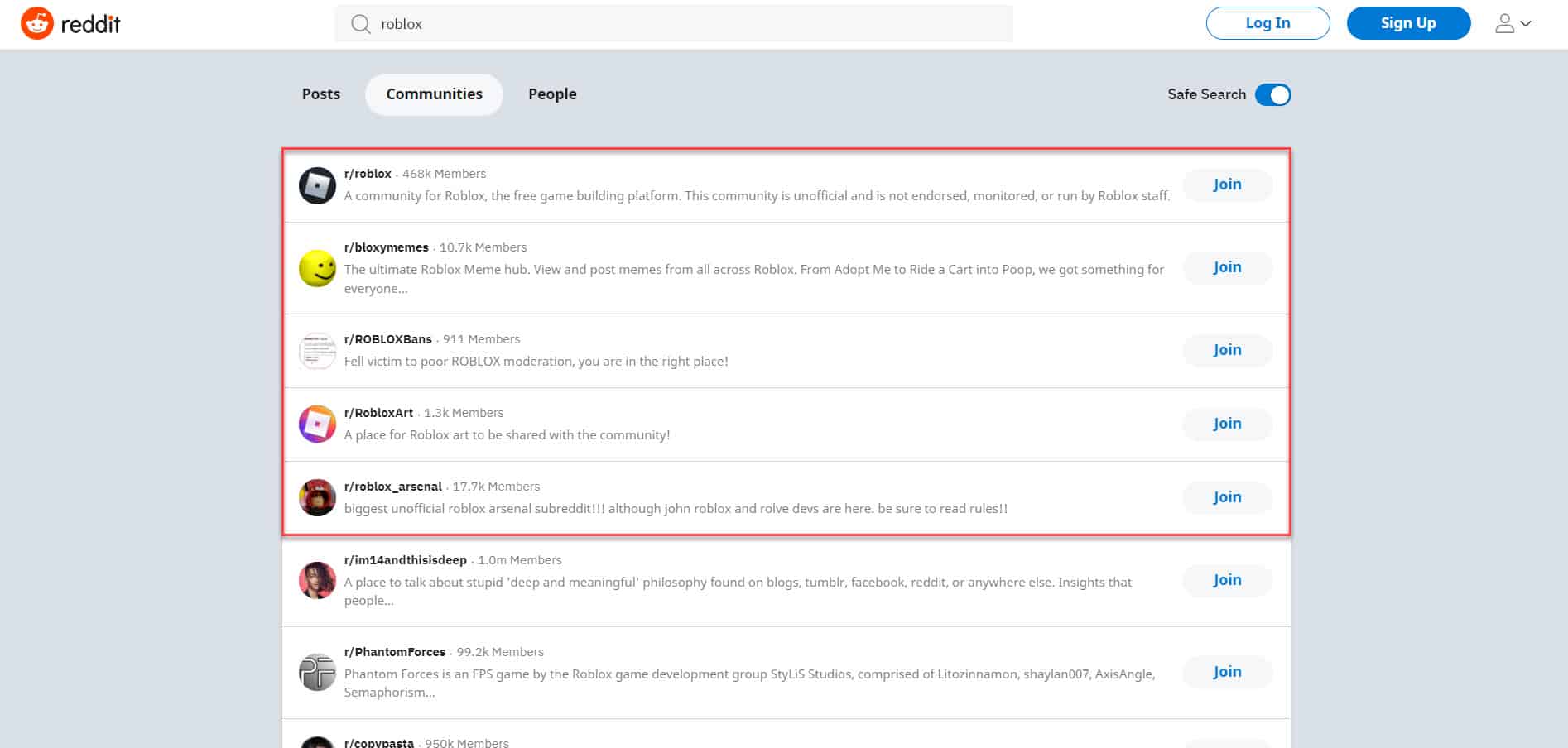
To broaden your search, go to Google search and type “[niche] forums” or “[niche] discussion boards.” Replace [niche] with the niches in your list.
The results should show you forums and discussion boards dedicated to your niche.
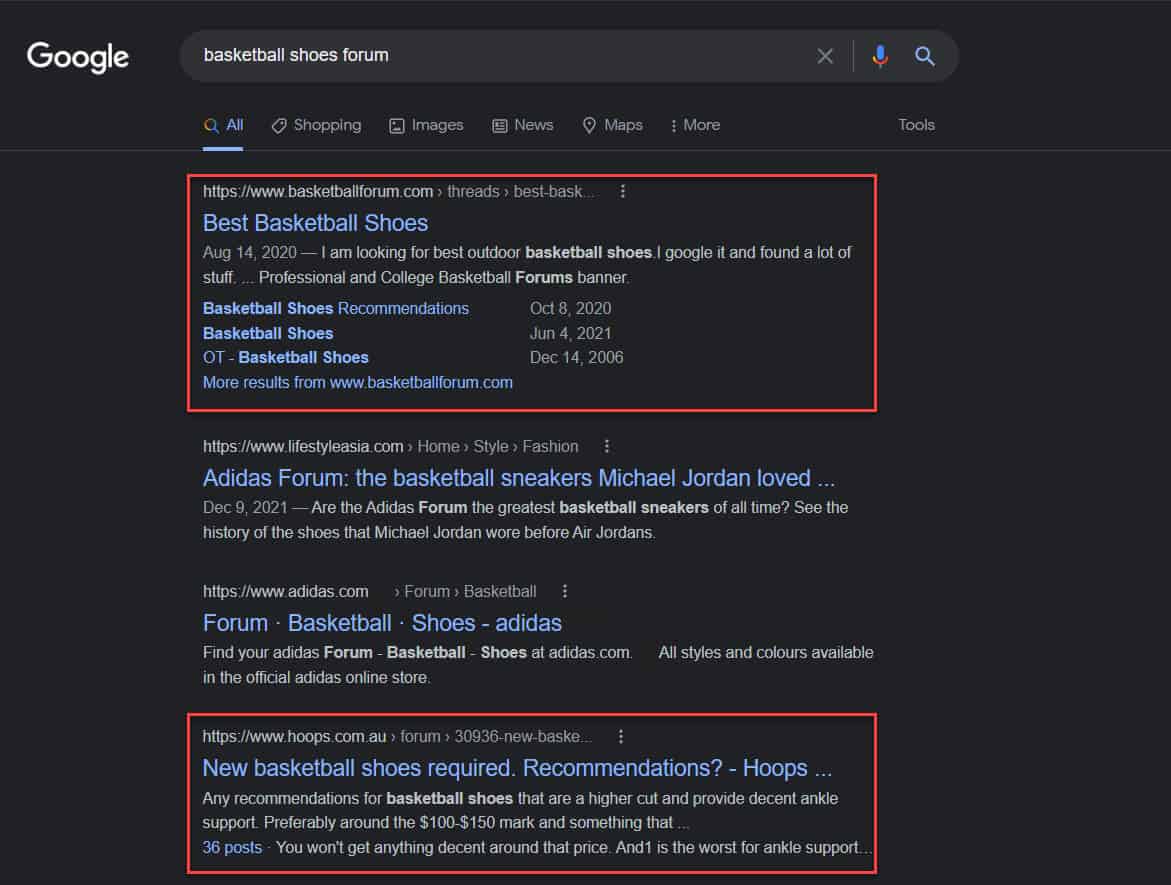
From here, you should open the page to check out the group and see how active and vibrant the community is. How the group admins moderate, the community is also a good indication of the community’s health.
It’s possible to have thousands of members in the community but only have a handful of published posts every week. Or the group could have lots of unrelated and spammy posts.
These are signs that the community is as good as dead. And if all the communities you found about the niche are inactive, it doesn’t bode well for your niche.
Using data from these sources allows you to see how profitable and popular the niches in your list are. Usually, the most popular niches are the most profitable, and your research should suggest that.
So, go with niches that have an upward trend in terms of market shares and interests as well as active communities to support them.
Conduct Keyword Research
In this section, we’ll dive deep into how to determine the feasibility of a niche based on your keyword search.
The goal of keyword research is to identify search terms that will yield your site the most traffic and revenue in the shortest time possible.
And as a traffic source, Google is the best you’ll get. Not only will the traffic be sustainable (you can rank for a search term for a long time), but you’ll also funnel in highly targeted traffic that you can convert into clients or customers.
And to do this, you must find the best keywords for your niche using tools like Ahrefs.
We talked about how you can see your keyword or topic data using its Keyword Explorer feature.

The keyword ideas you’ll find below make the results more valuable. They are organized according to Terms match, Questions, Also rank for, and Also talk about. These give you a better idea about the topic and what people type on search engines related to it.
From here, view all of the Terms match to see the most relevant keywords about the niche.
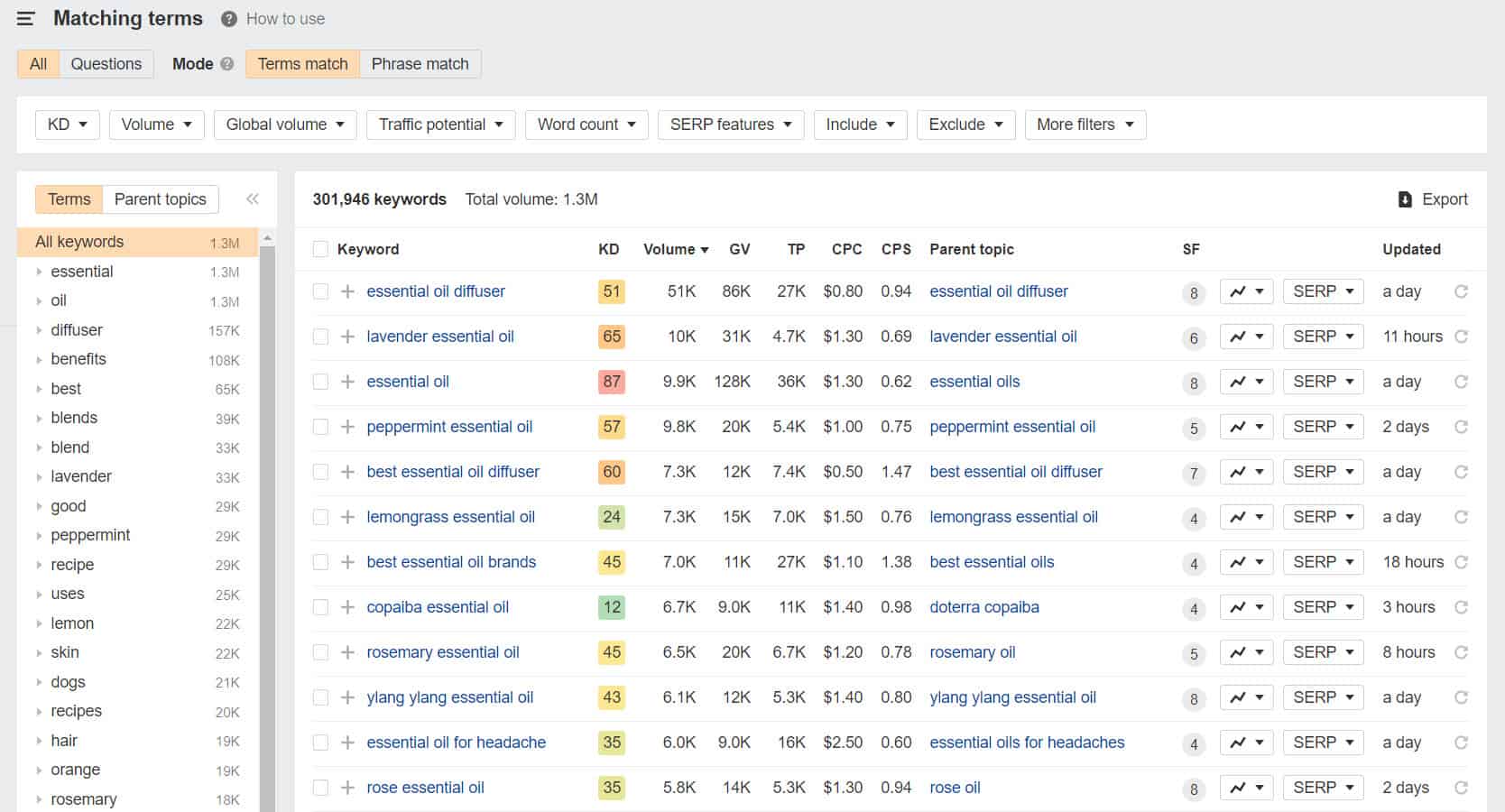
You can then filter the results to narrow down the keywords to the easiest ones to rank for with the most traffic potential.
You may also want to check out our article about Keyword Golden Ratio , which helps you dig down long tail keywords that you can rank for in a matter of days. Filter the results to show you keywords with a maximum KD of 10 and a maximum search volume of 250.
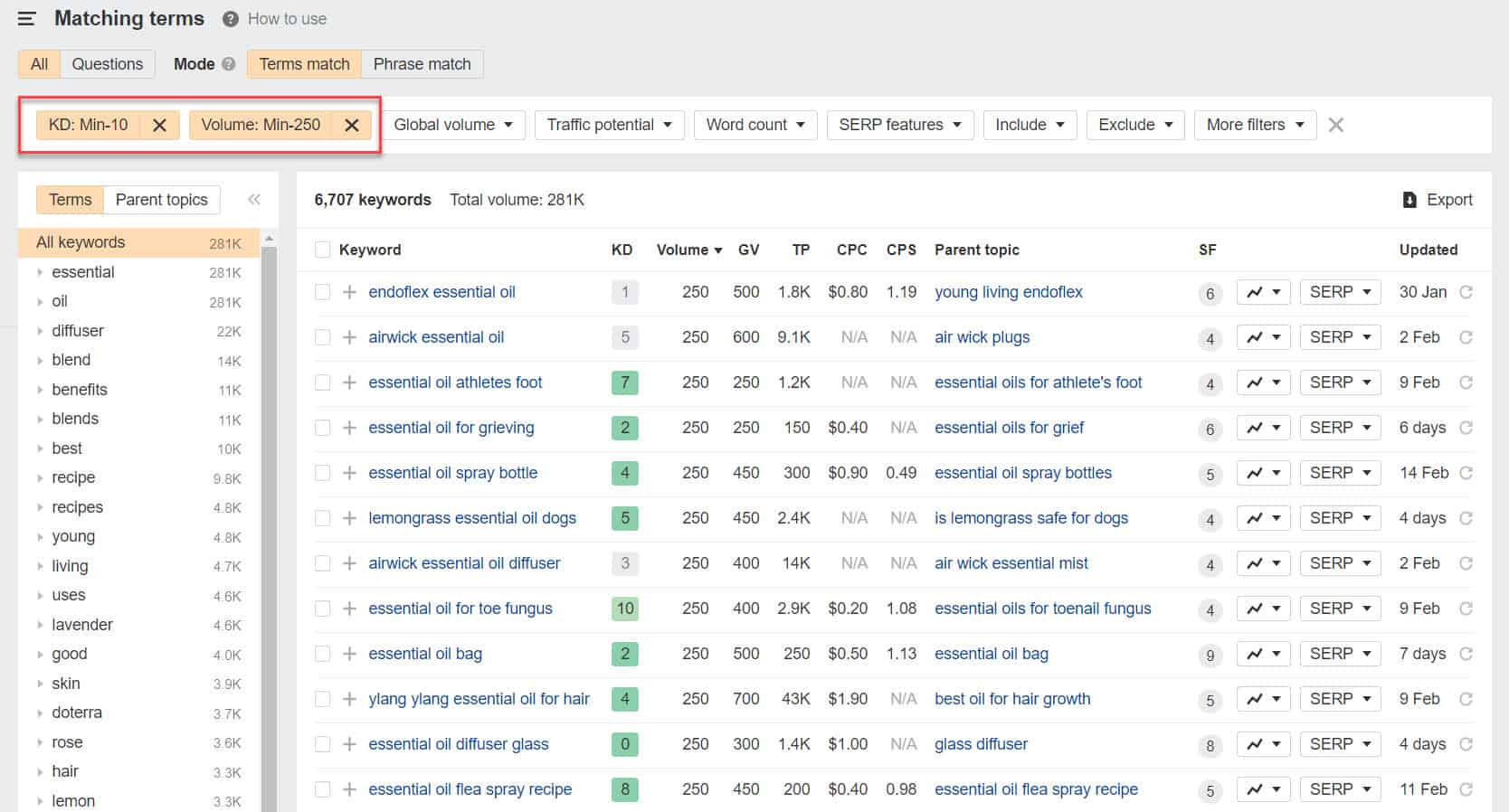
Since you’re building your niche site from scratch, you need to target keywords on your level . This means you can’t target keywords with thousands of monthly searches because you haven’t built enough authority to rank for these yet.
By targeting keywords in line with the principles of KGR, you can slowly but surely build your site to generate traffic soon. And once you do see an increase in organic traffic, you can only refine your keyword research to a traffic tier higher.
After identifying your low-hanging fruit keywords, you need to organize them according to intent .
It’s important to know why people are searching for a keyword in order to create content that satisfies the searcher’s intent.
When it comes to keyword types based on intent, there are four types: informational , navigational , commercial , and transactional .
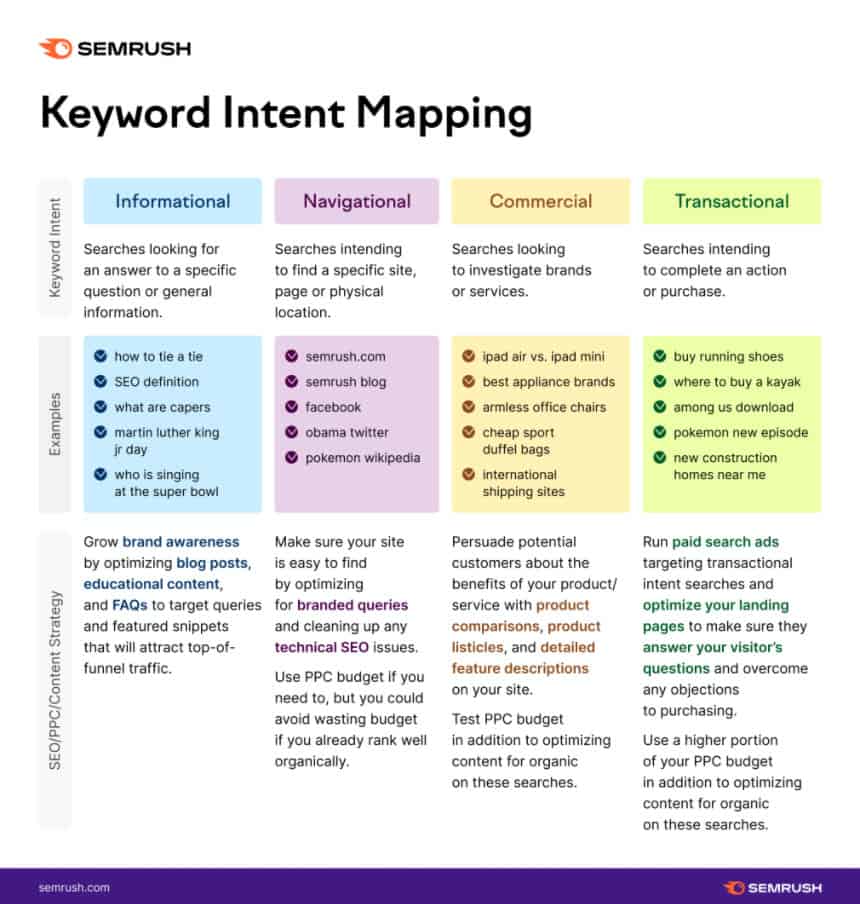
You can group commercial and transactional intent keywords since they share the same goal.
From here, you’ll have a much clearer idea of how to start creating content for your target keywords.
For commercial and transactional keywords, you want to promote products and services that addresses the needs of your audience.
For informational keywords, you want to provide information that can help solve problems of your target audience.
Grouping keywords according to intent is essential to create a balanced web site.
For instance, you can’t create an online store and expect to sell products without educating your audience about what you’re selling.
In this case, informational articles providing use-cases and benefits of your products on sale could potentially result in higher sales.
Identify Pain Points of Your Target Audience
Knowing what plagues the target audience in a particular niche allows you to identify potential solutions for each. This way, you can position yourself as an expert in your niche, producing sales for your online business .
To do this, look for questions people ask about the topic . You can see this in Ahrefs by clicking the Questions tab on the Matching terms page.
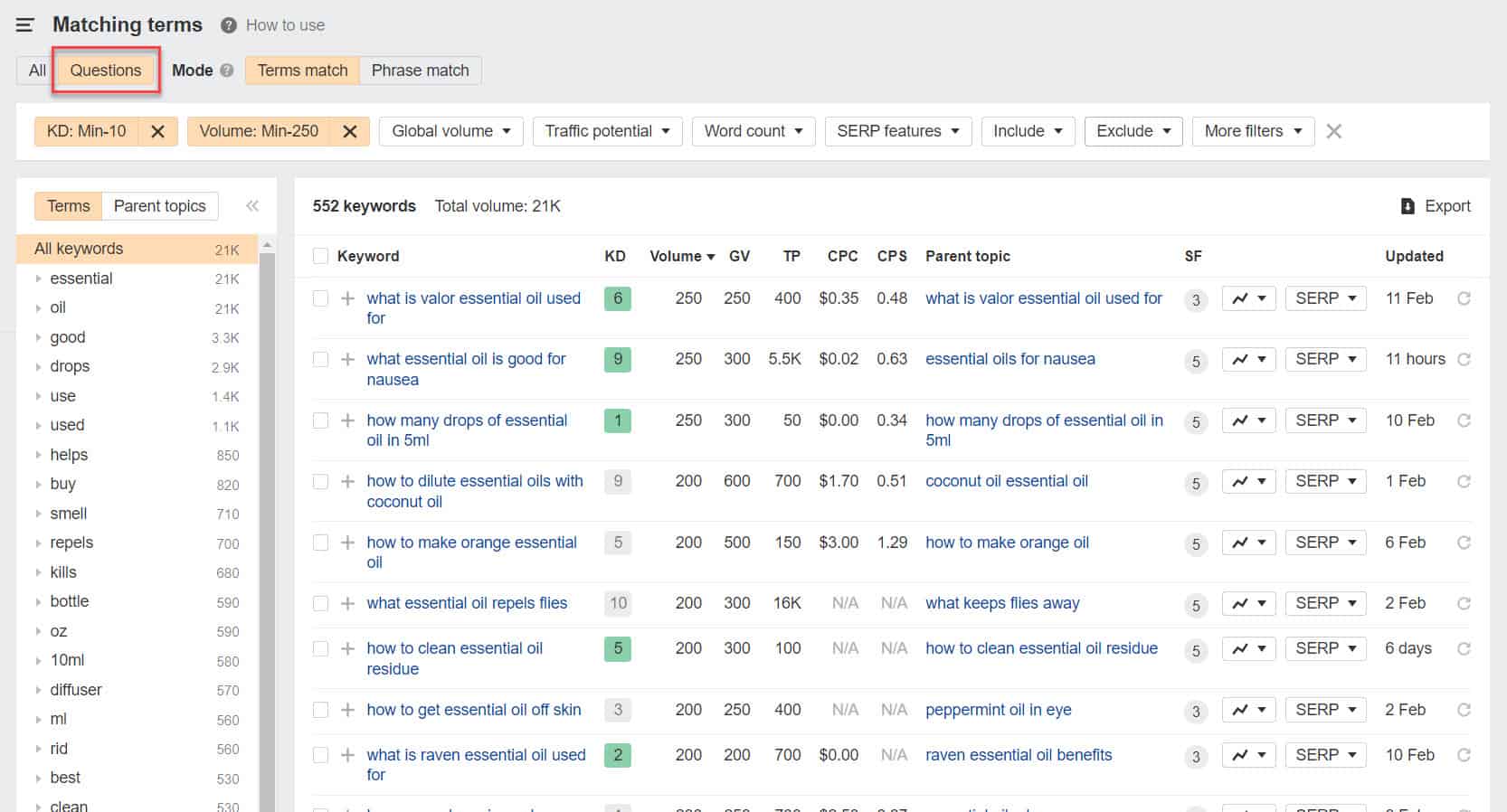
Question keywords have informational intent. You can use these to complement your pages optimized for commercial and transactional keywords.
You can search Google for your niche and look for the People Also Ask (PAA) section on search results page to expand your search further.

If you click on one of the questions, you’ll be able to see its answer and from which page it came. The section also shows two new questions related to the question you opened, thus expanding your research even more.
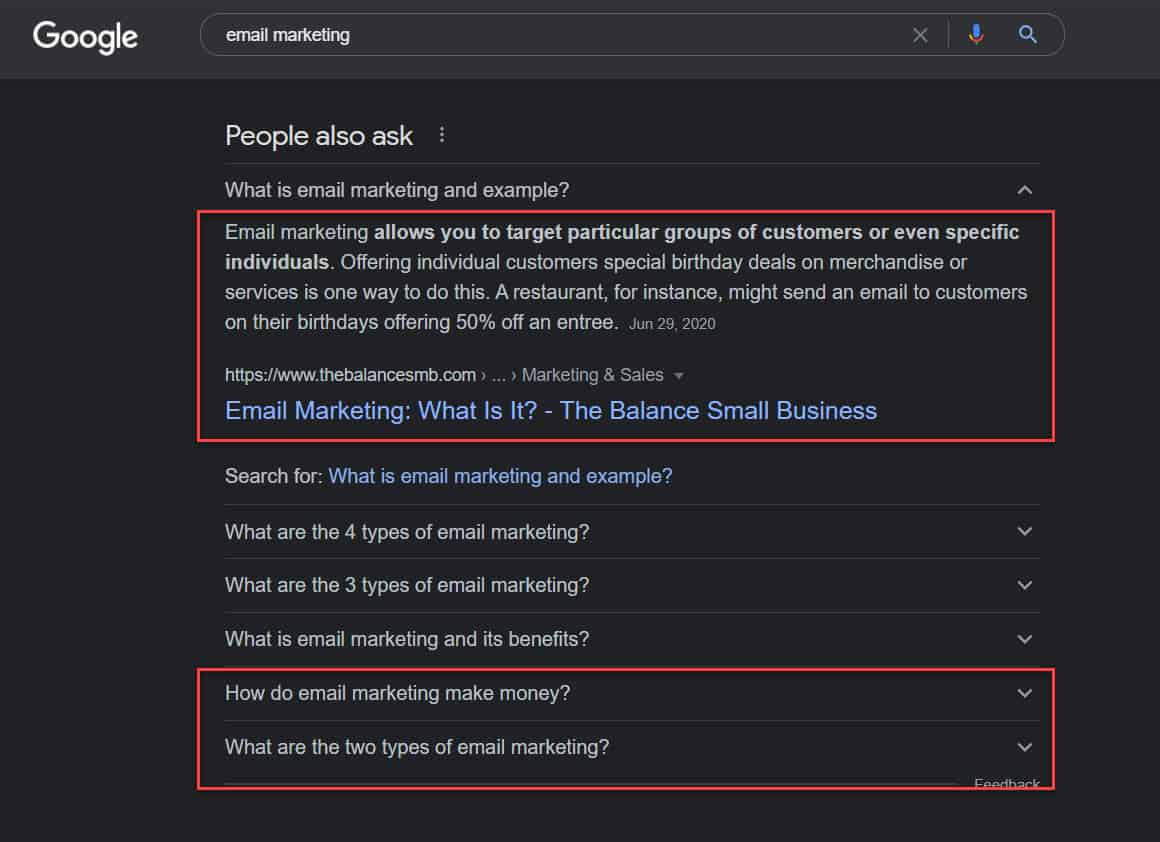
You can also scrape these questions using a Chrome extension like SEO Minion, so you can plug them on Ahrefs to check their search volume.
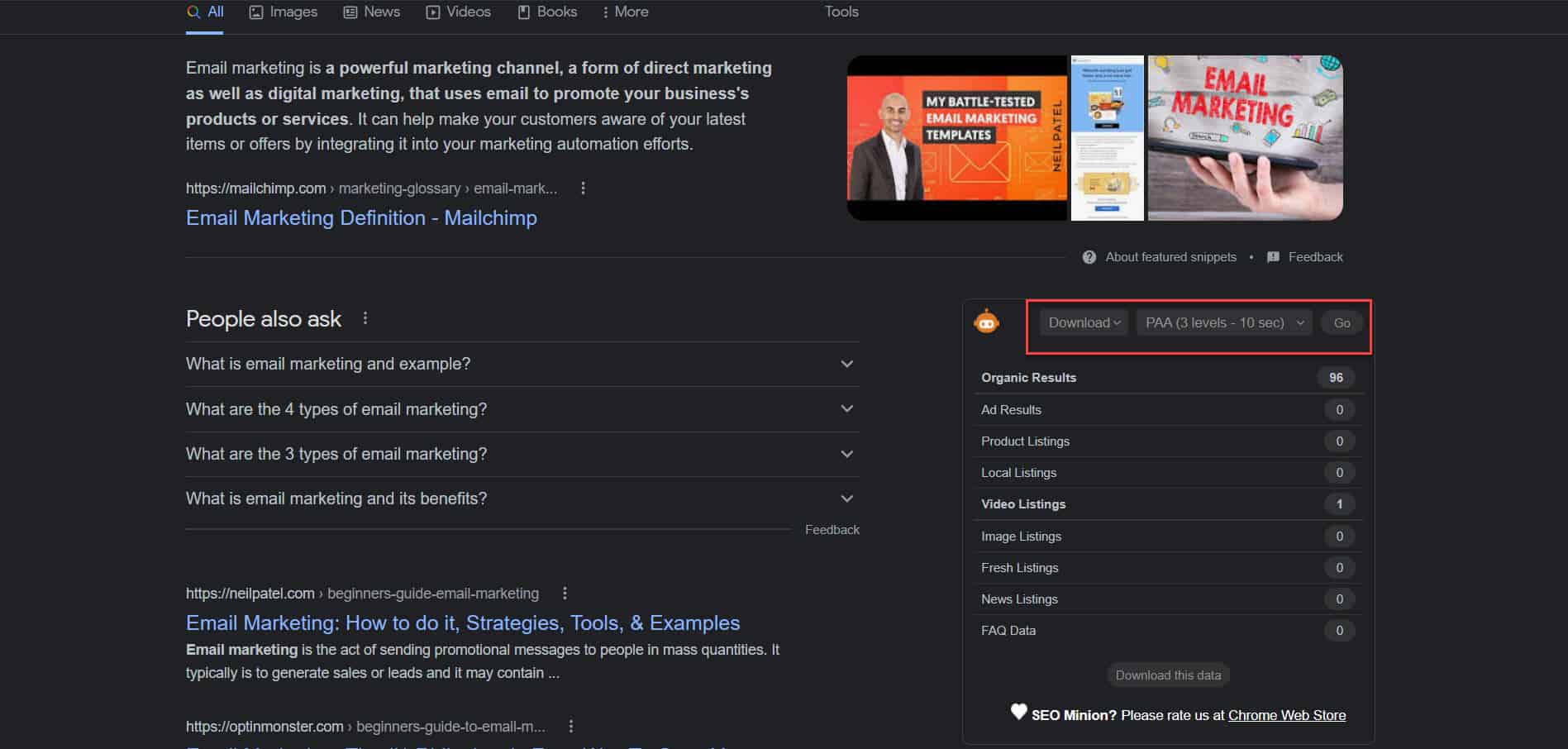
Another tool that helps make PAA scraping much easier is SearchResponse.io . You can view questions in the PAA section of your topic organized according to popularity.
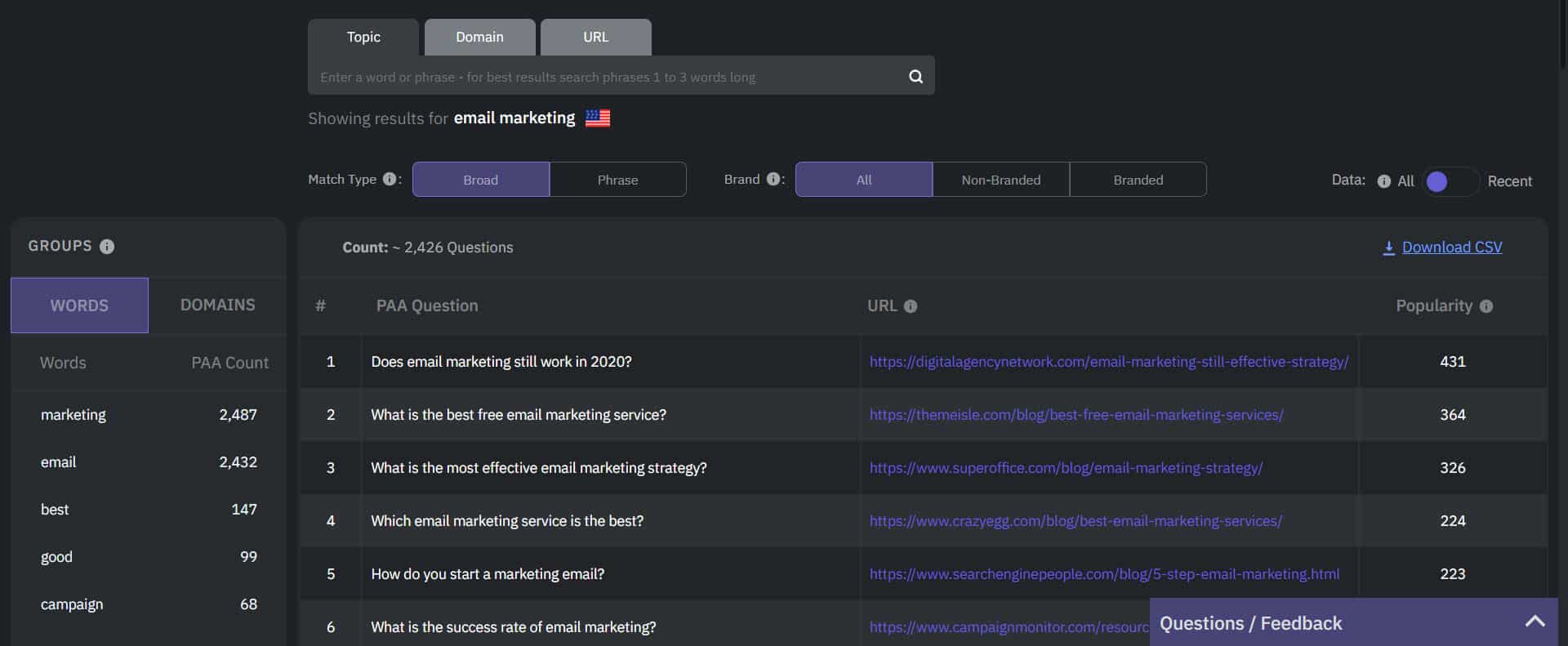
You can also search for questions that a domain or URL is ranking for to help you unearth more keyword ideas for your niche.
You can also use Quora to help you find questions about your target niche.
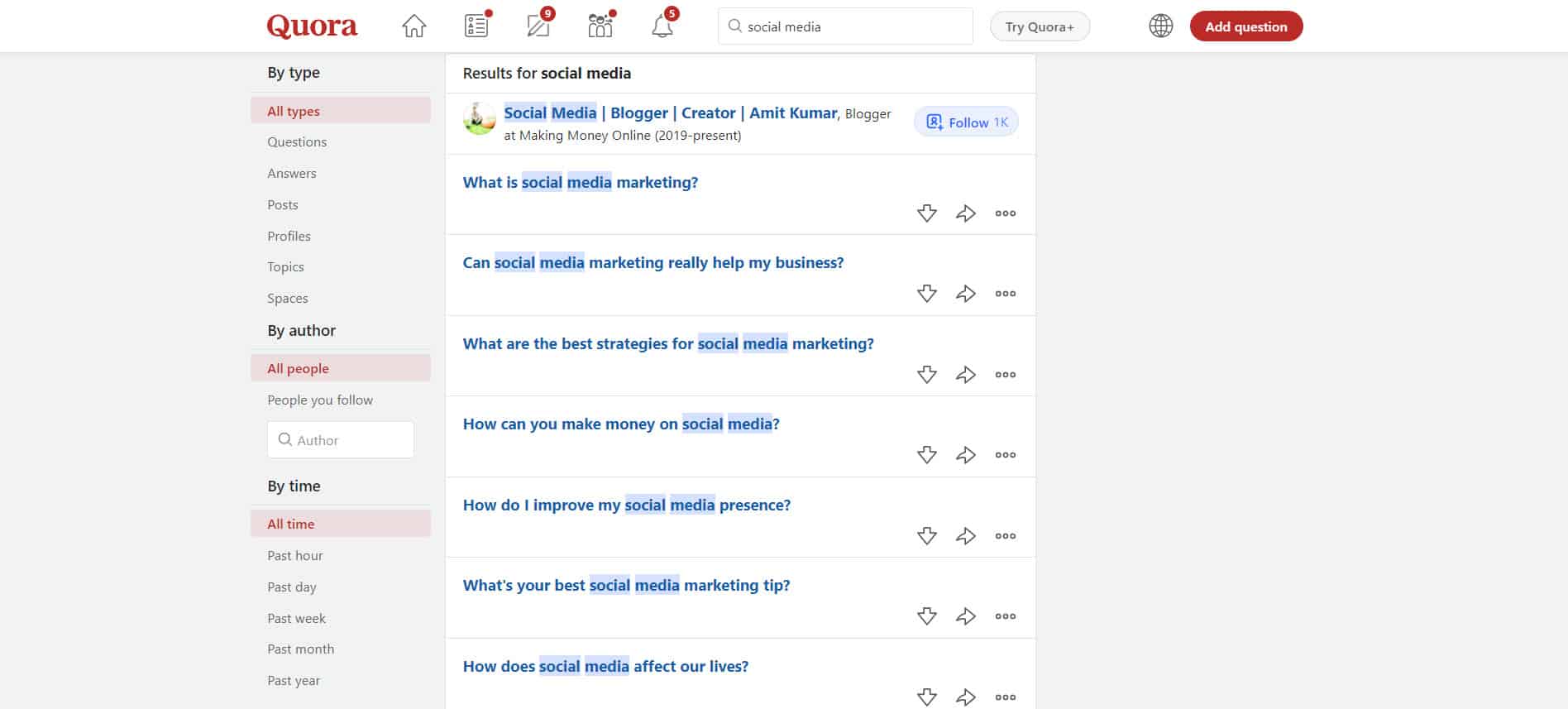
The best thing about Quora is that each question has answers provided by different site users. Users can also vote for what they think is the best answer to the question. You can then see the solutions based on the user-based voting.
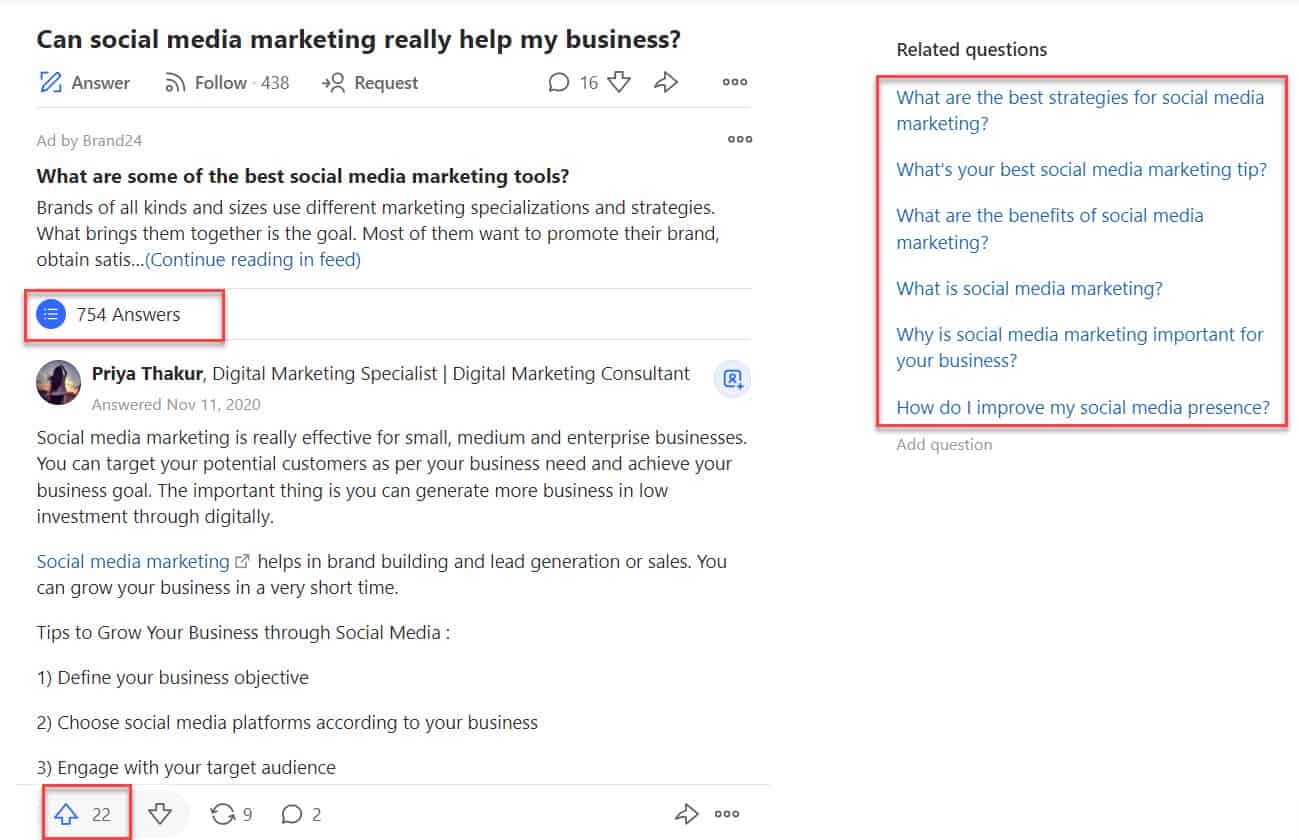
This is important once you’re in the content creation stages of your niche site. You can use the top answers as references to help you create your pages faster.
Of course, we would be remiss if we didn’t list down Answer the Public as one of the tools to help you uncover questions in your niche.
Enter your topic or niche on the search bar to get the top questions asked about it online. You can view it as data where questions are organized according to their modifiers.

You can also get a visual graph of the questions if you prefer a more appealing presentation of the questions.

Regardless, you can be sure to see the most burning questions about your niche here. Collect and compile them so you can jumpstart your content strategy once you’ve decided to build a business with this niche.
Analyze the Competition
To finalize your research, you need to look at the top competitors in your choice of niches.
The kind of competition you’re going up against could determine the success you’ll have with the niche.
If a niche has well-established and continuously growing sites with a decent marketing budget, it will be quite competitive to make money in that niche.
But if a niche’s top sites don’t have sizable traffic and have lots of gaps in their content, this niche is something that you can capitalize on.
To determine how easy or difficult your niche is, we need to refer to Ahrefs again.
Type your topic on Keyword Explorer and click on Traffic shares by domain. This page shows you the domains that receive the most organic traffic from the search terms related to your niche.
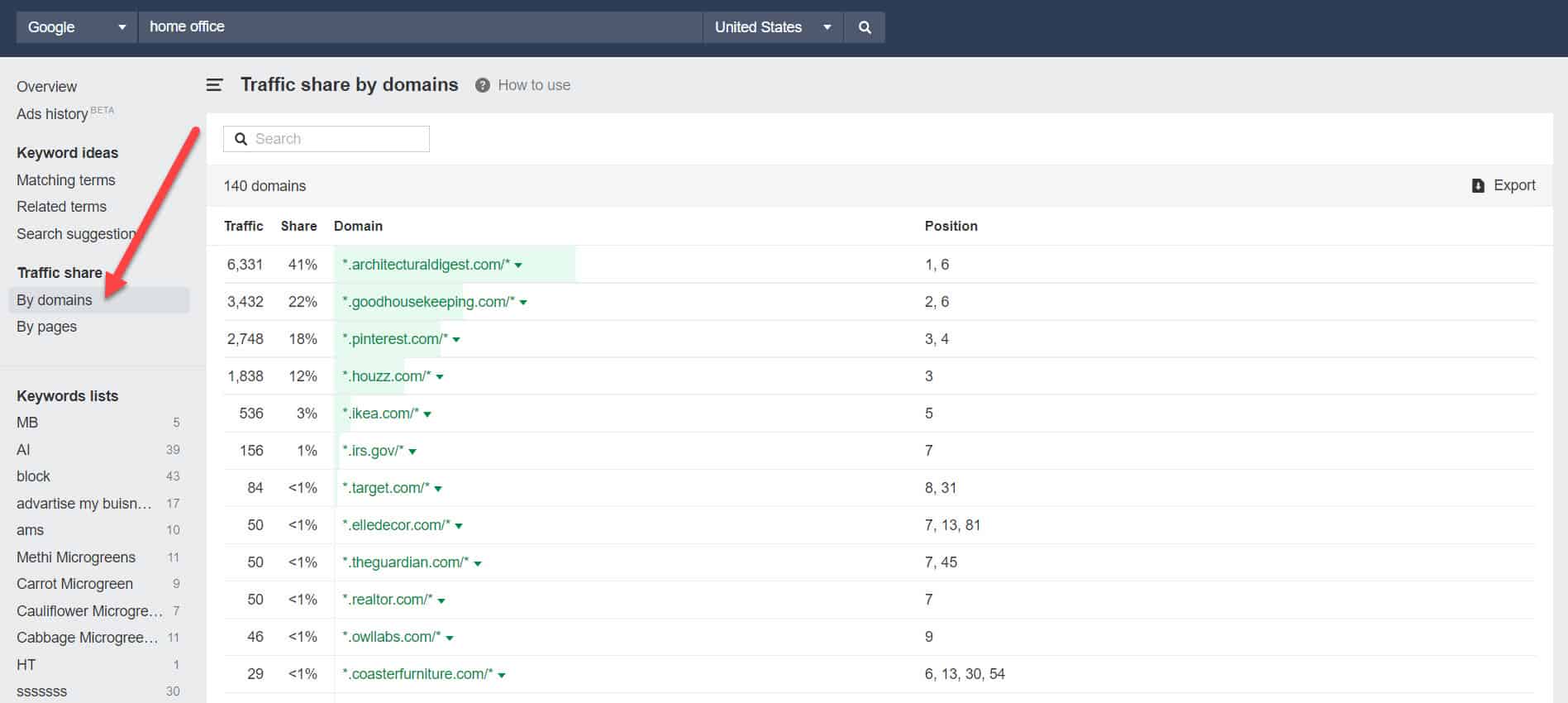
You want to focus on the top 3-5 sites from the list and check each to see how competitive they are.
But before you do, you must identify if any of the top sites are the following:
- Online marketplaces like Amazon, eBay, Etsy, etc.
- Social media platforms like Pinterest
- content aggregate sites like Wikipedia, WikiHow, etc.
- Forum and discussion board sites
If you see these as part of the top domains, ranking for this niche is feasible.
There’s no doubt in anyone’s minds that the sites above are as authoritative as you’ll get online. But these are not niche sites dedicated to a specific topic .
In the example above, Pinterest receives the third most organic traffic for “home office.” It’s probably getting many visitors for Pins of home office ideas in image format.
However, Pinterest is not just a home office site as it hosts other visual content from thousands of niches. The same goes for sites like Amazon, Wikipedia, and others.
They may rake up lots of organic traffic for topics, but that doesn’t make them exclusive to that niche alone.
For this reason, you should highly consider building your online business in this niche!
The fact that non-niche sites are getting the most traffic from the niche, according to Ahrefs, shows a lack of dedicated niche sites in the industry . You can capitalize on this by setting up your website in this niche.
If most top-ranking domains are niche websites, click on each to run Site Explorer. It will show you keywords driving the most traffic to the site, link profile, and more.

When analyzing the keywords they’re ranking for, check for their top performing pages. Read through the content and try to understand why Google is ranking this page on top of search results.
You also need to analyze backlink profile of your competitors. Ahrefs can show you backlinks to help you see an overview of its link building strategy.
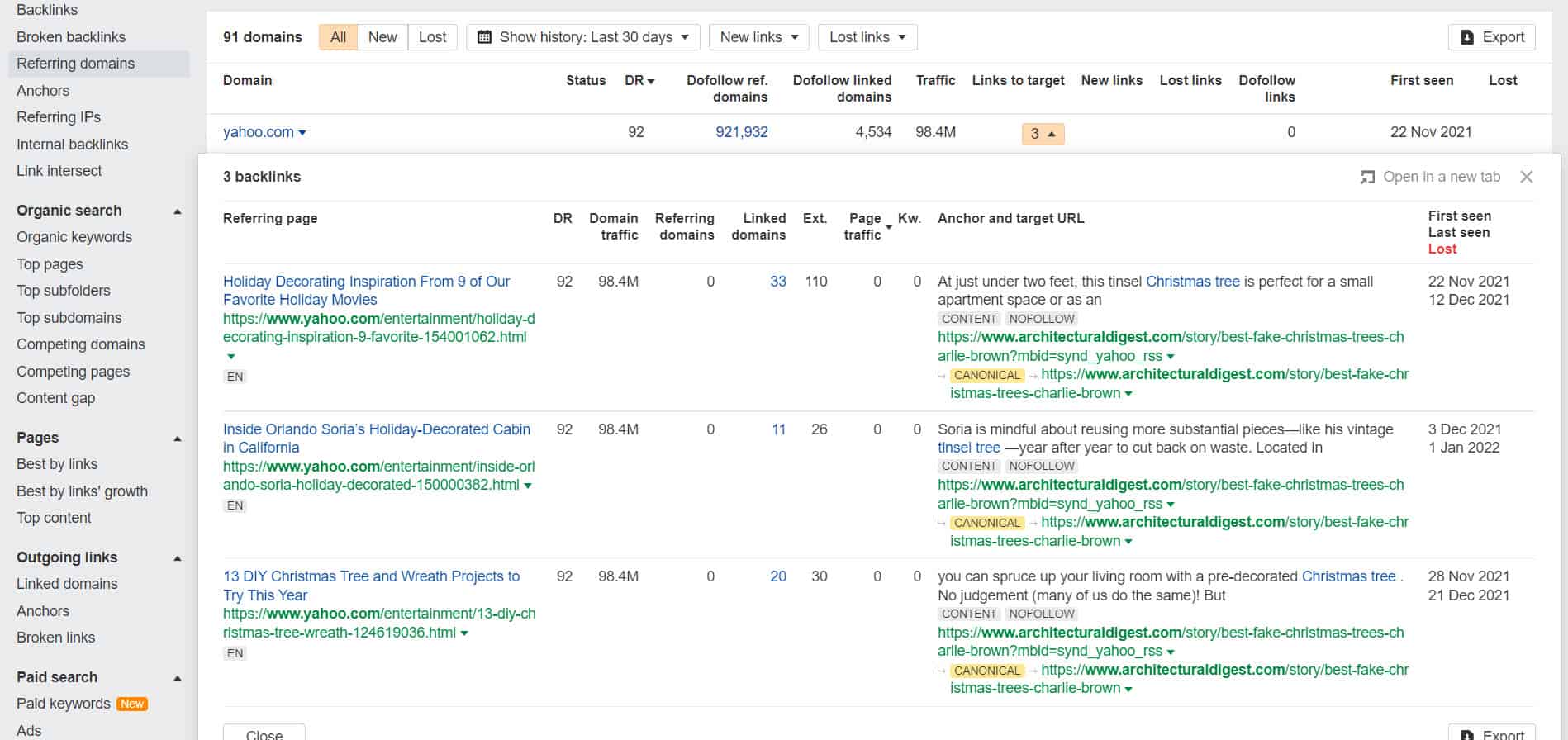
From here, you’ll see the type of backlink they have and from which sites. While you shouldn’t worry about how you plan on getting the same links in the future, this is just to give you an idea of the kind of links you should get once you decide on this niche.
If you want to look at a website holistically , you can run the niche sites you find here through SEOptimer . It’s a freemium tool that checks the site’s overall performance from SEO to social media.
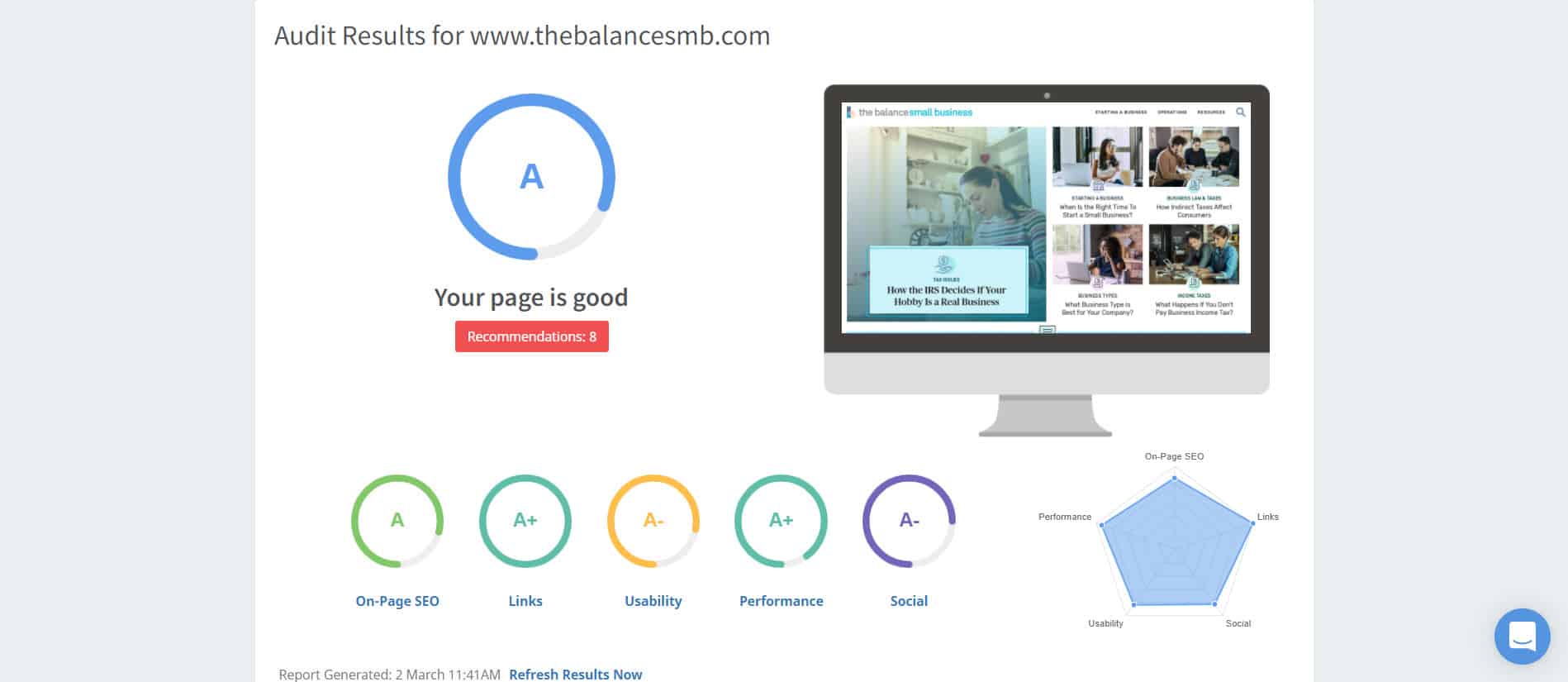
It’s a good tool for taking snapshots of your competitors and finding gaps that you can capitalize on once you’ve decided on going after the same industry they’re in.
Frequently Asked Questions
1. should i follow my passion or pick a money niche.
Launching your online business on a niche you’re passionate about allows you to stay motivated when the going gets tough. You may also have unique insights about the niche you can share with your audience.
On the downside, there’s no guarantee that you can make money off it due to various factors such as lack of market interest or products to sell.
If you decide on a niche you’re passionate about, validate it first by going through the process detailed in this article to help you make an informed decision.
A money niche allows you to profit from the niche much easier and faster. However, you could get bored with the niche and abandon it even if you’re making hundreds and thousands of dollars off it.
The reason? Your heart isn’t in it.
Some people first build a site on a money niche to help fund their passion projects. This is a great way to capitalize on a profitable niche without grinding away at it for years.
2. Is it better to create a specific niche site or a broad niche site?
Both have their own pros and cons.
Narrow and specific niche sites are easier to establish credibility and attract an audience since you’re catering to a specific problem of a specific target audience. As a result, it allows you to generate sustainable organic traffic in the long run.
But specific niche sites are limited in growth and traffic. Once you’ve exhausted the content ideas, there’s not much you can do to grow it.
On the upside, you can sell it on website marketplaces for a fortune. You can then use the earnings to fund your next niche project.
Broad niche sites have lots of growth potential. You can publish articles and sell products you want since you’re not confined to a specific topic.
But herein lies the problem: by catering to your whims, you end up not catering to anyone else. It’s also challenging to build topic relevance with a broad niche website. This results in Google not ranking your pages despite having good content on your website.
3. Is it easier to sell many cheap items or a few expensive items?
Cheap items sell the most, but you must find a way to sell as many of them as possible. That means creating points of entry where your audience can learn more about them so they can buy them.
You can do this by simply creating blog posts that target informational and commercial intent keywords.
For expensive items, blog posts won’t cut it. You may need to get hands-on in the sales process to ensure that people end up buying your product.
Ideas to achieve this include scheduling a product demo with them to personally educate them and teach them how the product works.
Ultimately, cheap items are much easier to sell because they don’t require much hand-holding from you to make a sale.
Niche research is the most challenging and time-consuming aspect of launching a profitable business, and rightfully so. Your site’s success hinges on the legwork you put in researching your niche inside out.
Hopefully, this article gives you direction on how to approach finding your target niche.
Most of the research deals with SEO data since it’s the easiest and most sustainable traffic source out there.
Nonetheless, the process above should narrow down your selection to around a handful of niches to choose from. Once you decide which one to build a business on, the real fun begins!
You can accurately track niche site’s keyword rankings and keep track of the websites dominating the niche with Keyword.com. Want to take it a step further? Check out our keyword ranking API .
THE KEYWORD RANK TRACKER
For smart, passionate seos that drive the industry forward.

- Product Tour
- Who We Help
- Release Log
- Testimonials
- Affiliate program
- Help Center
- Terms of Service
- SEO Wiki & Glossary
- Privacy Policy
- Cookie Policy
Niche Market: How to Identify Tools and Techniques

Exploring a niche market involves specialized strategies. The key to success is identifying the right tools and techniques for precise market analysis. Utilizing resources like Google Trends and social media listening tools, businesses can delve into consumer preferences and emerging trends. Techniques like detailed market analysis and direct consumer research are crucial.
Table of Contents
This approach uncovers niche opportunities and guides in interpreting data to tailor products and services effectively. Businesses can strategically position themselves in their chosen niche market by focusing on these areas, ensuring a more targeted and successful marketing approach.
Introduction to Niche Market Research
Niche markets represent a specific, often underserved segment of a larger market. They are characterized by unique needs and preferences, differentiating them from the broader market. For example, vegan skincare products are an example of niche markets within the more significant cosmetics industry. Catering to such niches involves understanding their specific demands, which can significantly differ from the mainstream market.
The allure of examples of niche markets lies in their potential for businesses to establish a robust and loyal customer base. Unlike mass markets, niche markets allow for a more personalized approach, fostering a deeper connection with consumers. This specificity, however, demands precise and targeted market research to ensure that the product or service accurately meets the unique needs of the niche.
Importance of Targeted Research
Targeted research, for example, of niche markets is crucial. For instance, a company focusing on eco-friendly baby products must understand the general market for baby products and the specific preferences, buying behaviors, and values of environmentally conscious parents. This targeted research helps create products that resonate deeply with this segment, leading to higher customer satisfaction and loyalty.
Moreover, examples of niche markets often compete less, allowing businesses to become market leaders. However, this requires a thorough understanding of the niche, which can only be achieved through diligent research.
Tools for Niche Market Research
Digital Analytics Tools: Tools like Google Analytics offer insights into website traffic. They help businesses understand their niche audience’s origins. These tools also show how users interact with businesses’ online presence.
Keyword Research Tools: Tools such as Google Keyword Planner or SEMrush can help identify the search terms and phrases most relevant to the niche market. This is key to understanding what the target audience is looking for online.
Techniques for Niche Market Research
Consumer Surveys and Interviews: Direct feedback from potential or current customers provides invaluable insights into their needs and preferences.
Competitor Analysis: Understanding how competitors cater to the niche market can reveal gaps in the market and opportunities for differentiation.
Social Media Listening: Monitoring social media conversations around specific topics related to the niche market can unveil consumer opinions and trends.
Niche market research requires a blend of specific tools and techniques to deeply understand and cater to examples of niche markets, which are well-defined market segments. Businesses can find unique opportunities in these niche markets through targeted research.
This allows them to tailor their offerings more effectively. As a result, they can build a robust and dedicated customer base. The upcoming sections will delve deeper into each of these tools and techniques, providing a comprehensive guide to mastering niche market research.
Identifying Your Niche Market
Identifying a specialized market is essential for the success of businesses. This enables them to distinguish themselves in a competitive market. Capitalizing on this niche is critical. Understanding how to find your niche market is a process that involves research, analysis, and a deep understanding of both your strengths and customer needs.
Understanding What Makes a Niche Market
A niche market is a specific, often underserved, segment of a broader market. It has unique needs and characteristics that set it apart from the general marketplace. For instance, within the large market of beauty products, organic skincare for sensitive skin represents a niche.
To understand how to find your niche market, you must look for subsets within larger markets where existing products or services still need to meet customer needs fully.
Steps to Identify Your Niche Market
Assess Your Interests and Expertise: Look at your skills, interests, and professional background. A successful niche business often stems from an entrepreneur’s passion or area of expertise. For example, a professional photographer might find a niche in drone aerial photography, combining technical skills with a passion for photography.
Market Research: Perform comprehensive market research on how to find your niche market to pinpoint potential niche opportunities. Look at industry trends, market reports, and consumer behavior data. This step is crucial in understanding what customers are looking for and what is currently available in the market.
Analyze Customer Pain Points: Identify problems or gaps in existing markets by looking at customer feedback, reviews, and forums related to your industry. Understanding customer pain points can reveal opportunities for niche markets. For instance, in the fitness industry, a business might identify a niche in creating fitness programs for people with specific health conditions like arthritis.
Evaluate Market Size and Potential: While a niche market is smaller, it must still be large enough to be profitable. Use tools like Google Trends and keyword research to gauge interest levels and search volumes for potential niche ideas.
Competitor Analysis: Examine your potential competitors. A lack of competition can indicate an untapped market and a non-viable market. Conversely, high competition might require further niche refinement to find a unique angle.
Test Your Idea: Before fully committing, test your niche idea. This could be through a minimum viable product (MVP), a pilot service, or market surveys. The feedback from this testing phase is invaluable in refining your niche market focus.
Finalizing Your Niche
After these steps on how to find your niche market, narrow down your focus to a niche that aligns with your strengths, has a sufficient market size, and where you can offer unique value. This might require revisiting and refining your idea several times. The goal is to balance your interests, market demand, and competitive landscape.
Discovering how to find your niche market involves a strategic blend of self-assessment, market research, and consumer insights. It’s a process that requires patience and a willingness to adapt and refine your approach based on what the data reveals. Once you’ve identified a promising niche, you can focus on building a tailored strategy to reach and serve your targeted audience effectively.

Leveraging Google Trends for Niche Market Insights
Google Trends is a powerful tool for uncovering valuable insights into market interests and trends, especially regarding niche market items. By analyzing search patterns and volumes, businesses can gain deeper insights.
They understand consumer interest and demand in specific areas. This section provides a detailed guide on using Google Trends effectively and case studies demonstrating its practical applications.
Understanding Google Trends
Google Trends assesses the popularity of search queries across diverse regions and languages. The tool provides data on search volume over time, which can be instrumental in identifying emerging trends or declining interest in specific products or topics.
How to Use Google Trends for Niche Market Research
Identify Keywords: Identify keywords relevant to your niche market items. These may include product names, industry terms, or related concepts.
Analyze Search Volume Over Time: Enter your keywords into Google Trends to see how search interest has varied. A rising trend can indicate growing interest in a niche market item, while a declining trend might suggest decreasing popularity.
Geographical Interest: Google Trends shows the regions or countries with the highest search volume. It does this for your chosen keywords. This can help in identifying potential markets for your niche products.
Related Queries: The tool also shows associated queries, which can provide insights into related products, consumer questions, or emerging trends in your niche.
Comparisons: You can compare multiple keywords to understand relative popularity or explore the interest in different niche items.
Case Studies and Examples
Case Study – Eco-Friendly Products: A company specializing in eco-friendly household items used Google Trends to monitor the popularity of terms like “biodegradable products” and “eco-friendly home goods.” They discovered a steady increase in search volume over several years, confirming a growing market interest. This insight led to the expansion of their product line in this category.
Example – Health Food Trends: A health food retailer used Google Trends to track the interest in “keto snacks.” The data showed a significant spike in searches at the beginning of each year, likely due to New Year resolutions. This insight helped the retailer plan their inventory and marketing strategy around these periods.
Leveraging Seasonal Trends
Google Trends can also be a valuable resource for recognizing seasonal surges in interest for specialized niche market items. For instance, search interest in “gourmet chocolate gifts” might peak during the holiday season, indicating the best times for businesses to increase their marketing efforts or stock availability.
Google Trends is a versatile and powerful tool for researching niche market items. It provides valuable insights into consumer interests, emerging trends, and seasonal fluctuations. Businesses can use this tool to make informed decisions about niche market items. They can focus on product development, marketing strategies, and market entry timing. This helps them stay ahead in their niche markets.
Social Media Listening for Niche Markets
In the digital age, social media listening has become an indispensable tool for businesses looking to tap into niche markets. With the vast amount of data available on social platforms, companies can gain insights into consumer preferences, behaviors, and emerging trends. This section will explore how social media listening can be leveraged to refine niche market business ideas.
What is Social Media Listening?
Social media listening, especially in the context of niche market business ideas, involves monitoring digital conversations to understand what is said about a brand, industry, or specific online topics.
This process goes beyond merely tracking mentions or comments; it involves analyzing the mood, context, and trends behind these conversations. Social media listening tools like Hootsuite, Brandwatch, and Sprout Social can track keywords, hashtags, and topics across various platforms, providing businesses real-time insights.
Gathering Consumer Insights
Identify Relevant Keywords and Hashtags: Identify keywords, phrases, and hashtags relevant to your niche market business ideas. These could relate to specific products, industry buzzwords, or competitor brand names.
Monitor Conversations and Trends: Use social media listening tools to monitor how these keywords are used across different platforms. This can reveal consumer attitudes, pain points, and frequently asked questions about niche market items.
Analyze Sentiment: Many social media listening tools offer sentiment analysis, particularly in the context of niche market business ideas. Understanding whether the sentiment around specific topics or products is positive, negative, or neutral can guide how you approach your niche market strategy.
Spot Emerging Trends: You can identify emerging trends within your niche by tracking how conversations evolve. For example, a spike in discussions around sustainable packaging in a food niche market could signal a shift in consumer preferences.
Case Studies: Applying Social Media Listening
Health and Wellness Products: A company specializing in gluten-free foods used social media listening to understand common complaints and desires among gluten-intolerant consumers. By analyzing conversations, they identified a need for more tasty gluten-free snack options, leading to the development of a new product line.
Eco-Friendly Fashion: An eco-friendly clothing brand monitored discussions around sustainable fashion. They noticed a trend in consumers seeking more transparency about product sourcing and sustainability practices, prompting them to adjust their marketing strategy to highlight these aspects.
Utilizing social media listening is a potent tool for businesses delving into niche market business ideas. It provides information on consumer preferences, behaviors, and emerging trends, which is invaluable for tailoring products and services to a specific market. Businesses can stay ahead by using social media listening techniques effectively. They adapt to consumer needs and preferences in real-time. This leads to success in their niche markets.

Advanced Niche Market Analysis Techniques
Developing a niche marketing strategy requires more than just understanding your target audience; it involves deep diving into the market dynamics through advanced analysis techniques. This section delves into various methods for conducting in-depth market analysis and leveraging data analytics and other tools to understand niche market dynamics comprehensively.
In-Depth Market Analysis Techniques
Segmentation Analysis: This involves breaking the market into smaller segments based on various criteria like demographics, psychographics, and buying behaviors. For example, in a niche market for luxury vegan skincare, segments could be based on age, income level, or even values and lifestyle.
Competitive Analysis: This entails thoroughly analyzing competitors within the niche marketing strategy. Tools like SWOT analysis help understand competitors. They reveal strengths, weaknesses, opportunities, and threats. Your business can use this to capitalize on competitors’ weaknesses and strategies.
Trend Analysis: This technique involves examining market trends over time. Understanding historical data and current trends is crucial in predicting future market movements and making informed decisions.
Consumer Behavior Analysis: This requires studying how consumers in the niche market behave – what they buy, how they make purchasing decisions, and what influences them. This information is vital in tailoring your marketing strategy to meet their needs.
Leveraging Data Analytics
Predictive Analytics: By analyzing past consumer data, predictive analytics can forecast future buying patterns and preferences within a niche market. This can guide product development and marketing efforts.
Customer Journey Analytics: This involves tracking and analyzing how customers interact with your brand across various touchpoints as part of your niche marketing strategy. Understanding this journey helps in optimizing the customer experience and improving engagement strategies.
Sentiment Analysis: This technique, often used in social media listening, assesses the sentiments expressed in customer feedback and online discussions. It’s crucial for understanding public perception and tailoring your messaging.
Tools and Resources
Google Analytics: For digital businesses, Google Analytics provides valuable insights into website traffic, user behavior, and conversion data, which can inform your niche marketing strategy.
CRM Systems: Customer Relationship Management (CRM) systems track customer interactions, purchases, and feedback. They provide a wealth of data for analysis.
Market Research Software: Tools like Qualtrics or SurveyMonkey can help conduct detailed market research, gathering data directly from consumers in your niche market.
Case Study: Sustainable Fashion Niche
A sustainable fashion brand utilized segmentation analysis to understand different customer groups within their niche. They used data analytics to track buying patterns and customer feedback, which informed their product design and marketing campaigns. This targeted approach increased customer loyalty and higher sales within their niche.
Advanced niche market analysis techniques and robust data analytics tools are essential in crafting a successful niche marketing strategy. By thoroughly understanding market dynamics, consumer behavior, and competitive landscapes, businesses can position themselves effectively within their niche, ensuring long-term growth and success.
Conducting Effective Consumer Research for Niche Market
In niche marketing, understanding your audience is critical to success. For businesses focusing on examples of niche market products, conducting consumer research is essential in gathering valuable insights. This section explores the effective methods of collecting consumer data through surveys, interviews, and other techniques, along with best practices for designing and conducting this research.
Surveys: Surveys are a versatile tool for collecting quantitative and qualitative data. Online platforms like SurveyMonkey or Google Forms can be used to reach a wider audience. For instance, a company specializing in eco-friendly athletic wear could use surveys to understand consumer preferences for materials, design, and pricing.
Interviews: Personal interviews, whether in-person or virtual, provide in-depth insights. They are handy for understanding the motivations and emotions behind consumer choices. For example, interviews with users of organic skincare products can reveal deeper reasons behind their brand loyalty or product preferences.
Focus Groups: Bringing together a small group of target customers can lead to rich discussions and valuable insights, especially for testing examples of niche market products or concepts.
Observational Research: Observing how consumers interact with products in a natural setting can provide unfiltered insights. This can be incredibly impactful in retail settings.
Designing Consumer Research
Define Your Objectives: Define your research objectives and what you aim to discover, mainly when focusing on examples of niche market products. Are you trying to understand buying behavior, product preferences, or brand perceptions?
Choose the Right Method: The method best fits your research objectives. Surveys are great for broad questions, while interviews and focus groups are better for in-depth exploration.
Craft Your Questions Carefully: Questions should be clear, unbiased, and structured to encourage honest and thoughtful responses.
Segment Your Audience: Tailor your research to specific segments within your niche market. This can provide more targeted insights.
Best Practices for Conducting Consumer Research
Incentivize Participation: Offering incentives can increase participation rates, especially in niche markets where the audience might be smaller.
Ensure Anonymity and Confidentiality: Assure participants that their responses are confidential. This encourages honesty and increases the quality of the data collected.
Analyze and Act on Findings: Collecting data is only the first step. Analyzing and implementing the insights into your business strategy is crucial.
Case Study: Specialty Coffee Products
A specialty coffee brand used consumer surveys to understand preferences in coffee flavors and brewing methods. The insights gained led to the development of a new line of flavored coffee beans, which resonated well with their niche market and resulted in increased sales.
Effective consumer research is vital for businesses focusing on examples of niche market products. Companies can gather profound insights into consumer needs and preferences by employing the proper techniques and adhering to best practices. This information is invaluable in developing and marketing examples of niche market products that resonate with the target audience, ultimately driving their success.

Interpreting Research Data to Identify Niche Market Opportunities
One of the most crucial stages in devising a marketing strategy for niche markets is interpreting research data for examples of niche market products to unearth valuable insights. This data can reveal patterns and opportunities when correctly analyzed, effectively guiding businesses to target niche markets .
This section discusses strategies for analyzing and interpreting research data to maximize the potential of niche market opportunities and formulate a successful marketing strategy for niche markets.
Strategies for Analyzing Research Data
Data Segmentation: Segment the collected data based on various criteria like demographics, purchasing behavior, and preferences. This helps in understanding different facets of your niche market. For instance, segmenting data by age group or geographic location can reveal significant differences in preferences within the same niche.
Trend Analysis: Look for trends over time in your research data. This could be a growing interest in a particular product feature or an emerging need within the niche market. Trend analysis helps predict future market movements and identify potential growth areas.
Correlation Analysis: Investigate correlations between different data points. For example, a correlation between the frequency of product use and customer satisfaction levels. Such insights can guide product development and marketing strategies.
Gap Analysis: Compare your business’s current offerings with the findings from your research. Identify gaps where customer needs are not being fully met. This analysis can uncover untapped opportunities within the niche market.
Spotting Patterns and Opportunities
Customer Pain Points: Pay attention to recurring complaints or problems consumers face. Addressing these pain points can lead to successful product innovations and improvements.
Unique Consumer Behaviors: When developing a marketing strategy for niche markets, look for unusual behaviors or preferences distinct to your niche market. These could be leveraged to create highly targeted marketing campaigns for examples of niche market products.
Competitive Landscape Insights: Use the research data to understand your competitors’ strengths and weaknesses. Identify areas where your business can differentiate itself in the niche market.
Unmet Needs: Keep an eye out for needs or desires currently not addressed by the market. These can represent new product or service opportunities.
Case Study: Eco-Friendly Home Goods
A company focused on eco-friendly home goods conducted market research. They aimed to understand consumer attitudes towards sustainability. Data analysis revealed significant interest in biodegradable cleaning products, an underrepresented area in their product line. The company introduced a new range of products by targeting this specific need, successfully capitalizing on this niche market opportunity.
Interpreting research data effectively is essential in developing a robust marketing strategy for niche markets and examples of niche market products. Businesses can uncover hidden gems in their data by employing these analytical strategies and being vigilant for patterns and opportunities. These insights are invaluable in shaping strategies that resonate with the niche market, ultimately leading to successful market targeting and business growth with a marketing strategy for niche markets.
Case Studies and Success Stories
Exploring real-world examples of businesses successfully identifying and capitalizing on niche markets offers invaluable lessons and insights. These case studies illustrate the power of effective niche market strategies and provide practical takeaways for businesses exploring their niche marketplace. Here, we delve into a few such success stories.
Case Study 1: Customizable Athletic Wear
Background: A startup identified a gap in the athletic wear market: customizable, size-inclusive clothing. Despite the saturated athletic apparel market, this company noticed that many consumers needed help finding high-quality, well-fitting workout clothes catering to various body types.
Strategy: They leveraged social media to reach potential customers in the niche marketplace, used influencers who resonated with their target market , and offered a unique value proposition: customizable, inclusive, and sustainable athletic wear.
Outcome: The brand quickly gained popularity, particularly among consumers who felt overlooked by mainstream athletic brands. The company’s commitment to inclusivity and sustainability helped carve a distinct niche in a crowded marketplace.
Key Takeaway: Understanding and addressing specific customer pain points can lead to success, even in a seemingly saturated market.
Case Study 2: Eco-Friendly Baby Products
Background: Recognizing the growing demand for sustainable products, a small business focused on eco-friendly baby products. They noticed that environmentally conscious parents sought more sustainable options for their children but had limited choices.
Strategy: The business researched extensively to understand eco-conscious parents’ needs and preferences in the niche marketplace. They then developed a range of baby products made from sustainable materials, ensured transparent sourcing, and utilized green manufacturing processes.
Outcome: Their commitment to sustainability resonated with their target audience, leading to strong brand loyalty and growth through word-of-mouth and organic social media presence.
Key Takeaway: Align your product offerings with your target niche’s values and ethics. This creates a loyal customer base. It also differentiates your brand.
Case Study 3: Specialty Coffee Subscription Service
Background: A company tapped into the niche market of specialty coffee lovers who appreciate high-quality, artisanal coffee. They recognized that while many coffee options were available, there needed to be more personalized, high-quality coffee experiences.
Strategy: They launched a subscription service in the niche marketplace offering curated, high-quality beans from around the world, tailored to individual taste preferences. The service included detailed information about the coffee’s origin, brewing recommendations, and flavor profiles.
Outcome: The subscription model and the personalized experience appealed to coffee enthusiasts, setting the brand apart from generic coffee suppliers and large-scale chains.
Key Takeaway: Offering a personalized and unique experience can be a crucial differentiator in a niche market.
These case studies demonstrate that businesses can successfully identify and capitalize on opportunities within niche marketplaces with the right approach. The key lies in deeply understanding your target market’s needs and desires, offering unique value, and aligning your product or service with these insights. These success stories provide potent lessons in innovative thinking, customer focus, and the potential of niche markets.
How can I identify my niche market?
Start by assessing your interests and expertise, conduct market research, analyze customer pain points, evaluate the market size and potential, and study your competitors. Testing your ideas through a minimum viable product or market surveys can also help refine your niche.
Why is Google Trends valuable for niche market research?
Google Trends helps understand market interest and trends by analyzing search query popularity. It shows how search interest in specific terms has varied over time, providing insights into consumer behavior and emerging market trends.
What advanced techniques are used for niche market analysis?
Techniques include segmentation analysis, competitive analysis, trend analysis, consumer behavior analysis, predictive analytics, and sentiment analysis. These help in understanding market dynamics and consumer preferences in depth.
How do I conduct consumer research for a niche market?
Use methods like surveys, interviews, focus groups, and observational research. Ensure your research has clear objectives, appropriate methods, and well-crafted questions. Analyzing and acting on the findings is crucial.
Are niche markets less competitive than broader markets?
Niche markets often have less competition than broader markets, but this varies. A thorough understanding of the niche and its competitive landscape is essential for success.

Learn How To Develop Launch-Ready Creative Products
Download How to Turn Your Creativity into a Product, a FREE starter kit.

Advertisement
Create a Memorable Social Media Experience
Get the content planner that makes social media 10x easier.

Invite Your Customers To A Whole New World
Create a unique user experience.

Maximize Your Brand and Make Your Mark
Custom brand assets will take you to new heights.

Business Ideas: How to Become Eco-Friendly

Digital Business: How to Integrate Technology

Question-Based Headlines: How to Engage Readers

Neuromarketing: How to Measure the Effectiveness

Rank a Website: How to Use Social Media for SEO

Niche Markets: How to Overcome Challenges
Niche Research Hub: Your All-In-One Guide To Find Your Profitable Niche.
Whether you’re brand new to niche research, or want to learn advanced strategies, this is your hub for niche research knowledge.
If you want to build a profitable online business you should start with niche research.
Creating a website without doing niche research can lead you into a dark world where you might just spend months of work for nothing. So you want to find a niche where you have some real options.
On this page, you’ll learn all related to niche research, like how to find a niche market, niche trends, how to find profitable niches with low competition, and much more.
This page is a comprehensive guide and a library of resources to help you learn the fundamentals of niche research to find a profitable niche.
Section 1 What is a niche market?
Section 2 Niche trends
Section 3 Niche competitors
Section 4 Niche keyword research
Section 5 How to find a niche market
Section 6 Profitable niches with low competition
Section 7 List of niches
What is a niche market?
First, let’s start by explaining what a niche market is. A niche market is a section of a larger market that can be defined by its own needs and requirements, which target particular individuals. Large markets instead focus on a wider audience with broader interests.
Your target audience is very specific individuals with very defined needs and interests when you focus on a niche market.
For example, within the market of cameras, there are many different sections or niches: Action cameras, mirrorless cameras, DSL cameras, etc. All these are market niches and you still can niche down more: Actions camera for motorcycles would be a great niche market example.
There are different ways you can refine a market based on an audience’s needs such as:
- Demographics: Age, gender, income level, education.
At the end of the day, a successful niche market needs to solve a specific problem for a specific group of people. And the good thing about going niche is that you can focus on solving a specific problem much more thoroughly than large market competitors, which reduces your competition.
Ideas to find a niche market.
Although there are many methods you can use to find a niche market, checking Wikipedia to get some ideas might be a great starting point.
This is how to do it:
Step #1 . Head to Wikipedia , and in the search bar, type your niche keyword and click on the desired result:

Step #2 . Next, skim the page for sub-niche ideas. On some occasions, like this one, you can already find plenty of niche market ideas in the table of contents:

By clicking on the terms with a link, it will take you to even more niche ideas. So this is an excellent method to brainstorm niche market ideas.
You can also complement this method with Google Suggest to find more niche market ideas. All you need to do is to head to Google, start typing in the search bar some of your terms, and Google will suggest some ideas based on what people are searching:

You can even keep niching them down as you type with this method. So this is a very effective and easy trick to find niche market ideas.
Niche market example.
This blog could be a good niche market example.
The Niche Guru (this blog) focuses on one problem: How to find a profitable niche.
Although there are thousands of “blogging” sites that cover this topic, this blog covers this topic in-depth and includes weekly niche reports and hundreds of related topics and tools to help my audience find the right niche.
Sure, larger websites with a larger audience can have great articles to cover this problem. But I provide more than one solution and plenty of resources to help my audience find a profitable niche .
So at the end of the day, if an entrepreneur or agency is struggling to find a niche, they will likely end up coming to my blog instead, simply because I provide a more specific solution to their problem so they can benefit better.
So instead of being a website about blogging, it is a niche website about niche blogging and more specifically focused on helping other people to find a profitable niche. This makes the audience much smaller, but so is the competition.
For more info on this topic, read the full article in the link below:
> What Is A Niche Market? (Full Guide)
Niche trends
What are niche trends? And, how important are niche trends for niche research?
Niche trends are the portal to success for any online business. Niche trends focus on the interest in certain topics over time. This will help you identify if your niche idea is growing in interest over time or is dropping.
Checking niche trends should probably be your first step to start validating the ideas you found using the methods explained before. And there is a straightforward method you can use to check trends- Google Trends .
Google Trends is a tool designed by Google specifically for this. So if you want to create a niche business and want to be found on Google, or simply check if there is interest in that niche, this makes sense as the first step.
How to Analyse niche trends.
To analyse trends and validate your idea this is what you need to do:
Step #1. Go to Google Trends .
Step #2 . Type your niche or topic on the bar and click on the “topic” result.

When validating a niche, topics are more relevant than search terms.
- When you search for terms , it will show matches for all the words in a query.
- When you search for topics , it will refer to a group of terms that share the same concept. So the result is broader.
So you want to focus on topics whenever is possible. However, emerging niches won’t probably have “Topics” available yet. In that case, you can use a search term to get an idea about how popular it is and to know if people are looking for it.
Step #3 . After you click on your result, a graphic with interest over time will show. Here you can filter by time and categories. I have set it to location “worldwide” and for the past “5 years.” This will give you a good idea about the trend evolution.
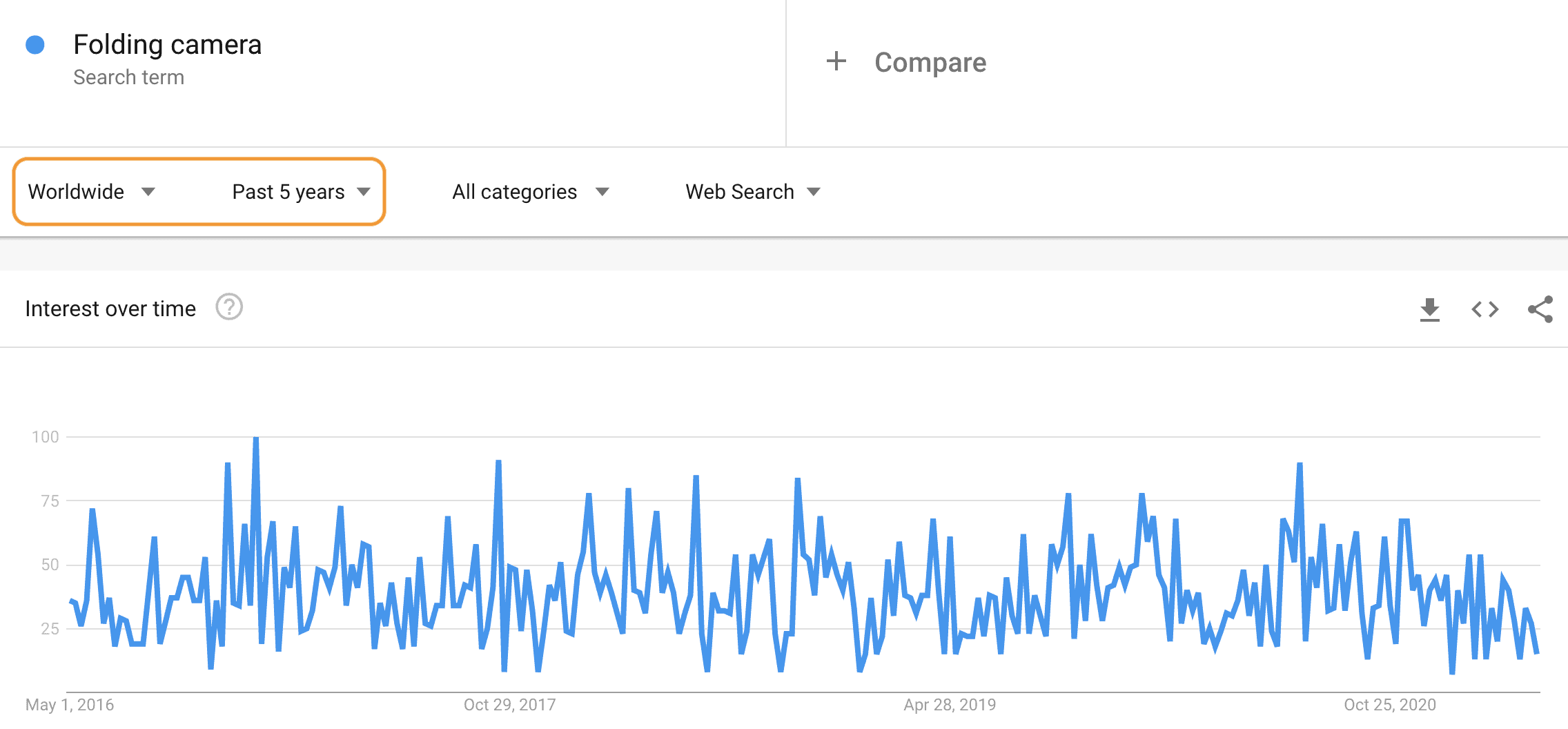
In this example, you can see that the interest in “folding cameras” for the past 5 years has been stable. This suggests it could be a valid niche market to start a new business.
However, there is one important note when checking trends- New trending topics such as new products, new procedures, or new services might not show a big interest over time in this tool. And this is because Google Trends needs time and a lot of data to present these numbers.
So if you think you found a new trend and want to validate your idea, but this method does not work, I suggest you check on popular forums and social media and find if people are already asking for it. That could be a good indicator and can give you some insights about a lack of information that you could fulfill.
> Niche Trends: How To Find Trending Niches (+Top 10 Trends)
Niche Competitors.
When it comes to niche research, finding your niche competitors and analyze them is a priority task.
If most of your competitors are big companies very established in your desired niche, you might want to choose another option. Ideally, you want to focus on a niche where you can get some shares in the market and make it to the Google page one to gain exposure.
Also, by analyzing your niche competitors, you can learn what strategies they are applying. This can be a powerful method to learn what is working for them and might work for you as well.
This is what you need to do next:
1. Identify your niche competitors.
The first step should be to identify who are your niche competitors.
There are two different ways you can find them:
1- Search in Google by niche . This might be the easiest way to find them- all you need to do is to browse Google search results, click on results related to your niche, and inspect the websites. If the results you find are totally focused on this niche, and all their content is about this niche, they are direct competitors.
However, if you click on the Google result but the website has only a few topics covering this niche, this website probably focuses on another niche. It won’t be a direct niche competitor.
2- Search in Google by your niche keywords . For this method, just Google search some of your niche keywords. For instance, if you were to create a website on the camera folding niche, you could search terms like ‘camera folding equipment,’ ‘best camera folding lens,’ ‘camera folding mobile, etc.
Same as before, click on the results and check if these websites are on this niche or is just a one time post.
2. Find your Niche Competitors top keywords.
Keywords are vital to implementing a successful SEO strategy. And the good thing is that you can “steal” some of your competitor’s keywords effortlessly.
You might not be able to rank exactly for the same keywords, but at least they will give you an idea of what terms are driving traffic to their sites.
Although the best way to get a list of your competitor’s keywords is with a paid SEO tool like Keysearch or SE Ranking (which, by the way, are the cheapest ones in the sector,) you can also use some free tools like Ubbersuggest.
All you need to do is:
Step #1. Head to Ubbersuggest and type in the search bar one of your competitor’s domain and click “ search “. For this example, I will check Dronerush, a website about drones.
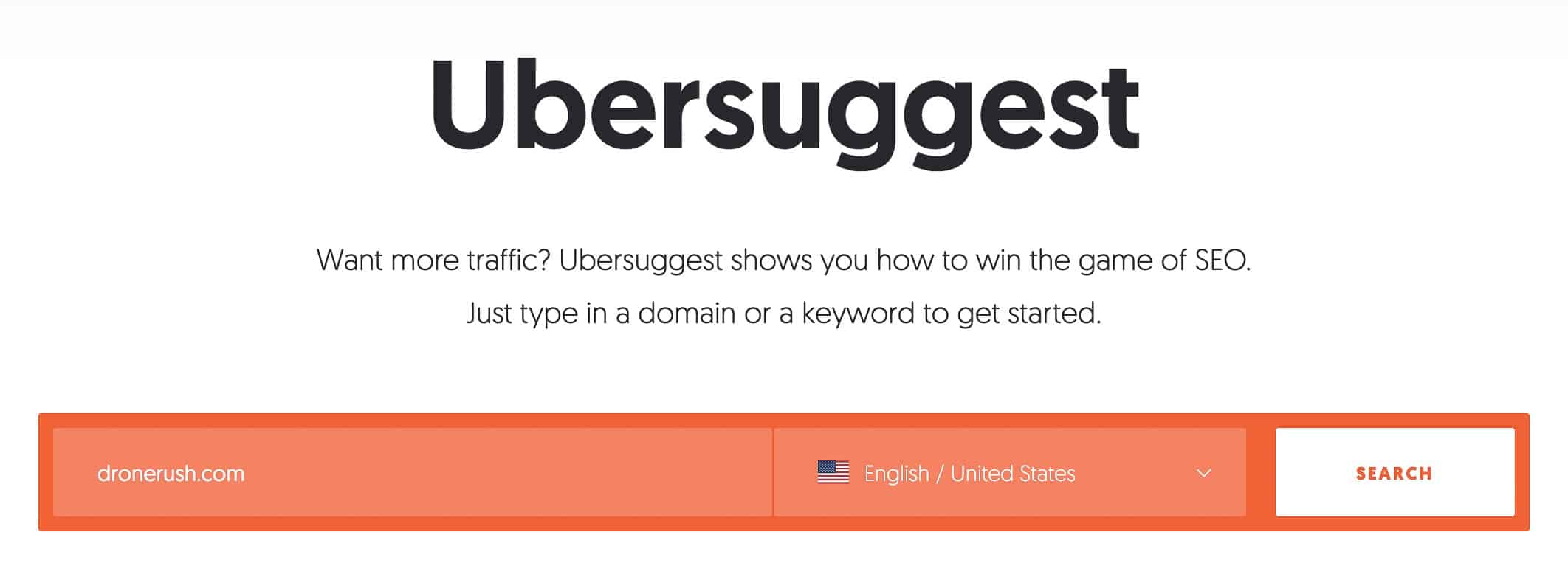
Step #2 . Scroll down to the ‘SEO keywords’ section. Here you will find a list with the keywords driving most of the traffic. You could even use some of these keywords as a niche market like ‘race drones’ for instance.
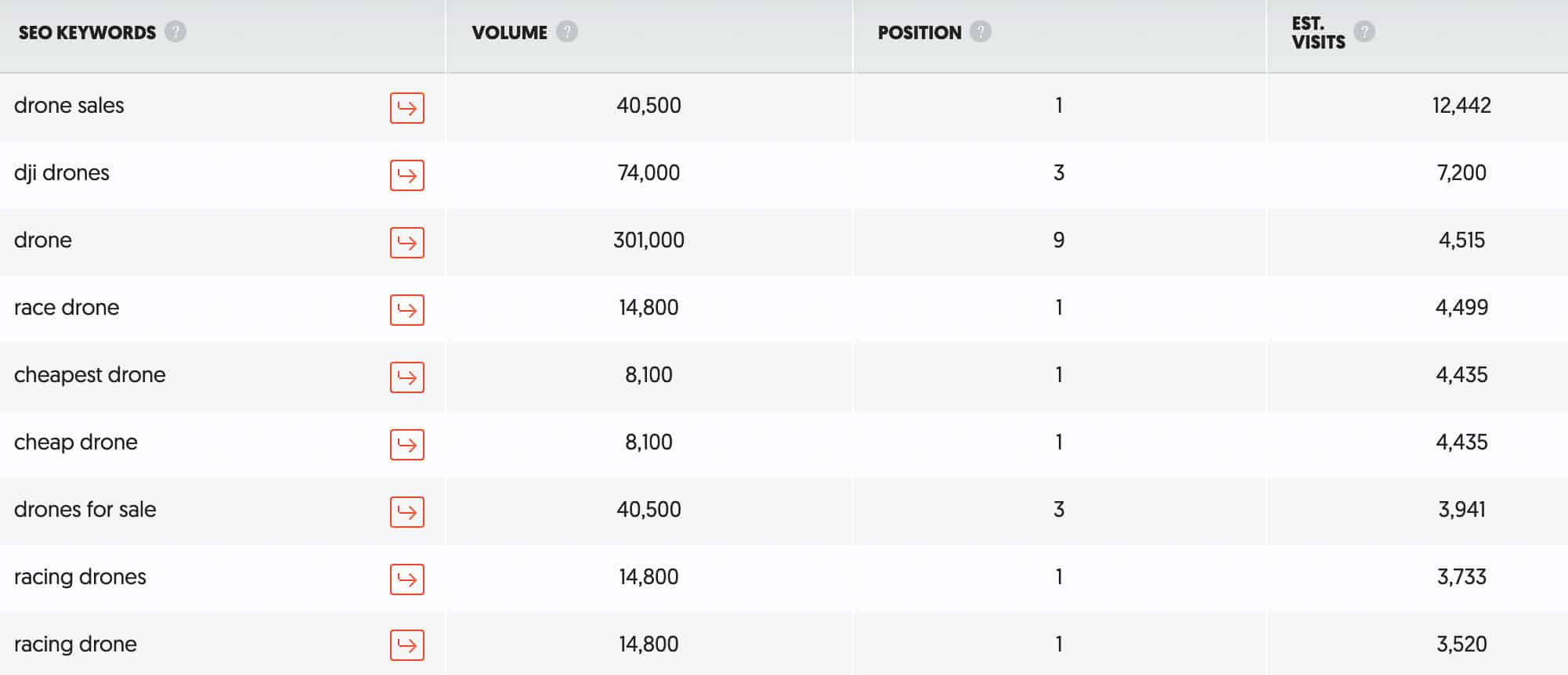
This is a great way to find both market opportunities and keywords that you could potentially use to drive traffic to your site.
Free SEO tools have some data limitations, though. With tools like SE Ranking you could get a much thorough report very rapidly:
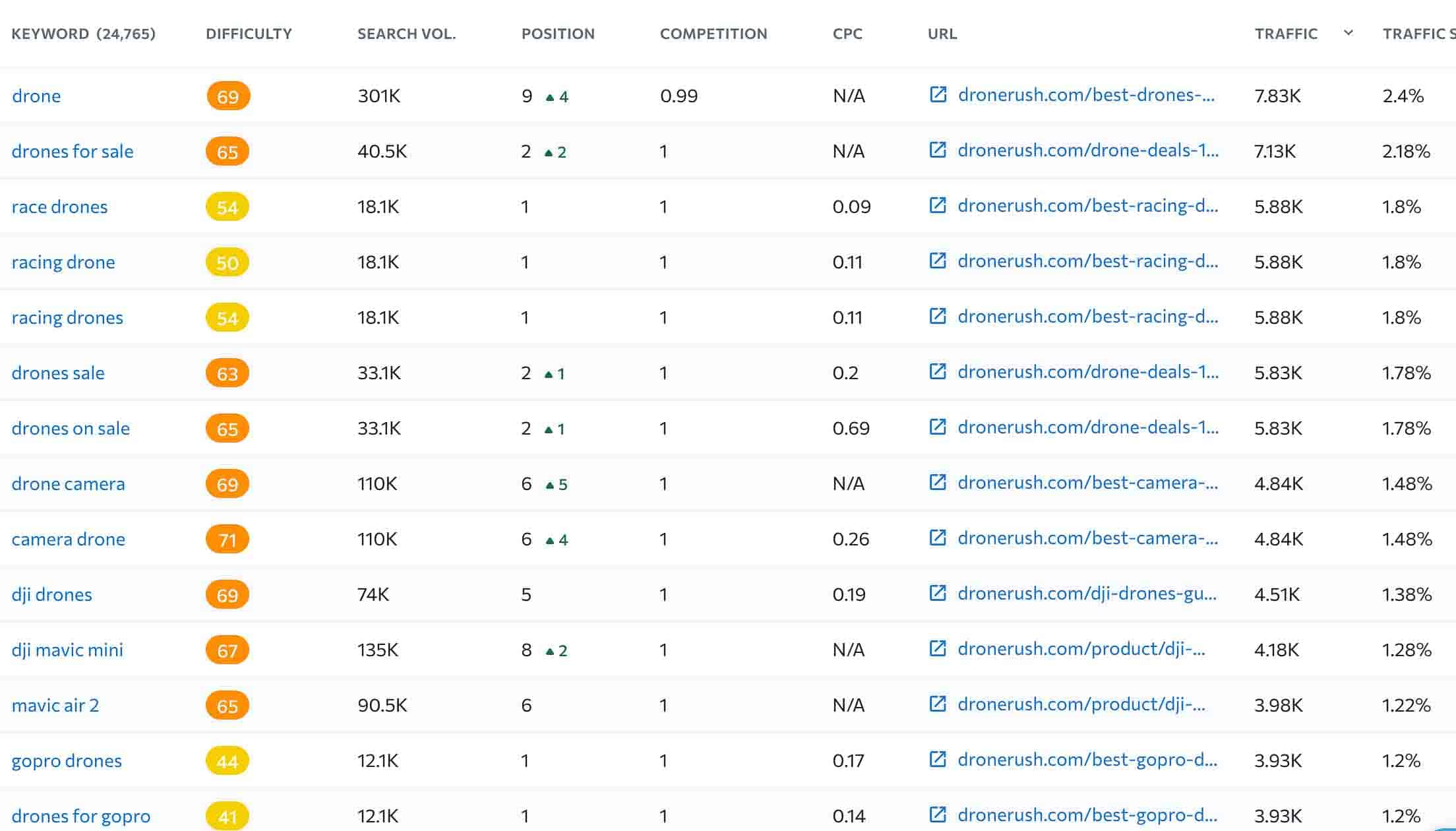
When you are starting a blog, you shouldn’t go for keywords with a lot of competition. Start by checking if there are any keywords with low competition from your competitor’s list.
If not, you can always create SEO silos to improve your chances of ranking for competitive keywords.
Alternatively, you can use keywords with a lot of traffic as a specific niche market. This will remove some of your competition, and you can focus on a targeted audience and will be able to find less competitive terms.
3. Analyze your competitor’s Content.
Checkin the kind of content your competitors publish is a great method to learn how they attract their audience and how they monetize.
Some things you want to pay attention to are:
- How often they post content?
- What kind of content do they write about?
- How are they engaging with their audience?
- How do they convert their readers into subscribers?
- How long are their blog post? 500 words? 2,000 words?
- How do they monetize?
These can be some useful questions that can help you greatly. You might learn some good strategies you can apply to your website by doing this. Also, you should try to improve whatever they are doing to “steal” some of their readers.
Content is the main aspect to analyze in your competitor’s website- Check if they focus on listicle or how-to articles, for instance, if they use more videos than images and things like that. They probably have already optimized their strategy and use what works the best. So why not taking advantage of that?
My personal advice is to analyze every aspect, write them down in a list, and then create something better. Generating better content than your competitors is the best way to get rankings and an audience faster.
4. Analyze How They Drive Traffic To Their Site.
Most of your competitors will likely be using SEO to drive most of the traffic. But that does not mean it is the only strategy.
A very easy and effective way to check how you competitor is driving traffic to his site is by using Similar Web.
Step #1 : Head to Similiar web , type your competitor domain and click ‘Search.’
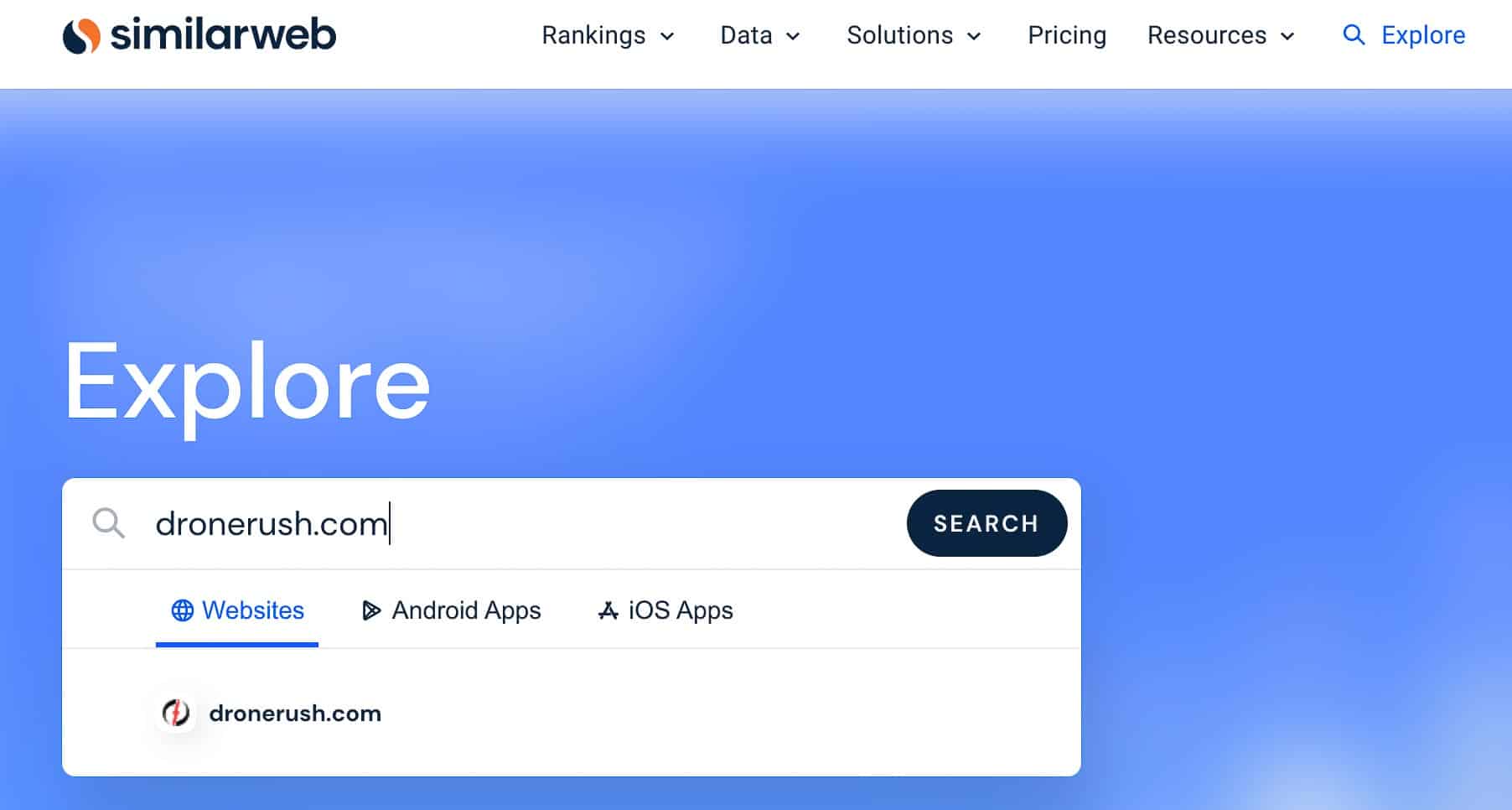
Step #2 . Scroll down to ‘ traffic sources ‘ and you will find how they drive traffic to their site:
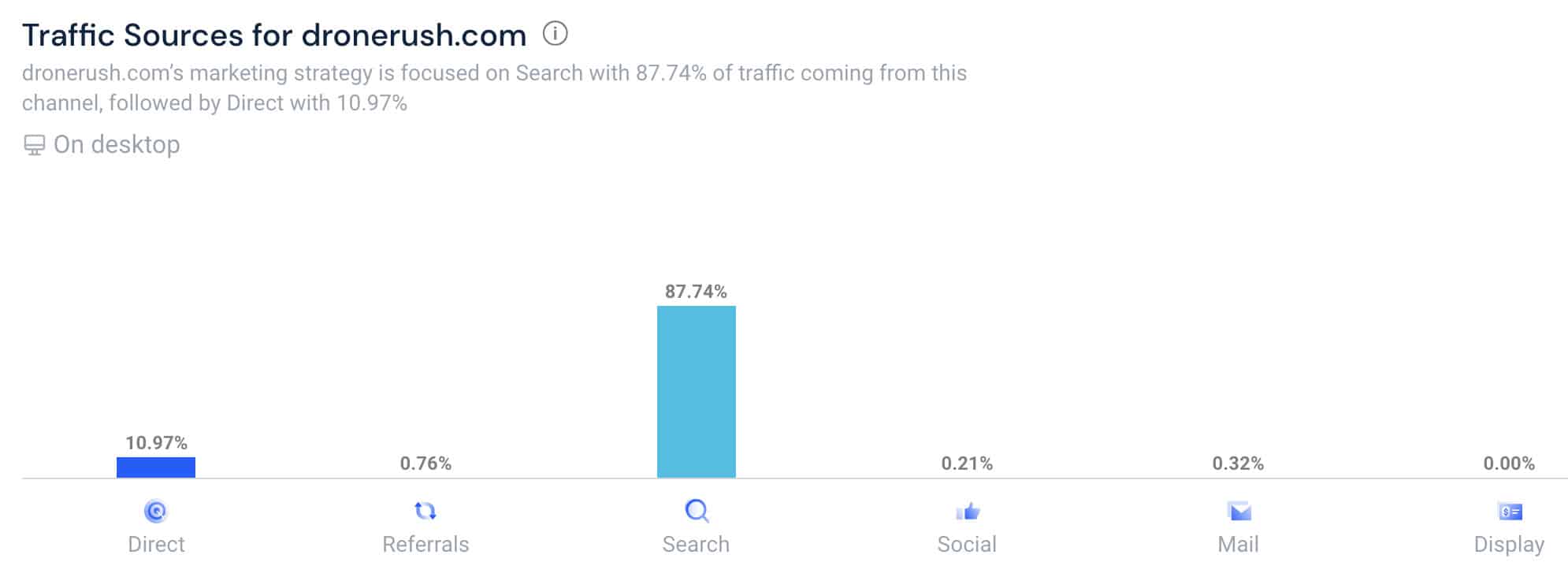
For this example, you can clearly see that most of the traffic is search traffic (organic.)
If you keep scrolling down, you can also find which keywords are the top 5 driving traffic, top referrals and which social networks drive most of the traffic:
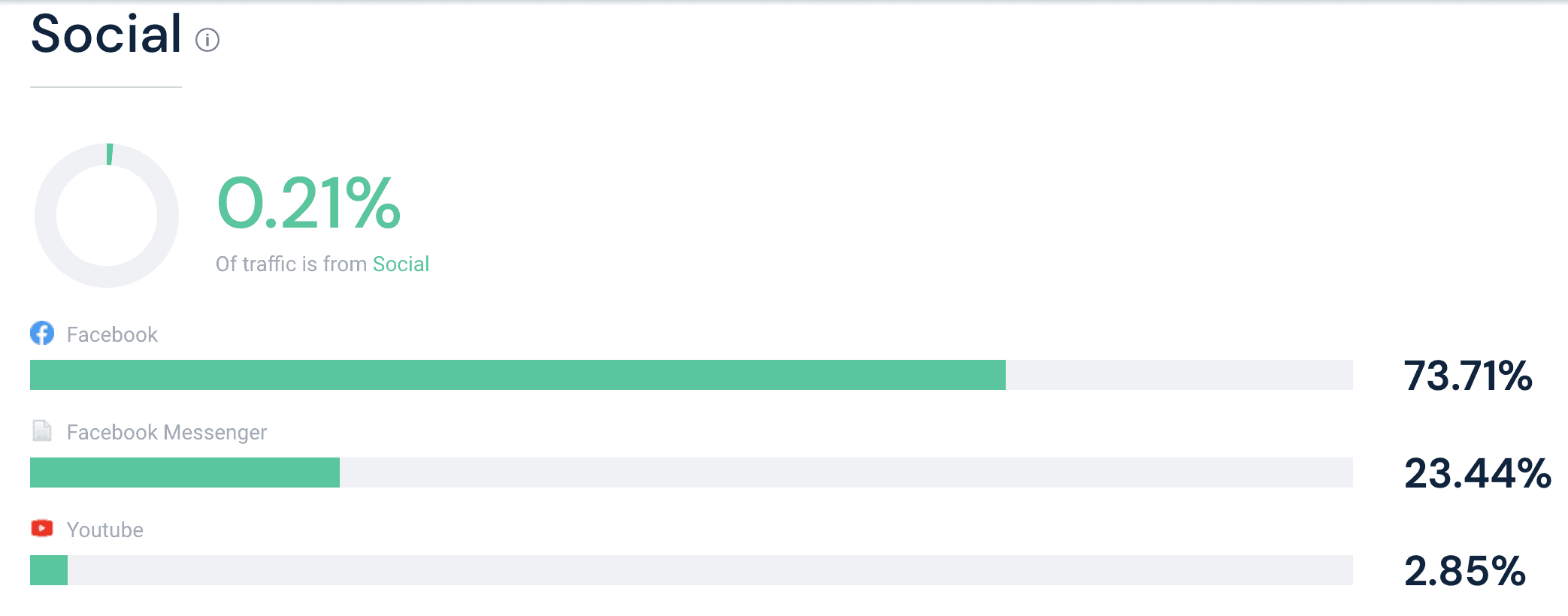
In this case, Facebook is what drives most of their social media traffic. Although it is clear they clearly focus on organic traffic.
In conclusion, if you use these 4 methods, you will have a better understanding of what kind of content to create, keywords you should focus on, main traffic sources, and even some ideas on how to monetize your website.
> Niche Competitors Analysis: Leveraging your competitor’s best strategies.
Niche keyword research.
Another critical factor in your quest for niche research is niche keyword research.
What is niche keyword research?
Niche keyword research is when you target particular long-tail keywords that pertain to a narrow industry. When you target these long-tail keywords, your content is more specific, attracting a more targeted audience and removing some competitors from high-level markets.
When you are starting an online business, niche keywords can impact your SEM (search engine market) strategy. They normally tend to have less search volume and are less competitive, which gives you a chance to rank for them.
How to do niche keyword research.
To perform niche keyword research, you are going to need an SEO tool.
Although there are some free SEO tools that you could use, they have some serious limitations. Also, if you want to have a real shot with organic traffic, you will need a proper SEO tool. So my personal recommendation is that you use one on the lower end but powerful enough to start with, like Keysearch or SE ranking .
For the purpose of this article, I will teach you how to do niche keyword research with a ‘free’ tool like Ubbersuggest. The method is exactly the same for any SEO service or tool you use.
1. Brainstorm keyword ideas.
Most of the current SEO tools come with a ‘brainstorm module,’ which provides you some keywords suggestions as you type.
First, head to Ubbersuggest Keyword ideas module and type your keyword.
In Ubersuggest , type your keyword idea directly in the search bar, and click ‘search.’ A list with plenty of keyword suggestions will appear.
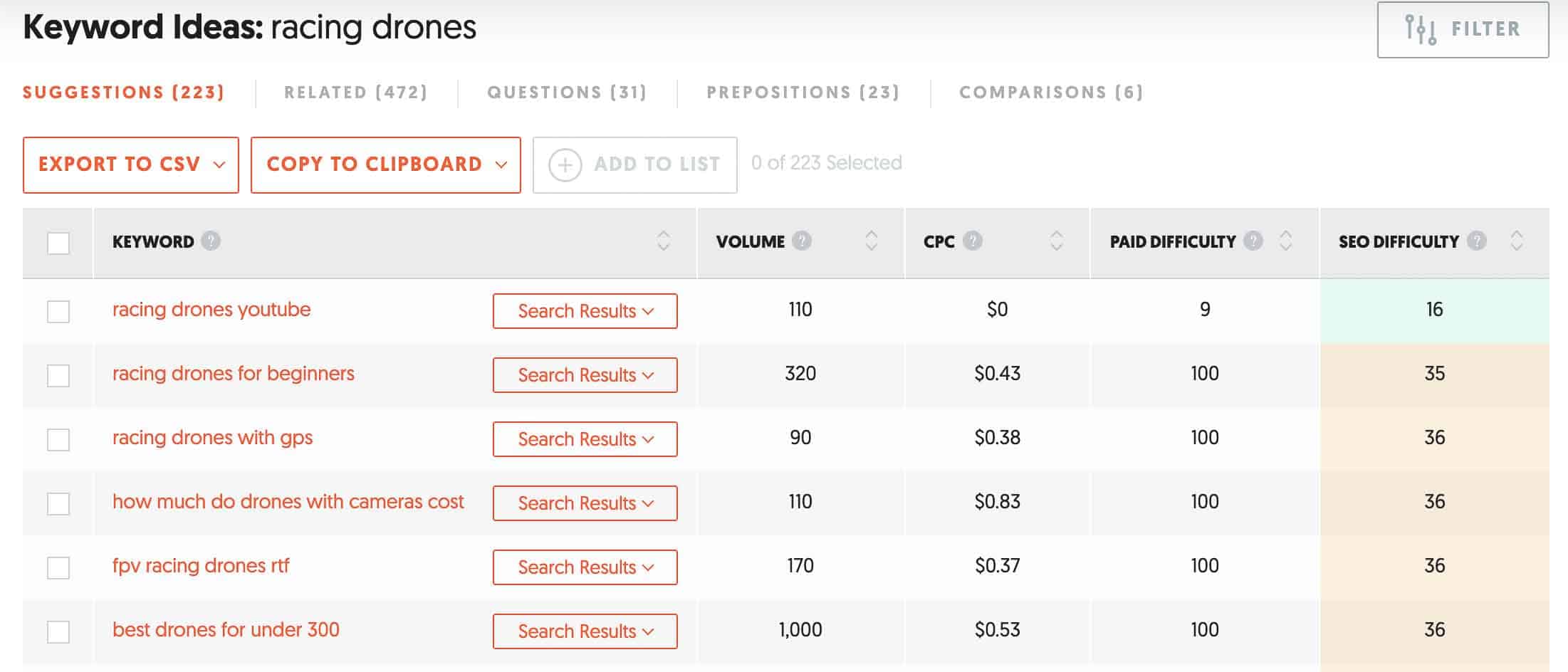
You can even filter by SEO difficulty or any other value by clicking on the top of the column.
This is a great method not to only find some keyword ideas, but also to find directly keywords with low competition.
If you use any other SEO tool, the keyword research module will likely provide you with keyword suggestions and related terms. So just write down a list with all the keywords you’ll want to target.
Some other methods to brainstorm keyword ideas involve researching forums and social media platforms where your targeted audience gathers. You just need to inspect them thoroughly and maybe even search by keywords to find out what people are asking about, and maybe you can create content about it and even come back later to share a link to your article with this audience.
2. Refine Your Niche Keyword List.
Once you have a list of keywords, you’ll need to refine your list.
When refining your list, some of the factors you need to consider before choosing a keyword are:
- Volume : Search volume shows approximately how many searches Google is getting for a particular keyword each month.
- CPC : (cost per click) shows how much advertisers are bidding to get their ad shown on Google when that keyword is searched. The higher this number, the more money it’s behind it.
- PPC : (pay-per-click) It’s an advertising model for the internet in which advertisers pay for publicizing their products on a website or search engine. Each time users click on the ad, they will be guided to the advertiser’s site.
- Score or SEO difficulty : The score is to know how difficult it is to rank for a specific keyword. Every tool has its own difficulty score, which is calculated slightly differently, but generally, they provide good enough guidance to know if you should pursue a keyword or not.
Refining your keyword list will be complicated if you use a free keyword tool since these free tools offer severe limitations when it comes to keyword research.
You still can do it with Ubbersuggest for free as long as you stick to three searches per day, which is nothing. Also, find the SEO score of Ubbersuggest quite off compared to any other tool.
Still, if you want to go ahead and check it Ubbersugest for free, all you need to do is to type your keyword in the search bar and hit ‘search.’ Alternatively, with the keyword ideas list we got previously, we can filter by SEO score:
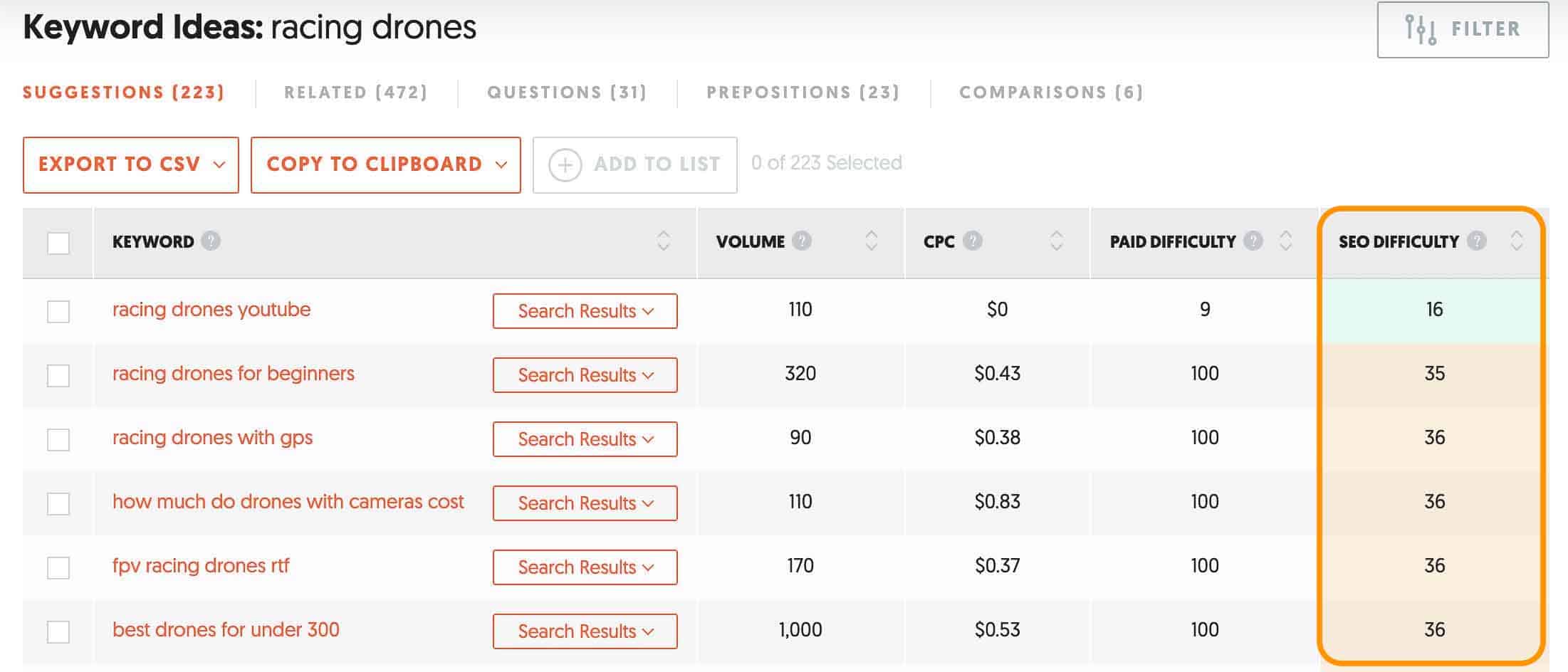
Next, you can click ‘filter’ at the top right and set some parameters to refine your keywords. This will help you filter for less competitive terms still with search volume:
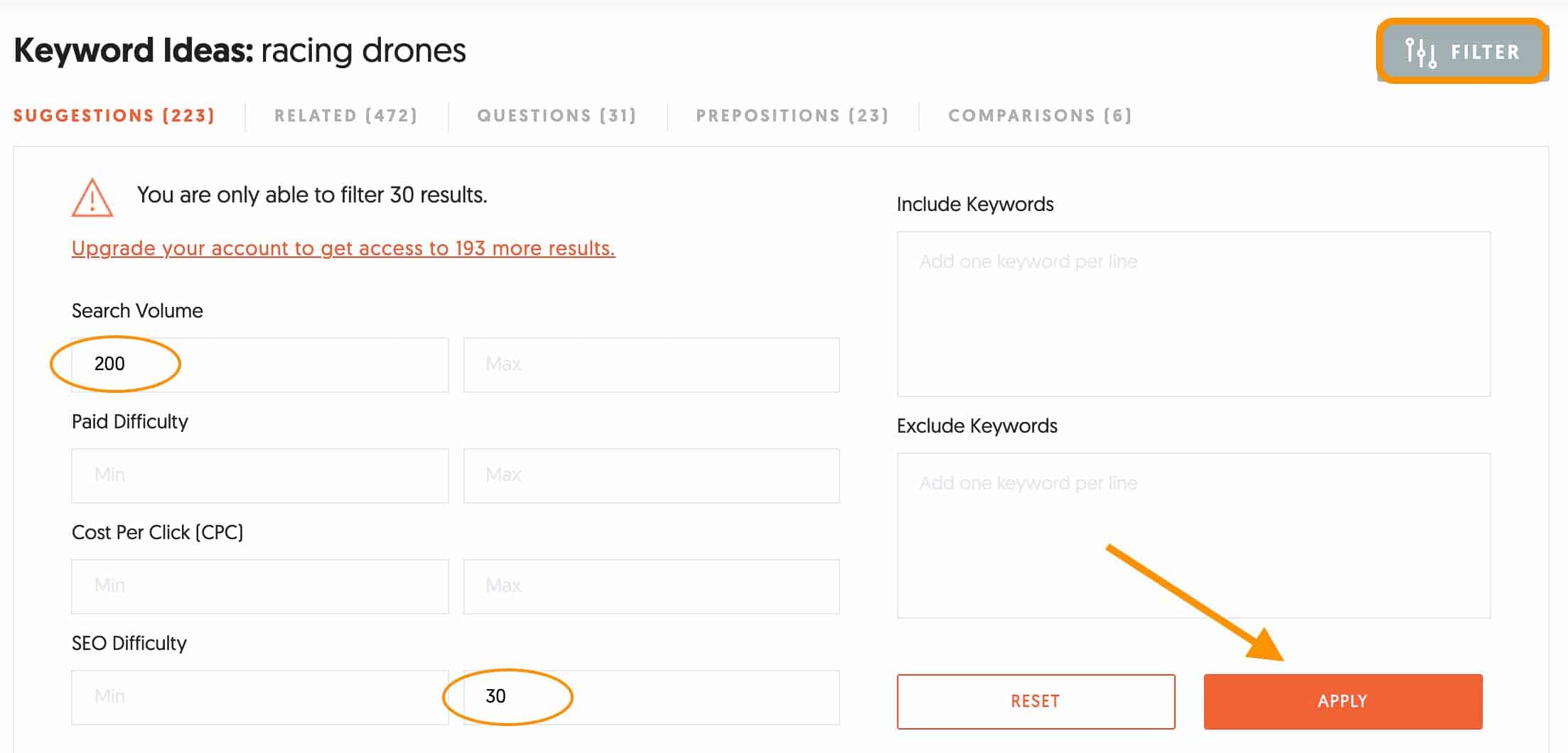
For this particular example, Ubbersuggest did not through any term with these conditions. However, I performed the same search with SE ranking and Keysearch, and this is what I found:
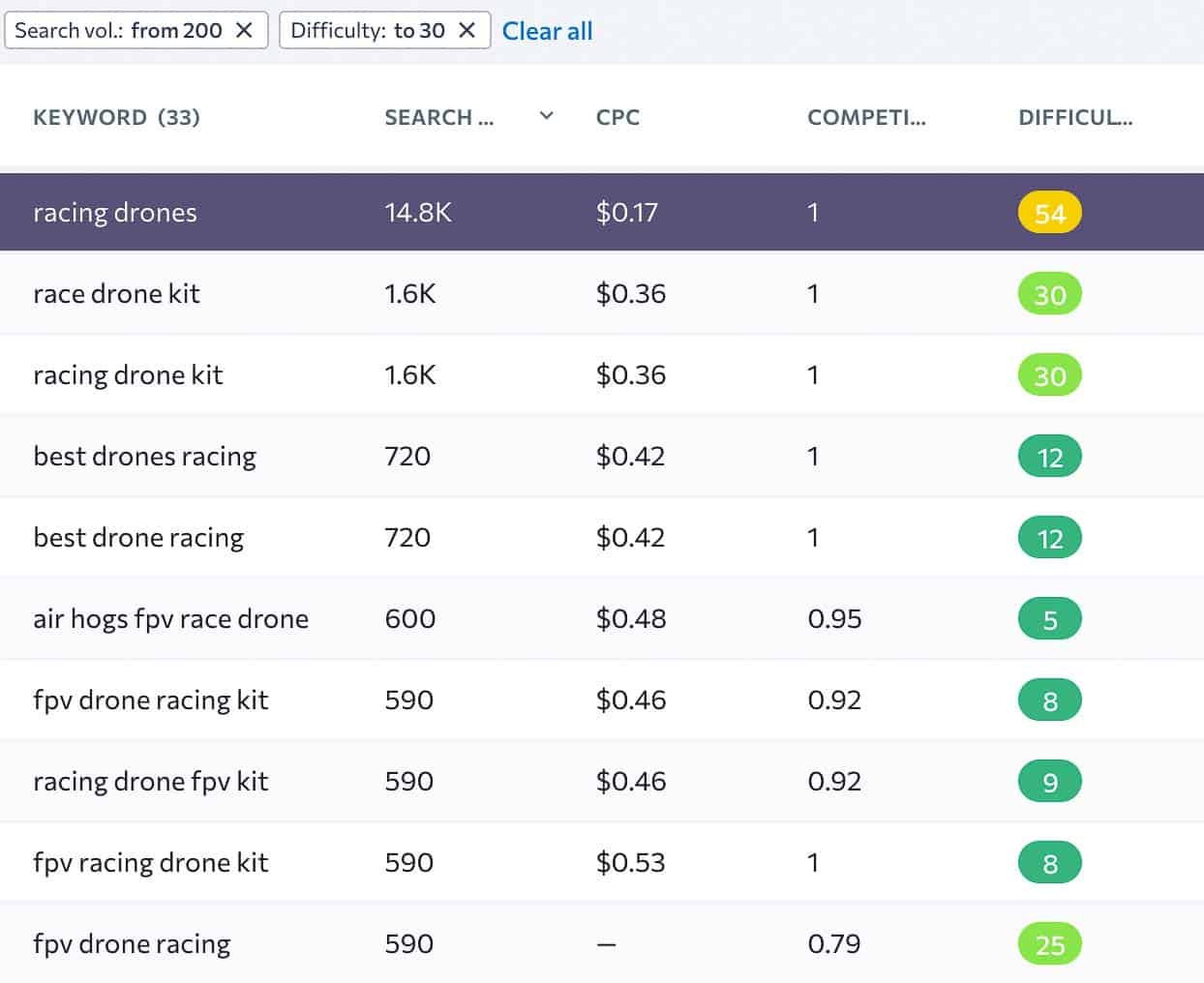
So as you can see, every tool will provide you with different results. you just need to try different alternatives until you find keywords with good search volume and a low SEO competitive score.
Your goal is to develop a list of keywords with reasonable search volume, commercial value, and low competition. Once you have all this, you can start planning your content creation strategy.
You can learn more about keyword research with Keysearch in this guide. Alternatively, you can check SE ranking which is also an affordable tool and a bit more powerful.
3. Plan your content strategy.
Your keyword research strategy does not end with your list of keywords. Next, you should create a content strategy that allows you to grow your traffic and authority.
You should divide your list of keywords into two piles:
- Keywords for your cornerstone content . These should be the most complete and thorough articles on your website. They should cover a topic in depth. Aim for 2,000 words at least.
- Supportive content . These should be long-tail keywords related to your cornerstone content. The idea is that each section of your cornerstone article should be supported by an extended version. Aim for 800 words at least.
Once you have your list of keywords ready, I suggest you:
- Create content silos . These would be your cornerstone pages and you should use the keywords with the largest search volume. When possible, try to avoid very competitive words. This is an example of how to do this.
- Set up a content calendar . Try to be consistent and post at least once a week. For instance, you could post once a week if you create cornerstone content, and twice a week when targeting long-tail keywords.
- Define your goal for each piece of content . Every piece of content you write should have a goal: Get subscribers, drive traffic with informative content, sell something, click on affiliates, etc.
- Create your buyer persona and write your content accordingly . When you write especially to your buyer persona is when you attract targeted customers which will convert more easily. Click here to create your buyer persona.
In summary, to successfully perform niche keyword research, my recommendation is you get an SEO tool. It will make the process much easier. Also, planning your content strategy is a must and will help you maximize your keyword opportunities.
> Niche Keyword Research Guide.
How to find a niche market.
In order to find a profitable niche market, you will need to put together all you have learned from the previous sections:
- Brainstorm niche market ideas.
- Validate your niche idea.
- Study your niche competitors.
- Perform niche keyword research.
1. Brainstorm niche market ideas.
In the previous sections, I showed you how to brainstorm niche market ideas. There are also a few methods that can help you with your niche research. And what of the most powerful to find relevant content are forums and social media platforms.
People are constantly discussing issues or asking questions about specific topics on different platforms. You just need to pay attention to popular threads and check why they are popular. Maybe there is a brand new product people don’t know how to use. Or maybe there is an issue that people are not sure how to solve, and you can fill the gap.
Try to look for a “popular issue” within the community, and your product or service could be the solution to that problem.
Some of the best places where you can start looking for ideas are:
- Facebook Groups: Type in Facebook’s search bar a topic and press enter. Then in the filter column on the left-hand side, look for groups and click on them. These groups would be a gold mine of ideas for a topic.
- Reddit : Type in the search bar a topic and press enter. Sort the results by “top” and you’ll find the topics where people are more interested in
- Quora : Type in the search bar a topic and press enter. Now scout through the different results and check the ones with more answers. These would be the ones people are debating the most and are worth checking for ideas.
2. Validate your niche idea.
Once you have a list of keywords and topics, you can easily validate them with Google Trends .
The great thing about this tool is that you can even compare several ideas in parallel to help you decide.
For instance, let’s say that our niche ideas are drone cameras, action cameras, and 360 cameras and we put them together in Google Trends.
There are a few things we can learn from the graphic below:
- All the trends are very stable and have a good number of interest over time.
- Drone cameras seem to be the ones keeping interested over time, with spikes during Xmas season.
- Actions cameras are also very stable but interest has slightly dropped after 2018.
- 360 cameras started very strong but also lost some interest after 2018.
It is interesting to see how by 2022 all the trends are quite similar. So they all seem valid niche ideas.

Before deciding on them, you’ll need to find out how the competition is in these niches. These still are very high-level niche categories, so I can anticipate the competency is probably tough.
3. Study your niche competitors.
The simplest way to find your competitors is by Google search your niche keywords. Let’s say I decide to go for the drone cameras niche.
Then, I’d go to Google and type drone cameras, and click search.
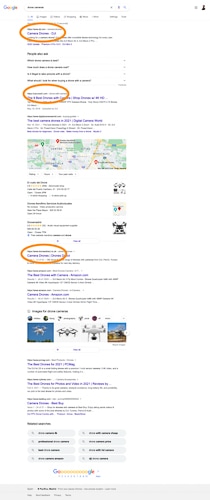
In this initial search I can observe two things:
- There are 3 direct competitors whose primary business are drones on Google’s page one: DJI, UAVcoach, and DroneDirect.
- The rest of the results are big established companies that sell drones like Amazon, Best Buy, and big websites like PCmag and Digital Camera World.
You don’t want to compete with big brands- They will resources to position their content you simply won’t have. Also, it is important to check your competitor’s domain authority to find out how established they are:
Step #1 . Head to WebsiteSEoChecker and introduce your competitor’s domains and click check:
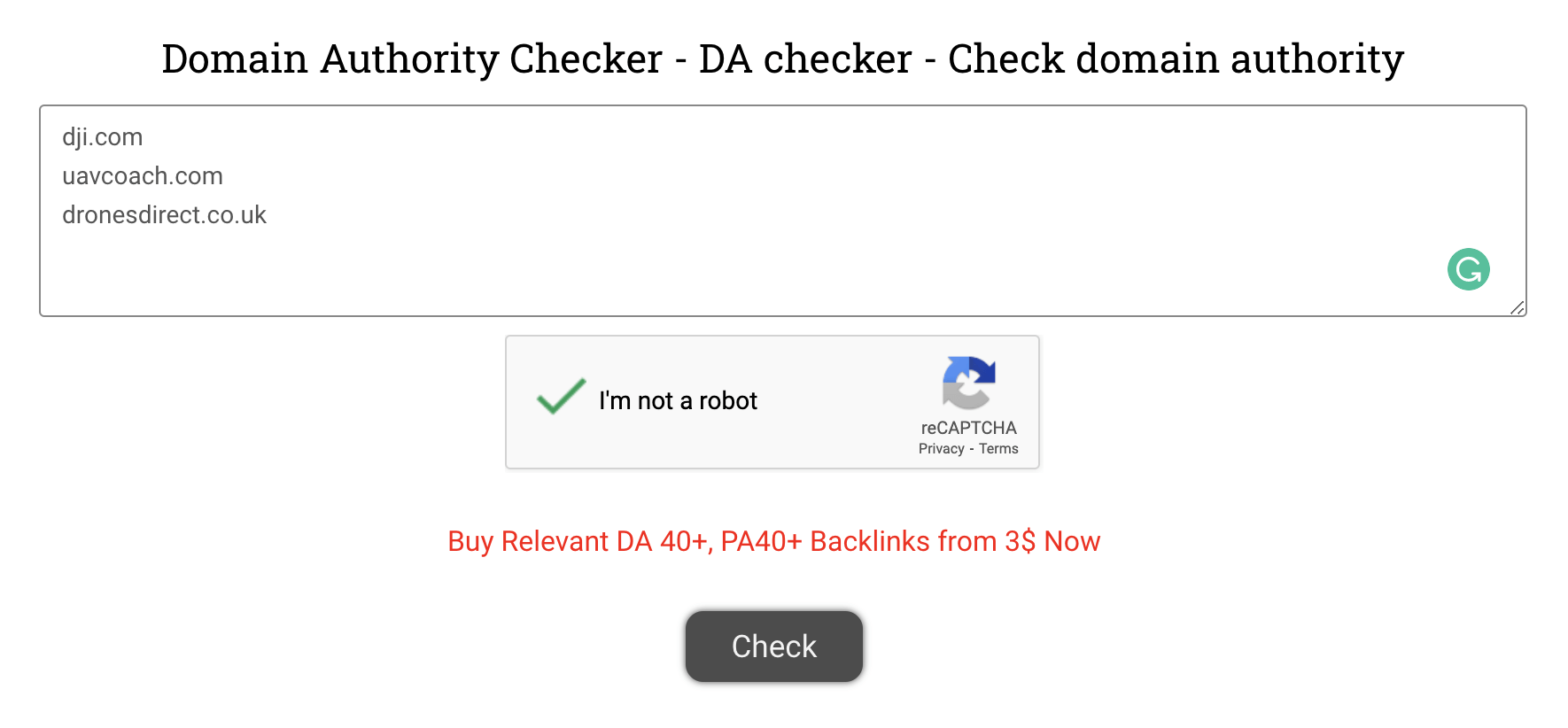
Step #2. Next, check the domain authority and age columns to get an idea of who you’ll be competing with. In this case, they all are aged websites with a high DA, which will make it difficult to outrank them.
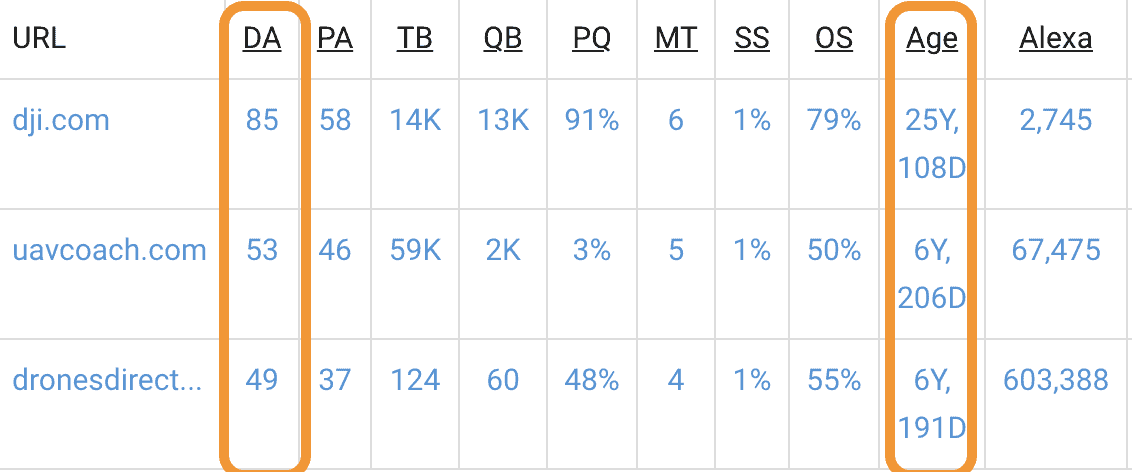
In cases like this one, niching down a level always helps to remove big competitors. Instead of ‘drone cameras’ which is a broad term for drones, I will try ‘drone for travel’, and let’s see what we find:
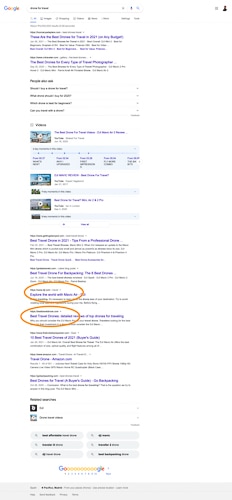
Now, this is a massive change. From all the results, there are only 2 direct niche competitors . Also, there is no sign of other big brands like in the previous example.
- DJI (DA 85)
- And Best Travel Drone. (DA8)
This is already a great improvement. This means that if you stick to creating content about drones for travel, you might be able to make it to Google page one.
That is why studying your competitors and niching down are great strategies to increase your chances of success.
4. Perform niche keyword research.
The last step is to create a list of keywords with low competition for your content strategy.
In the previous section, you can see how to do this in detail.
For this example, let’s say your niche is ‘ drones for travel ‘ and you want to create a list of keywords. You will need to find keyword ideas and then check the SEO difficulty:
Step #1. Head to Answer The Public and type your niche keyword. It will provide you with a list of keyword ideas:

It generated some very interesting keyword ideas like:
- can drones travel
- are drones illegal to fly
- how to travel with drones
- can you fly your drone anywhere
- should I buy a drone for travel
As you scroll down you will find more suggestions.
Step #2 . Through these keywords into your SEO tool to check for SEO difficulty and search volume. You might struggle to find accurate search volume data for long-tail keywords with more than 3 terms. So I suggest using the filters in your SEO tool to find several options with a single search.
For instance, I will check for ‘how to travel with drones’ and will set the filter to a minimum volume of 200 per month and SEO difficulty of less than 40:

When I click to apply the filter, I managed to get a list with 6 amazing keywords in no time!
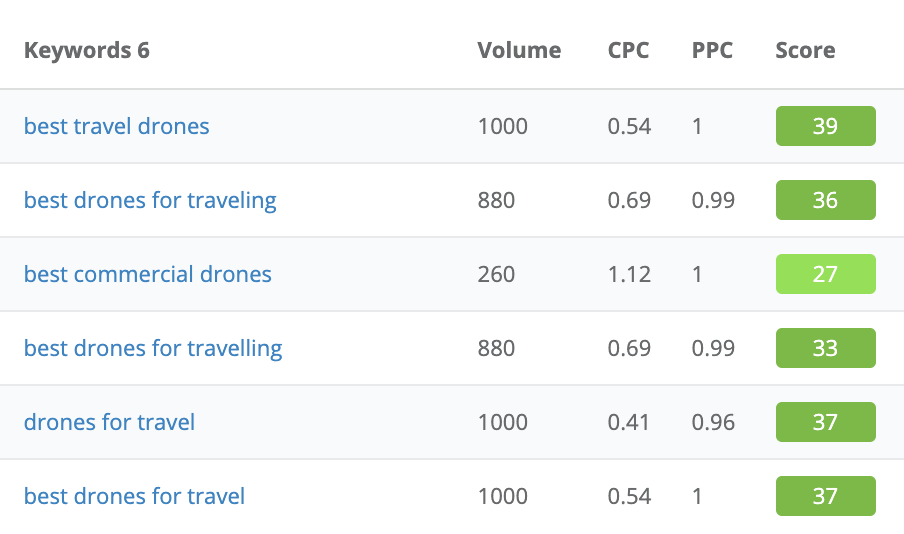
Step #3 . Rinse and repeat. Ideally, you need to develop a big list of keywords, especially if you have not created your post categories yet. This will prevent messing up your website structure in the future. It will also help to get an idea of how to build your SEO content silo.
Profitable niches with low competition.
What Makes A Profitable Niche Market?
A profitable niche is a niche with demand. It is a niche in which people are already buying a product or service. And that is what a clever niche marketing strategy is about: To sell something that people are already buying.
First, you need to find a pain point and put a solution to it in the form of a product or service. It should be something that people will be willing to spend their money on. For instance:
- People who love photography will normally read reviews before buying a new camera or replacing them. They need to know they are investing their money properly. So the solution to this problem would be to create a website focused on camera reviews.
- People with tiny houses will be looking for furniture and ideas to help them maximize their space. A solution to this problem will be a website providing tips and resources to make the most of tiny houses.
You need to find a niche you’ll be comfortable writing about and look for specific solutions within that niche. If you manage to do it efficiently, the money will follow.
If you already have some knowledge about a topic or a passion, that would be a great starting point.
How To Find Profitable Niches With Low Competition?
If you want to find profitable niches with low competition, you should always try to niche down and go micro- niche .
A mistake most first-time online entrepreneurs make is that they want to build the biggest and greatest website in the entire world. One that has reviews and information on any product you can think of. “Like Amazon…but better.” Although that might be possible, the resources to make that happen are huge! So you need to set up a realistic plan.
The best niche markets are those where you look at a broad niche that is working, but you dig down into it. You should aim to dig enough to find a sub-niche or micro-niche within it.
Let’s take the example of the electronics niche. It’s huge, but the competition is fierce. If you decided to go this way, you’d find yourself competing with massive brands like Amazon or MediaMarkt. Instead, try to focus on something specific targeting and smaller and more detailed audience. A low competition niche will make it easier for you to dominate that specific market.
Competing in broad niche markets is entirely possible, but competing in super-focused niches is just easier and more profitable. It’s also a lot less work for attracting free search engine traffic, which should be one of your top objectives.
When you manage to niche down enough, your traffic will grow slowly but steady, your competence is smaller and your income will start sooner.
10+ Profitable Niches With Low Competition.
Although the list of niches below is already profitable niches that are making money, the competition can vary with time as they become trends.
For instance, the keto diet used to be a niche with very low competition 3 years back, and now it seems everybody has a keto diet blog.
If doing your niche research, you find that the niches below are too competitive, just go down one level, and I am confident you’ll find your spot.
Some low competition niches in 2023 which are making good money are:
- Wearable Technology
- Home Security
- Online Dog Training
- Maternity Clothing
- Eco-Friendly Products
- Vegan Recipes
- Massage Chairs
- Drone Photography and Video
- Resume Services
- Crossfit at Home
> 10+ Profitable Niches With Low Competition.
List of niches.
In this section, I will provide you with a list of niches from different industries to help you find your profitable niche market.
Also, you will find a list of niche reports I add every Wednesday with plenty of useful information. I will perform niche research about a specific topic and create a report including:
- Niche Trends.
- Niches Ideas.
- Niche competition.
- Monetization tips.
List of niche ideas.
- 10 Best Podcast Niches For Starting A Business
- The 10 Best NFT Niches To Get Started
- The 10 Best Niches For Youtube With Low Competition.
- The 10 Best TikTok Niches To Grow Faster (And Make Money.)
- 10+ Best Shopify Niches (+ Best Products To Sell.)
- 10 Best Digital Marketing Niches For Entrepreneurs.
- Amazon Niche Research + The 10 Best Amazon Niches
- The 10 Best Ecommerce Niches
- The 10+ Best Drop Servicing Niches
- The 10 Best Dropshipping Niches
- 10+ Best Instagram Niches to Make Money
- The 20 Best Affiliate Marketing Niches (+How to Monetize Them)
- 10 Best Adsense Niches To Make Money Just With Traffic.
List Of Niche reports- Including Trends, ideas, and monetization tips.
- Health and Wellness Niche Report.
- Skincare Niche Report.
- Tourism Niches Report.
- Art Niche Report .
- Fitness Niche Report .
- Photography Niche Report .
- Sports Niche Report.
- Pets Niche Report.
- Food Niche Report.
- Lifestyle Niche Report.
- Fashion Niche Report .
- Beauty Niche Report .
- Insurance Niche Report
- Gaming Niche Report
- Coaching Niche Report
Did you enjoy this article?
I’ve put so much effort into writing this comprehensive guide to provide value to the blogging community. It’ll be very helpful for me if you consider sharing it on social media networks.
Share it on social media!
Need help with your digital marketing strategy?
Let me help you to increase your site traffic with Niche SEO optimizations.
Privacy Overview

What is Niche Marketing?
Understanding the concept of a niche market, why firms target niche segments, benefits of niche marketing, examples of successful niche marketing campaigns, identifying your target niche market, conducting market research for your niche, developing a niche marketing strategy, implementing your niche marketing plan, evaluating the success of your niche marketing efforts.
A niche market is a subset of a larger market that focuses on a specific group of customers with unique preferences, needs, and characteristics.
Unlike mass marketing, which aims to appeal to a broad audience, niche marketing involves targeting a specific segment of the market. This targeted approach allows businesses to better understand their customers and tailor their products or services to meet their specific requirements.
When identifying a niche market, it’s important to consider factors such as demographics, psychographics, and behavior. By understanding the specific challenges, desires, and pain points of your target audience, you can position your business as the go-to solution provider.
Brands use niche marketing for a variety of strategic reasons, as it offers several advantages and benefits that can lead to more effective and efficient marketing efforts. Here are the key reasons why brands choose to implement niche marketing strategies:
Targeted Audience
Niche marketing allows brands to focus their efforts on a specific and well-defined audience segment. By identifying a niche market, brands can tailor their products, services, and marketing messages to meet the unique needs and preferences of that audience.
Less Competition
Niche markets often have fewer competitors compared to broader markets. This reduces the intensity of competition and provides brands with a better chance to establish themselves as leaders or experts within the niche.
Increased Relevance
Niche marketing enables brands to be highly relevant to their target audience. When consumers perceive that a brand truly understands their specific needs and challenges, they are more likely to engage with that brand and become loyal customers.
Higher Conversion Rates
Because niche marketing speaks directly to the interests and pain points of a narrowly defined audience, it tends to result in higher conversion rates. Customers in niche markets are more likely to respond positively to marketing messages and take desired actions, such as making a purchase.
Lower Marketing Costs
Niche marketing often requires fewer resources and budget compared to mass marketing efforts. Brands can focus their marketing spend on reaching a smaller but highly engaged audience, reducing wasted marketing dollars.
Brand Authority
Brands that excel in niche marketing can establish themselves as authorities or experts in their specific industry or domain. This can lead to increased trust and credibility among consumers.
Customization Opportunities
Niche marketing allows brands to customize their products, services, and customer experiences to better suit the preferences of their target audience. This level of customization can lead to greater customer satisfaction .
Word-of-Mouth Marketing
Satisfied customers within niche markets are more likely to share their positive experiences with others who have similar interests. This word-of-mouth marketing can be highly effective in niche communities.
Scalability
While niche markets may start small, they often have room for growth . Brands can expand their presence within a niche market or explore similar niches as they grow.
Brand Loyalty
Niche marketing can foster strong brand loyalty, as customers feel a strong connection to brands that cater specifically to their needs and preferences. Repeat business and customer advocacy become more common.
Market Segmentation
Niche marketing aligns with the practice of market segmentation, which recognizes that different customer segments have distinct characteristics and behaviors. Brands can apply different marketing strategies for each niche, optimizing their approach.
Risk Mitigation
Diversifying into niche markets can help brands mitigate risks associated with overreliance on a single, broad market. If one market experiences a downturn, other niche markets may remain stable or grow.
Niche marketing offers numerous benefits for businesses of all sizes. Here are some of the key advantages:
- Reduced competition : By focusing on a niche market, you can avoid competing with larger, more established brands. Instead, you can position yourself as the expert in your specific field and attract customers who are looking for specialized products or services.
- Increased customer loyalty : When you cater to a specific audience, you have the opportunity to build strong relationships with your customers. By understanding their needs and preferences, you can provide personalized experiences that foster loyalty and repeat business.
- Higher conversion rates : Niche marketing allows you to create highly targeted marketing messages that resonate with your audience. By addressing their specific pain points and offering tailored solutions, you can increase your conversion rates and drive more sales.
- Improved brand positioning : By focusing on a niche market, you can position your brand as the authority in your industry. This can help you differentiate yourself from the competition and establish a unique selling proposition that attracts customers.
- Opportunities for innovation : Niche markets often have unique challenges and requirements. By catering to these specific needs, you can innovate and develop products or services that meet the demands of your target audience. This can lead to a competitive advantage and long-term success.
There have been numerous successful niche marketing campaigns that have achieved remarkable results. Here are a few examples:
- Dollar Shave Club : Dollar Shave Club disrupted the shaving industry by targeting a niche market of men who were tired of overpriced razors. Their witty and humorous marketing campaigns resonated with their audience and positioned them as the affordable and convenient alternative.
- Lush Cosmetics : Lush Cosmetics focuses on natural and ethical beauty products. By targeting environmentally conscious consumers, they have built a loyal following and positioned themselves as the go-to brand for sustainable beauty.
- Casper : Casper revolutionized the mattress industry by targeting a niche market of consumers who were frustrated with the traditional mattress buying experience. Their direct-to-consumer model and risk-free trial period resonated with their audience and disrupted the industry.
- GoPro: GoPro specializes in action cameras designed for adventure enthusiasts. They’ve carved out a niche by providing durable, high-quality cameras for capturing extreme sports and outdoor activities.
- Yeti : Yeti focuses on premium coolers and outdoor gear for outdoor enthusiasts, hunters, and anglers. Their rugged and high-performance products cater to a niche audience that demands durability.
- Peloton : Peloton revolutionized the fitness industry by targeting busy individuals who prefer at-home workouts. Their stationary bikes and live-streamed classes cater to fitness enthusiasts who prioritize convenience and community.
To successfully implement a niche marketing strategy, it’s crucial to identify your target niche market. Here are some steps to help you with this process:
- Define your ideal customer : Start by creating a customer persona that represents your ideal customer. Consider factors such as demographics, psychographics, behaviors, and preferences. This will help you understand who your target audience is and what they are looking for.
- Research the market : Conduct thorough market research to identify gaps and opportunities within your chosen niche. Look for underserved needs, emerging trends , and areas where your expertise can add value .
- Analyze competition : Study your competitors who are already operating within your niche. Identify their strengths and weaknesses, and find ways to differentiate yourself and offer a unique value proposition.
Market research is a crucial step in niche marketing as it helps you understand your target audience and make informed decisions about your marketing strategy. Here are some methods you can use to conduct market research for your niche:
- Surveys and questionnaires : Create surveys or questionnaires to gather insights from your target audience. Ask questions about their preferences, pain points, and buying behaviors to gain a deeper understanding of their needs.
- Social media listening : Monitor social media platforms to understand what your target audience is saying about your industry or niche. Pay attention to their conversations, complaints, and suggestions to identify areas where you can provide solutions.
- Competitor analysis : Analyze your competitors who are already targeting your niche market. Study their marketing strategies, pricing models, and customer reviews to gain insights into what is working and what can be improved upon.
Once you have identified your target niche market and conducted thorough market research, it’s time to develop a niche marketing strategy. Here are some steps to help you get started:
- Set clear goals : Define specific, measurable, attainable, relevant, and time-bound (SMART) goals for your niche marketing efforts. This will help you stay focused and track your progress.
- Craft a unique value proposition : Identify what sets your business apart from the competition and highlight it in your marketing messages. Clearly communicate the unique benefits you offer to your target audience.
- Choose the right marketing channels : Select the marketing channels that are most effective for reaching your target audience. This could include social media platforms, content marketing, email marketing, or influencer partnerships.
With your niche marketing strategy in place, it’s time to implement your plan. Here are some tips for successful implementation:
- Create compelling content : Develop high-quality, informative, and engaging content that resonates with your target audience. This could include blog posts, videos, infographics, or podcasts.
- Leverage social media : Use social media platforms to connect with your target audience, share valuable content, and build relationships. Engage in conversations, respond to comments, and encourage user-generated content .
- Collaborate with influencers : Partner with influencers or thought leaders in your niche to expand your reach and gain credibility. Their endorsement can help you attract new customers and build trust with your audience.
To ensure the success of your niche marketing efforts, it’s important to regularly evaluate and analyze your results. Here are some metrics you can use to measure the effectiveness of your strategy:
- Conversion rates : Track the number of leads or sales generated from your niche marketing campaigns. Compare this data to your overall conversion rates to gauge the impact of your niche strategy.
- Customer feedback : Gather feedback from your customers to understand their satisfaction levels and identify areas for improvement. This can be done through surveys, reviews, or direct communication.
- Website analytics : Monitor your website traffic, bounce rates, and time spent on page to assess the effectiveness of your niche marketing efforts. Look for trends and patterns that indicate success or areas that need improvement.
About The Author
Geoff Fripp
Related posts, value proposition.
What is a “Value Proposition”?A key aspect of a successful marketing strategy is the clear definition and communication of a sought-after value proposition. A good…
Find Out More...
Positioning Example: Banks versus Credit Unions
A Good Example for Understanding PositioningPositioning is how the firm or brand wants to be perceived by consumers relative to its competitors. It is a…
Example of a product repositioning
Probably a good example of a product repositioning exercise is Mother Energy drink in Australia, which is a Coca-Cola brand. When it was first introduced…
Brand Personas
Using Brand Personas in Customer Journey MappingA fundamental principle of modern day marketing is to segment the market and select appropriate target markets. For more…

We've detected unusual activity from your computer network
To continue, please click the box below to let us know you're not a robot.
Why did this happen?
Please make sure your browser supports JavaScript and cookies and that you are not blocking them from loading. For more information you can review our Terms of Service and Cookie Policy .
For inquiries related to this message please contact our support team and provide the reference ID below.
- Yale University
- About Yale Insights
- Privacy Policy
- Accessibility
How to Build a Space Station
Nanoracks has grown from facilitating science research on the International Space Station to building a commercial space station of its own. Co-founder Chris Cummins ’89 explains how the firm has navigated disruption and built a collection of capabilities that opened up opportunity.

A rendering of the planned commercial space station Starlab
- Chris Cummins Chief of Staff, NanoRacks LLC, Voyager Space
Q: Nanoracks was founded in 2009. What was it like to launch a space startup at that point?
There were very few space startups and credibility was low. Nanoracks was one of the first, if not the first company, knocking on the door at NASA saying, “Hey, if you give us some room on the International Space Station (ISS), we'll figure out how to use it.”
A lot of people thought we were crazy because, at the time, NASA had only committed to operating the space station through 2015. We believed that it would be extended, and it has been, several times.
But we also thought it was good timing because from 1998, when the first segment was launched, until the ISS was completed in 2011, most of the focus was on how to get it all to work. When we approached them, they were realizing that if you’re going to build a space station and send astronauts to it, you don’t want them sitting up there twiddling their thumbs. You want them conducting research and making discoveries.
To their credit, NASA understood they are the masters of engineering and flight operations, but the agency was not set up properly to fully utilize the ISS, so they designated the nonprofit Center for the Advancement of Science in Space (CASIS) to manage the science and research. And prior to CASIS they gave us the opportunity to develop a commercial model.
We serve as an intermediary—connecting customers who want to do science, research, and technology testing in orbit with NASA who wants to make sure that the space station stays up there and that it’s safe for all the astronauts. At this point we’ve sent over 1,300 payloads to the ISS.
Q: Why did NASA trust you?
One of our core capabilities is carrying out NASA safety and verification work efficiently. It’s very tricky and important. Our team is very experienced; some of them developed the original NASA safety requirements for the space station while working at the agency.
When we were getting started, the shuttle program was coming to an end, so there were a lot of capable human-space-flight people in a risk-taking mode because they could see that stable jobs were going away and there were not a lot of other opportunities.
Nanoracks was also extremely lucky in having Jeff Manber as our CEO. In addition to establishing the Office of Space Commerce in the Commerce Department, he had worked with Energia, which is something like a combination of Boeing and NASA in Russia. They developed Soyuz and the Russian parts of the ISS. NASA folks knew Energia had a strong impact on human spaceflight.
Q: Why did customers want Nanoracks’ services?
Our business strategy has been to understand what people want to do and find solutions to the bottlenecks that are keeping them from doing it. Customers want to do experiments; they don’t want to master NASA paperwork or learn to build a payload. They want the data from their Cubesat; they don’t want to figure out the details of deploying it.
We were one of the pioneers in having a commercial-services offering for space experiments—what’s called an indefinite delivery/indefinite quantity contract—that made it simpler for federal agencies to use our services. We got good enough at doing the bureaucratic paperwork and the safety processes that groups at NASA used (and continue to use) our services to conduct experiments and other activities on the space station. NASA found we could get stuff through their system faster than NASA could itself.
One of the things I learned in my politics course at Yale SOM is that organizations are not monolithic. There are thousands of different parts of NASA, and they have different capabilities, budgets, etc. Whether it’s NASA, DOD, or a pharma company, these huge organizations are made of many groups. Each group has specific interests and needs to be treated as an individual customer, not an undifferentiated part of the larger organization.
Q: Part of what let you move customers’ projects forward efficiently is that you standardized the hardware for research. How does it work?
Our Nanolab modules are small boxes with electrical connections for power, data, and communication. When we send a payload up, astronauts unpack them and mount them in our racks and make sure each module is running. The experiments take place inside the module. After a defined period, often a month, they are pulled out and repacked to be returned to Earth.
We also have a platform on the outside of the space station. That’s used for projects testing the impacts of a vacuum or the various types of radiation in space. Often the projects are developing sensors or electronics that will be used in satellites.
Q: Nanoracks also deploys small satellites.
In 2013 we began deploying Cubesats off the space station. These satellites are about the size of a bread box. They do a lot of earth observation work and produce many of the images we see from space. But they can do many different things, and as people—and especially commercial startups—realized that, demand grew quickly.
We’d done some very good engineering and managed to get NASA comfortable with letting us deploy small satellites off from the space station. We can deploy 48 of the small 1U-sized Cubesats or 16 of the 3U-sized Cubesats at a time. For several years, we were the largest Cubesat deployer in the world. Our services advanced several leading commercial companies, such as Planet and Spire.
Q: One way that Nanoracks deploys satellites is through the Bishop Airlock, which is the only operational, privately funded large facility on the space station. How did that come about?
We were deploying Cubesats through the Japanese airlock. They go outside the ISS on an arm and the deployer we built jettisoned the satellites away from the station. But there were only so many openings a year; we were having to turn people away.
We believed the Japanese had the ability to do more openings, so we thought we could encourage them by suggesting we’d build our own airlock. We called it Bishop for the chess piece. We made our move. They didn’t bite, so we ended up having to build it, which was in itself a big achievement.
Rideshare on expendable rockets like SpaceX’s Transporter mission has taken off with significant reductions in prices from five years ago and more launches. A lot of the CubeSat market now deploys from those rockets. The Bishop is now getting used much more for in-space tech demonstrations like the one just done with Gitai, a robotics company.
Q: What did the shift in the Cubesat market do to your business?
We were disrupted. But even as we were doing very well with Cubesat launches, we knew that the huge demand meant others would figure out ways to compete. We’ve learned you must be alert to your environment and understand that the competition may not be a similar service but a substitute.
The history of Nanoracks has been to continually ask, based on what we’ve done, what can we do next? We started off with simple experiments inside the space station. Then we developed a system to hold experiments outside. Then we figured out how to deploy Cubesats. Then we figured out how to build our own airlock. Then we were able to look at building our own space station.
If all you need to know is whether your new sensors or electronics function in space, then putting them in a Cubesat and sending it up on a rideshare mission is an option. Where we are different is that we can put your research on the outside of the space station and then you get your hardware back to examine. For some that’s important, but not for everybody.
The question becomes, as the space economy develops, how do you take advantage of the growing infrastructure? How do you understand the new opportunities? How do you make customers successful?
Q: Has building the Bishop Airlock paid off?
We proudly have customers for the airlock. Our experience is that it often can take about five years of platforms actually operating before the research and tech development communities say, “Oh, that does make sense. I can figure out how to use that.”
Successfully building the Bishop Airlock in an affordable way elevated Nanoracks. It showed we could manage an infrastructure project for human spaceflight.
Q: The International Space Station is scheduled for decommissioning in 2030. Nanorack’s Starlab proposal was one of three chosen by NASA, in 2021, to be developed as potential commercial replacements. The other two were from Blue Origin and Northrop Grumman. Where does the project stand?
Our target is to launch Starlab as early as 2028. We’re moving along. It’s no simple task. NASA gave us $160 million for the first phase. Sometime in the next two years, NASA will set out requests for proposal for accommodations for astronauts and that is a key opportunity for the space industry and critical to maintaining a permanent U.S.-crewed presence in space.
Organizations that didn’t get funding in the first phase are allowed to bid, so there may be new participants. But Northrop Grumman has already decided rather than pursuing their own design they’re joining our effort. Their primary human-related space activity is the Cygnus supply vehicle that goes up to the space station. They’re now doing work to make sure that that’s compatible with Starlab. That fits their corporate focus better than trying to build a whole space station.
Q: In addition to partnering with Northup Grumman, Nanoracks has brought in several other companies, including Airbus. And Nanoracks became a part of Voyager Space. How does this all play into the process?
It’s a matter of assembling the right technical capabilities, strategic proficiencies, geographic reach, and financial wherewithal to take on such a large project.
Nanoracks has developed the capacity to provide an array of services in space. In 2021, we became part of Voyager Space. The companies owned by Voyager are capable of an even broader range of activities and are positioned to grow well together and in cooperation with government and commercial customers.
A lot of people in the aerospace industry will talk about the Customer with a capital C, and that means the government. NASA was very excited by the proposals that came in that talked about NASA being one of several customers. That’s definitely our approach. Along those lines, we partnered with Airbus, which brings deep connections to the European Space Agency and all of the participating countries that have human space flight programs and want to continue to send their astronauts into space. And we very recently partnered with Mitsubishi in Japan.
Q: How many space stations do you expect in orbit in the next 5 or 10 years?
NASA would very much like there to be at least two U.S. providers, but that doesn’t count foreign space stations. For instance, China is operating its Tiangong space station in orbit today.
This commercial space station program is the third iteration of using commercial suppliers. NASA started doing commercial resupply of the space station in 2012. SpaceX’s Dragon capsule delivered cargo—doing it successfully really helped save SpaceX when it was going through early rough times. Orbital, which is now part of Northrop Grumman, was the other provider, with the Cygnus. There have been failures in both those launch vehicles. That demonstrated why it’s very good to have alternatives.
After commercial resupply came commercial crew. SpaceX is now delivering crews to the space station. The other competitor is Boeing, however, they have yet to complete a human mission with their Starliner. That, again, underscores the importance of not relying on just one supplier.
Q: What are the business opportunities you are watching in the space economy?
The core thing to watch is how people take advantage of declining costs of getting to and from space. When SpaceX gets their next generation launch vehicle [Starship] going, it may cut the cost of launch by another order of magnitude.
Here’s one way to think about that: in the mid-1980s, it was probably a good bet to build a business that was positioned to take advantage of computing costs coming down dramatically. I’m hopeful that’s the right analogy for what’s to come in the space economy.
Q: Are there specific fields that seem promising?
Nanoracks and Voyager are betting on manufacturing in the next 5 to 10 years. With the number of experiments going on, there’s a good chance we will see a breakthrough—some material-science process that requires microgravity and yields low mass but very valuable materials. Maybe a protein crystal for biopharma or a colloidal crystal for active optics. That would kick off a lot of industry activity. It could make Starlab a truly great investment.
From a finance perspective, anything much more than 10 years out has pretty close to zero present value—unless it’s absolutely huge. That’s said, there’s a lot of interest in space-based solar, whether for satellites or for transmitting power down to earth in spots where you need huge amounts of energy like a production facility. It’s likely at least 10 or 15 years out.
Further out, if you’re going to manufacture anything in space, it’s much better to get materials from the moon rather than bringing them up from earth.
Q: How did you develop an interest in space?
It started with a picture book at our local children’s library. I was also one of the successful targets of NASA’s PR campaigns in the 1960s. The interest stayed with me. I wrote a paper about working in space when I was in high school. And my applications essay to Yale SOM focused on developing opportunities in space.
The thing that initially attracted me to Yale SOM was a profile of Bill Claybaugh who worked for both NASA and private space companies. I thought, “Oh, that makes sense; you want to understand both the government side and the business side of these opportunities.”
When we started Nanoracks, I got the job I always wanted, except the industry wasn’t there until the late 2000s, so my job search was 30 years long.
Q: And it required helping to create the company you wanted to work for.
Don't buy the dip in stocks just yet as a wave of selling is about to bring the market to a bottom, according to one of the biggest bulls on Wall Street
- Investors shouldn't rush to buy the latest dip in the stock market, Fundstrat's Tom Lee said.
- That's because volatility is rising, which could bring near-term pressure to stocks.
- The market could be less than a month away from hitting a bottom, Lee predicted.

Don't buy the dip in stocks just yet — there's a wave of selling that could see the market bottom out in the coming weeks, according to one of Wall Street's biggest bulls.
Tom Lee, Fundstrat's head of research and one of the most bullish stock forecasters this year, issued a word of caution for investors looking for opportunities amid the market sell-off. Stocks have slumped after taking in a hot inflation report for March, escalating tensions in the Middle East, and hawkish guidance on Fed rate cuts, causing the S&P 500 to notch four straight days of losses .
But opportunistic investors shouldn't rush into stocks just yet, Lee said, pointing to a surge in the VIX , the market's volatility gauge. Higher volatility typically triggers selling among investors, he warned, which could lead to near-term pressure for stocks.
"While we normally like to buy dips, as we said earlier this week, the surge in the VIX says we gotta take buying the dip extra slowly," Lee said in a video sent to clients on Thursday.
A buying opportunity could come soon, as the market looks poised to bottom, Lee said. That's largely because the positive catalysts for stocks are still in play, like strong corporate earnings growth. The S&P 500 is on track to report earnings growth of over 7% for the first quarter, per estimates from FactSet .
The Fed also looks poised to cut interest rates sometime this year, even if rate cuts could be delayed further than investors are expecting. Markets are now pricing in one or two rate cuts by December, according to the CME FedWatch tool .
Lee predicted markets could hit a trough within the next month or possibly sooner, assuming that Middle East conflict does not escalate further, volatility eases, and investors show signs that they're slowing their pace of selling.
"This pullback, I think, is very good because it's providing good entry points," Lee said. "All the things that are supporting stocks are still in place."
Lee predicted the S&P 500 could hit 5,200 by the end of the year, but has noted the index could notch 5,500 or higher in the best-case scenario . He was spot-on in his 2023 stock forecast, correctly calling a 20% gain in the benchmark index .
- Main content

IMAGES
VIDEO
COMMENTS
A niche market is any group of customers that shares certain qualities. It's typically a more focused, smaller segment. A niche could be based on the target customers' age, gender, location, profession, or interests. The opposite of a niche market is a general or mass market. The mass market doesn't necessarily include everyone, but it ...
A niche market consists of specialist audience segments whose needs are not met by businesses marketing to the mainstream. They have unique preferences and identities and require companies and brands to tailor a product or service to cater to their specialized needs and demands. Identifying a niche market often equates to identifying a gap in ...
A niche market is a very specific segment of consumers who share characteristics and, because of those characteristics, are likely to buy a particular product or service. As a result, niche markets comprise small, highly specific groups within a broader target market you may be trying to reach. Identifying a niche market and learning everything ...
Using them gives you a better idea of how your business can provide value to your niche market. 3. Research the competition. Before devoting your time and energy to developing a brand-new business, research your potential competitors. You might have a viable product idea, but how many other businesses will you be competing with? ...
A niche market can be defined as a segment of consumers who share characteristics and, because of those characteristics, are likely to buy a particular product or service. The consumer characteristics you would examine fall under three main categories: demographic, psychographic, and firmographic. Demographics are specific socio-economic ...
Finding Your Perfect Niche (How to Find Your Niche Market) Embarking on a niche journey requires careful research and planning. To identify your ideal niche, consider the following steps: 1. Passion and Interest: Start with what you are passionate about or skilled in. Your genuine interest in the niche will fuel your drive and dedication. 2.
Finding a profitable niche, however, is something many businesses fail to do, but with some clear thinking and defined research, you can make the right strides. Leverage niche research. Expose market gaps, assess your competition, and exploit what they're missing. Do it properly, and your success is assured.
What is Niche Marketing? A niche market is a small segment that a product or brand caters to. For instance, the wedding planning market is enormous. If you wanted to stand out in the crowd, you could focus on nontraditional ceremonies, for example. In the digital world, we usually refer to a niche market as just a market segment or a segment in ...
The first step is to conduct market research using Google Trends. You will find that many industries are evergreen, which means there will always be demand in those industries. The next step is to ...
The global gaming market is estimated to be worth over $200 billion. This market includes various gaming platforms, such as consoles, PCs, and mobile devices. Within the gaming market, there are several successful niche markets, such as: Esports. The global esports market is expected to reach $1.87 billion by 2025.
A niche market can be defined as a subgroup of a larger market that has its own unique identity, needs, and, preferences making it stand out from the overall market. Niche marketing entails channeling marketing efforts towards first identifying a particular type of clientele and their particular needs. And then attempt to deliver a better ...
A niche market is a section of a larger market that can be defined by its own needs and requirements, which target particular individuals. In contrast, large markets focus on a wider audience with broader interests. In a niche market, your target audience are very specific individuals with very defined needs and interests.
A niche market is a market segment identified by a unique set of needs or preferences. These needs may follow from the purchaser's budget, location, interests, attitude toward the product, or other factors. Customers in these narrow niche markets typically have more brand loyalty to small businesses because they have unique needs that aren ...
Knowing about niche markets is important for businesses in 2024. A niche market is a particular customer group that wants specific things. This helps businesses to focus on these customers, build good relationships with them, and become experts in that area. To find a niche, companies need to do some homework.
Market research is a process of gathering, analyzing, and interpreting information about a given market. It takes into account geographic, demographic, and psychographic data about past, current, and potential customers, as well as competitive analysis to evaluate the viability of a product offer. In other words, it's the process of ...
A niche market is a specific portion that caters to a particular group. Mainstream markets target a more diverse group. Niche markets focus on a narrower group with needs, preferences, and interests. This niche could be anything from hobbies to industry-specific services. Its uniqueness and specificity mark it.
Reddit is another place to find different subreddits or communities about your niches. To broaden your search, go to Google search and type " [niche] forums" or " [niche] discussion boards.". Replace [niche] with the niches in your list. The results should show you forums and discussion boards dedicated to your niche.
Introduction to Niche Market Research. Niche markets represent a specific, often underserved segment of a larger market. They are characterized by unique needs and preferences, differentiating them from the broader market. For example, vegan skincare products are an example of niche markets within the more significant cosmetics industry.
Although there are many methods you can use to find a niche market, checking Wikipedia to get some ideas might be a great starting point. This is how to do it: Step #1. Head to Wikipedia, and in the search bar, type your niche keyword and click on the desired result: Step #2. Next, skim the page for sub-niche ideas.
A niche market is a subset of a larger market that focuses on a specific group of customers with unique preferences, needs, and characteristics. Unlike mass marketing, which aims to appeal to a broad audience, niche marketing involves targeting a specific segment of the market. This targeted approach allows businesses to better understand their ...
Niche keyword research is an integral step in driving traffic to your website and ranking high on search engines. By picking out the best possible keywords, you can start creating targeted content. This way, you can help your pages rank high for niche keywords. Don't forget to check on the performance of these keywords over time, and revise ...
Conducting your own market research can be costly and timely, so start with what's already published on the Internet. With all this information, create a niche target audience persona.
Market research is defined as the systematic collection, analysis, and interpretation of data about a specific market, industry, or consumer segment. It involves studying customers, competitors, and market dynamics to identify opportunities, mitigate risks, and make informed business decisions. Market research provides valuable insights into ...
Municipal Market Analytics says borrowing in the municipal bond market could double in the next decade as entities spend to guard against climate change and resume deferred maintenance and ...
Hang out in relevant social media groups and forums and attend in-person events where potential customers congregate. 03. Select the right product mix. Your niche and your target market will guide decisions about which products to sell or services to offer.
Nanoracks has grown from facilitating science research on the International Space Station to building a commercial space station of its own. Co-founder Chris Cummins '89 explains how the firm has navigated disruption and built a collection of capabilities that opened up opportunity. A rendering of the planned commercial space station Starlab.
Where SEO is focused on organic search results, PPC campaigns are more targeted to paid search. Both SEO and PPC have their place in a robust marketing strategy. Pay-per-click and Google ads can give you a leg up if you need to see immediate results. They allow you to target keywords precisely and give you a solid feel for the market.
There are a few different things you can do, including: Compressing images. Caching web pages. Minifying code. Limiting redirects. Each of these things will speed up your pages and boost your rankings, leading to an increase in search engine visibility. 4.
Tom Lee, Fundstrat's head of research and one of the most bullish stock forecasters this year, issued a word of caution for investors looking for opportunities amid the market sell-off.
CNN —. Apple's smartphone sales tumbled a stunning 10% last quarter, according to market research firm IDC. The main cause: iPhone sales in China fell sharply. The company has lost momentum in ...